Microwave Radio Communications NST2G7G Microwave Mobile Transmitter User Manual NewStream User and Technical Manual
Microwave Radio Communications LLC Microwave Mobile Transmitter NewStream User and Technical Manual
User Manual
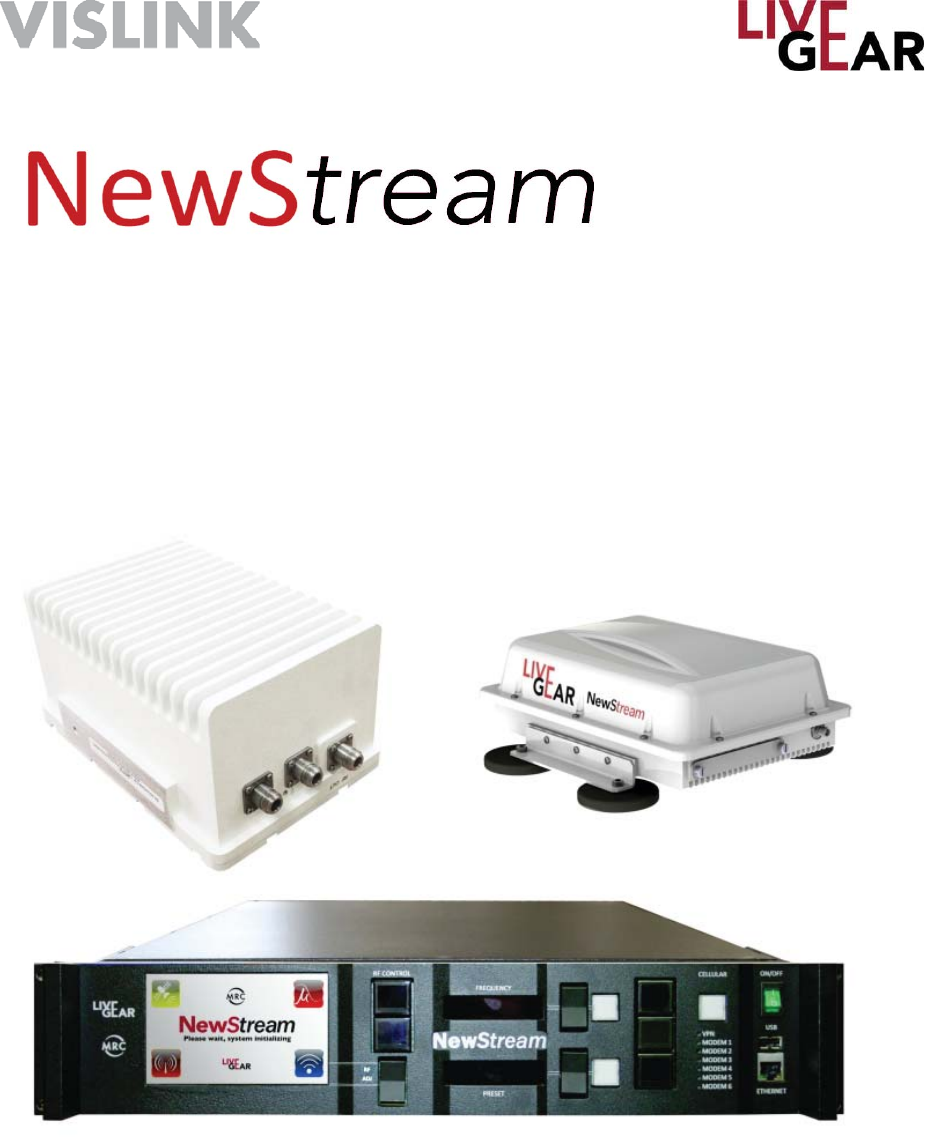
Multi-mode Mobile
Transmit System
User and Technical Manual
Manual Part No. RD001358 Rev. 004, February, 2015

Page 2
NewStream User Guide and Technical Manual
Copyright © 2015
Part number RD001358
Printed in U.S.A.
Authorized EU representative: Vislink PLC
Quality Certifi cation Vislink is certifi ed to ISO 9001:2008.
The Vislink trademark and other trademarks are registered trademarks in the United States and/or other countries.
Microsoft®, Windows®, and Internet Explorer® are registered trademarks of Microsoft Corporation in the United
States and/or other countries.
Proprietary Material The information and design contained within this manual was originated by and is the
property of Vislink. Vislink reserves all patent proprietary design, manufacturing, reproduction use, and sales rights
thereto, and to any articles disclosed therein, except to the extent rights are expressly granted to others. The
foregoing does not apply to vendor proprietary parts. Vislink has made every effort to ensure the accuracy of the
material contained in this manual at the time of printing. As specifi cations, equipment, and this manual are subject
to change without notice, Vislink assumes no responsibility or liability whatsoever for any errors or inaccuracies that
may appear in this manual or for any decisions based on its use. This manual is supplied for information purposes
only and should not be construed as a commitment by Vislink. The information in this manual remains the property
of Vislink and may not be used, disclosed, or reproduced in any form whatsoever, without the prior written consent of
Vislink. Vislink reserves the right to make changes to equipment and specifi cations of the product described in this
manual at any time without notice and without obligation to notify any person of such changes.
General Safety Information The following safety requirements, as well as local site requirements and regulations,
must be observed by personnel operating and maintaining the equipment covered by this manual to ensure
awareness of potential hazards. This equipment has been tested and found to comply with the limits for a Class
A digital device, pursuant to Part 15 of the FCC Rules. These limits are designed to provide reasonable protection
against harmful interference when the equipment is operated in a commercial environment. This equipment
generates, uses, and can radiate radio frequency energy. If not installed and used in accordance with the instruction
manual, it may cause harmful interference to radio communications. Operation of this equipment in a residential
area is likely to cause harmful interference in which case the user will be required to correct the interference at his
own expense.
A. The NewStream transmitter complies with Part 15 of the FCC Rules. Operation is subject to the following two
conditions:
[1] this device may not cause harmful interference, and [2] this device must accept any interference received,
including interference that may cause undesired operation.
About this Manual This manual is intended for use by qualifi ed operators, installers, and service personnel. Users
of this manual should already be familiar with basic concepts of radio, video, and audio. For information about
terms in this manual, see Glossary of Terms and Abbreviations [Part No. 400576-1]. Pay special attention to Notes,
Cautions, and Warnings.
Read NOTES for important information to assist you in using and maintaining the equipment
Follow CAUTIONS to prevent damage to the equipment.
Follow WARNINGS to prevent personal injury or death.

Page 3
NewStream User Guide and Technical Manual
Table of Contents
Introduction ........................................................................................7
Features ............................................................................................................... 8
System Description ..........................................................................10
Operational Modes ............................................................................................ 11
Operating Controls .............................................................................................13
Connections ......................................................................................................16
IDU Local Operation ........................................................................17
Changing Presets ..............................................................................................17
Preset Naming Using the Preset Display ......................................................18
Changing Channels ...........................................................................................19
USB Interface.....................................................................................................19
Ethernet Ports ....................................................................................................19
IDU Information Touchscreen ............................................................................20
IDU Information ..............................................................................................20
IDU Version .....................................................................................................21
Software Upgrade Process ................................................................................22
System Failure Recovery Process ....................................................................22
Preset Export and Import ...................................................................................23
Export Process ...............................................................................................23
Import Process ................................................................................................24
Local Microwave Control ...................................................................................26
ENG Status .....................................................................................................26
Local RF Control ................................................................................................27
ENG Mode ......................................................................................................27
SNG Mode ......................................................................................................27
ODU Selection for RF Bands ..........................................................................29
Local Antenna control ........................................................................................31
ENG Mode ......................................................................................................31
SNG Mode ......................................................................................................31
Alarms .............................................................................................................32
Confi guration Mode ........................................................................................33
Cellular [CNG] Operation ...................................................................................33
Confi guring Cellular Communications ...........................................................34
Initial CNG Setup ............................................................................................34
Steps to Stream Video in CNG Mode: ............................................................34
CNG Touchscreens .........................................................................................36
CNG Status .....................................................................................................37
NewStream Video Cellular Transmitter Data Usage .........................................38
Satellite [SNG] Operation ..................................................................................39
Touchscreen Display for SNG Operation .......................................................39
Power Level Selection ....................................................................................39
Frequency Selection .......................................................................................40
Frequency 16x2 Character Display ................................................................40
Power Rocker Switch ......................................................................................40

Page 4
NewStream User Guide and Technical Manual
SNG Information - Frequency Tune Mode - IDU Touchscreen Control .........41
SNG BUC Setup - Frequency Tune Mode - IDU Touchscreen Control .........42
SNG Information - Channel Plan Mode - IDU Touchscreen Control ..............43
Frequency Tuning Example With BUC Enabled ............................................44
SNG Status .....................................................................................................44
Steps to Stream Video in SNG Mode ................................................................45
IDU Touchscreen Last State Displayed .............................................................46
Common variables: .........................................................................................46
Microwave: ......................................................................................................46
Satellite: ..........................................................................................................46
Cellular: ...........................................................................................................46
IDU Touchscreen States on Startup or Preset Change .....................................46
Remote Operation Using the Web Interface ...................................47
Microwave Status Page ...................................................................48
Confi gure Preset ................................................................................................48
Current Preset....................................................................................................48
Radio Frequency Control ..................................................................................50
Encoding Status ................................................................................................51
Modulation Status ..............................................................................................52
Antenna Polarization Control .............................................................................53
Alarm Indicators .................................................................................................54
Cellular Status Page ........................................................................55
Cellular Card Information ...................................................................................56
Cellular Control ..................................................................................................56
Satellite Status Page .......................................................................60
Radio Frequency Control ..................................................................................61
Encoding Status ................................................................................................61
Frequency Control .............................................................................................63
Frequency .......................................................................................................64
Modulation Status ..............................................................................................65
Modify Presets Page .......................................................................66
Preset Confi guration ..........................................................................................68
Factory Default Presets .....................................................................................69
Default ENG Preset ..........................................................................................69
Encoder Settings ............................................................................................69
Modulation Settings .......................................................................................70
Cellular Settings .............................................................................................70
Modify Presets Setup Page .............................................................71
Modify Presets Encoder Settings ....................................................71
Modify Presets Encoder Settings ...................................................73
Video Settings ....................................................................................................73
Encoder Settings ...............................................................................................74
Encryption Settings ............................................................................................75
Transport Stream ...............................................................................................75
Audio Settings ....................................................................................................76
Wayside Data .....................................................................................................77
Modify Presets Modulation Settings ................................................78
Modulation Settings ...........................................................................................79
DVB-S2 Options .............................................................................................80

Page 5
NewStream User Guide and Technical Manual
Modify Presets Cellular Settings .....................................................81
Cellular ............................................................................................................... 81
Video .................................................................................................................83
Encoder ..............................................................................................................83
Transport Stream ...............................................................................................84
Audio .................................................................................................................. 85
Frequency Plans Page [CNG & ENG] .............................................86
Channels ............................................................................................................ 87
Confi guration Cloning .......................................................................................88
Saving Presets ...............................................................................................88
Loading ...........................................................................................................88
Frequency Plans Page [SNG] .........................................................88
Satellite Options .................................................................................................89
Channel Number [#] ...........................................................................................90
NewStream Settings Page ..............................................................91
General Settings ................................................................................................91
Network Confi guration .......................................................................................92
Manual Mode Pages .......................................................................94
License Manager Page ...................................................................95
Licensed Features .............................................................................................95
ENG Modulation Features ..............................................................................95
SNG Modulation Features [Upgrade Option] .................................................95
MPEG-2 Encoder Features ............................................................................95
Encryption Features ........................................................................................95
Input Features .................................................................................................95
H.264 Encoder Features ................................................................................95
Support Page ...................................................................................97
System Details ...................................................................................................98
NewStream System Information .....................................................................98
Cellular ODU [CODU] System Information .....................................................98
Support Information ........................................................................................98
Restore to Snapshot .......................................................................................98
Specifi cations ..................................................................................99
Appendix A: Microwave and Cellular ODU Confi gurations ..........100
Microwave ODU Wiring Harness .....................................................................100
Microwave ODU Connection Pinouts ..............................................................101
Legacy Microwave ODU Antenna Confi gurations ...........................................102
NewStream Microwave ODU Antenna Confi gurations ...................................104
Cellular ODU Connections ..............................................................................106
SIM Application Guide ..................................................................................106
SIM Installation Slots ....................................................................................108
Cellular ODU Mounting ....................................................................................108
Glossary .........................................................................................109
Notes ................................................................................................................ 119
Support for Your Vislink Product ....................................................120

Page 6
NewStream User Guide and Technical Manual
Safety Instructions
• Always use the correct power source during operation to avoid damaging the
product.
• Rough handling of the product may cause physical damage or malfunction.
• It is not recommended to use NewStream in harsh weather conditions or very low or
high temperatures.
• To ensure that the warranty remains valid, please do not disassemble the unit.
Internal Battery
The NewStream IDU contains one lithium coin battery for the maintenance of the time
and date function.
• This battery is rechargeable and should last the life of the NewStream.
• The battery is nonreplaceable. Contact the factory should you experience an issue
with the time and date functionality.
WARNING:
If you modify the product without authorization from Vislink, you will void the
warranty.
CAUTION:
Risk of explosion if battery is replaced by an incorrect type.
Dispose of used batteries properly.
Unpacking the NewStream Transmitter
Before you install your new equipment, carefully unpack your new equipment to avoid
accidental damage.
• Locate all parts and accessories and verify that they are listed on the packing list.
DO NOT discard the container or packing material until you have inspected the
equipment and are sure there is no shipping damage. The container and pack-
ing must be available in case you need to fi le a damage claim with the shipping
carrier.
• Inspect the equipment for damage and ensure that it is clean and dry.
• Inspect the cables, connectors, switches, and displays to ensure that they are not
broken, damaged or loose.
If you discover damage after unpacking the system, report the damage as follows:
• Immediately fi le a claim with the shipping carrier.
• Forward a copy of the damage report to Vislink Customer Service.
• Contact Vislink Customer Service to determine the disposition of the equipment.
Refer to the section on the last pages: Support for Your Vislink Product.
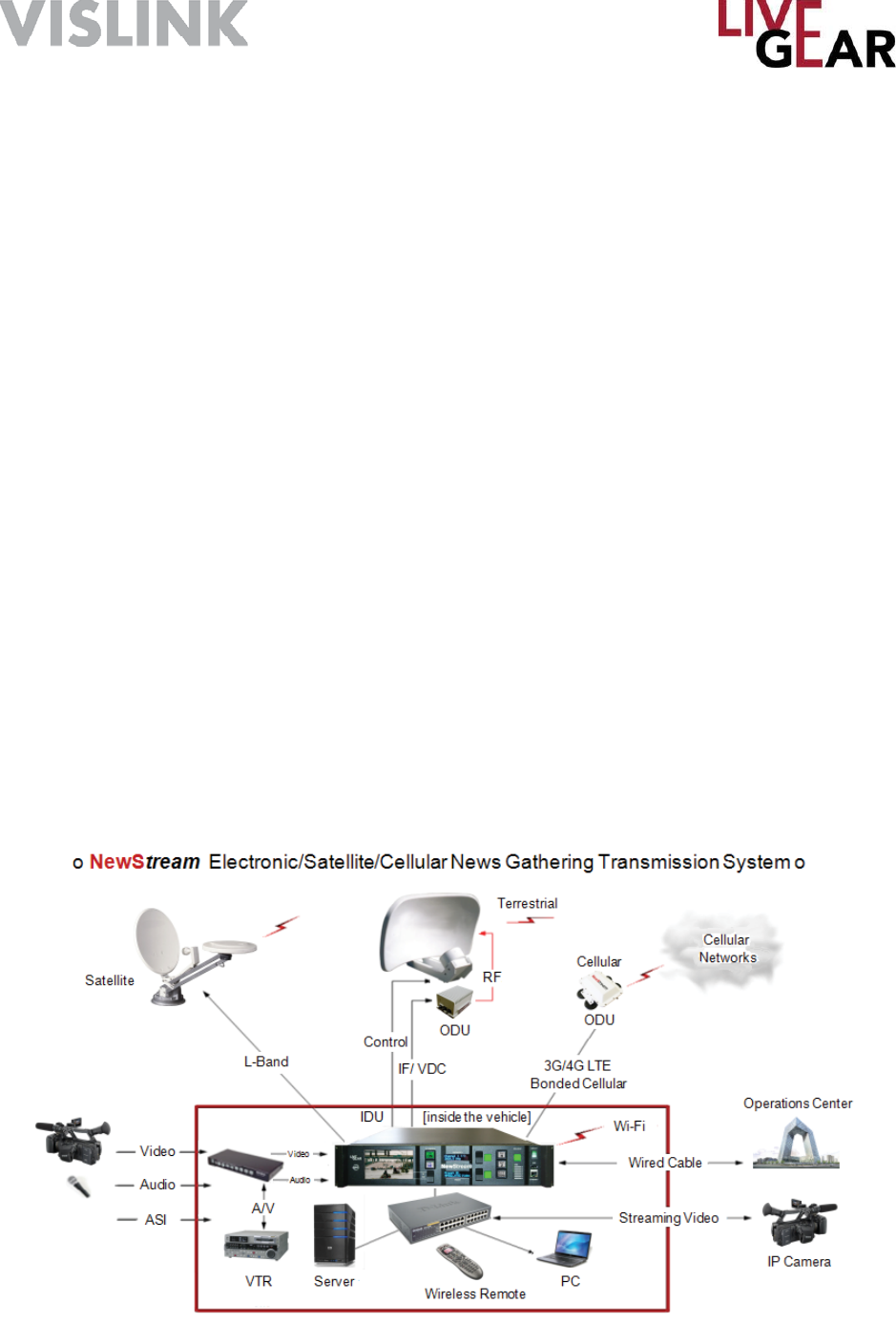
Page 7
AirStream User Guide and Technical Manual
Introduction
NewStream is a rack-mounted microwave van transmit system designed to combine
transmission technologies into a single 2 RU chassis platform. It is designed to make
the gathering and transmission of news events a seamless and comprehensible task.
NewStream offers multi-mode operations which can include:
• ENG [Electronic News Gathering]
• SNG [Satellite News Gathering (Upgrade Option)]
• CNG [Cellular News Gathering (Upgrade Option)]
The LiveGear Receiver [LGR-1000] is a playout device that receives NewStream IP
transmissions via the Internet and provides an HD/SD-SDI output. Up to six New-
Stream transmitters can be received simultaneously using one LiveGear Receiver.
You can also use the VMS-1100 video media server to transcode the IP transport
stream from the LiveGear Receiver for delivery to laptops, desktops, smartphones and
tablets.
Advanced Vislink algorithms provide effi cient, robust, and persistent video transmissions
of unmatched quality. NewStream aggregates multiple 3G/4G LTE cellular channels
and optimizes data throughput. This mobile unit delivers consistently smooth and
dependable pictures and sound despite the occasional cellular traffi c surge or spotty
signal.
Leading-edge H.264 adaptive bitrate encoding technology provides remarkable video
resolution with minimal latency. NewStream transmits at approximately half of the data
rate required by MPEG-2 based systems. Lost or stalled data packets are seamlessly
compensated for with Vislink’s exclusive predictive forward error correction algorithms.
This feature provides unparalleled signal integrity throughout your entire event
coverage.
Figure 1: NewStream Functional Diagram

Page 8
NewStream User Guide and Technical Manual
Features
The award-winning NewStream system offers multi-mode operation which can
include:
• ENG [Electronic News Gathering]
• SNG [Satellite News Gathering]
• CNG [Cellular News Gathering]
Transmission Integrity – Consistent Microwave, Cellular and Satellite
transmission is possible using the NewStream system. Multiple aggregated
3G/4G LTE internal modems are optimized to provide regulated and consistent
video transmission data throughput. NewStream utilizes up to six cellular
modems to improve persistence and network diversity. Service providers may
be mixed and matched to provide optimum network performance according
to regional network coverage. Data rates for each modem channel are
continuously adapted to meet the real-time network transfer rate. An additional
modem provides Internet connectivity to communicate across all active
modems.
Video Quality – Effi cient adaptive bit rate algorithms maximize video data
throughput producing remarkable video resolution with minimal latency in the
presence of dynamic cellular network fl uctuations.
HD/SD Broadcast Video Quality: User - selectable MPEG-2 4:2:2/4:2:0 [ENG/
SNG] or H.264 [AVC] 4:2:0 [CNG] encoding profi les. Video Inputs for the
NewStream system include composite and HD/SD-SDI video.
Reliability – Using wireless 3G/4G LTE cellular, Wi-Fi satellite backhaul
communication infrastructures, NewStream delivers video/audio signals when
and where you want them.
Power Capabilities – NewStream can operate continuously using your van’s
DC-to-AC inverter outlet.
Confi guration Options – Use a laptop with an Internet connection to confi gure
NewStream from its Web interface. Wireless confi guration is possible using a
PC, tablet or smartphone when the NewStream IDU is connected to a wireless
access point.
Incorporates dual mode ENG/SNG [upgrade option]: DVB-S and DVB-S2
modulation with 10 MHz high stability reference crystal oscillator.
Common Multi-mode Modulator and Encoder
Simplifi ed User Interface: Ergonomic programmable multi-function OLED
pushbutton switches minimize front panel controller congestions.
Cost effective, space saving, comprehensive multi-purpose outside
broadcasting microwave transmission system.
Incorporates leading-edge wireless technologies
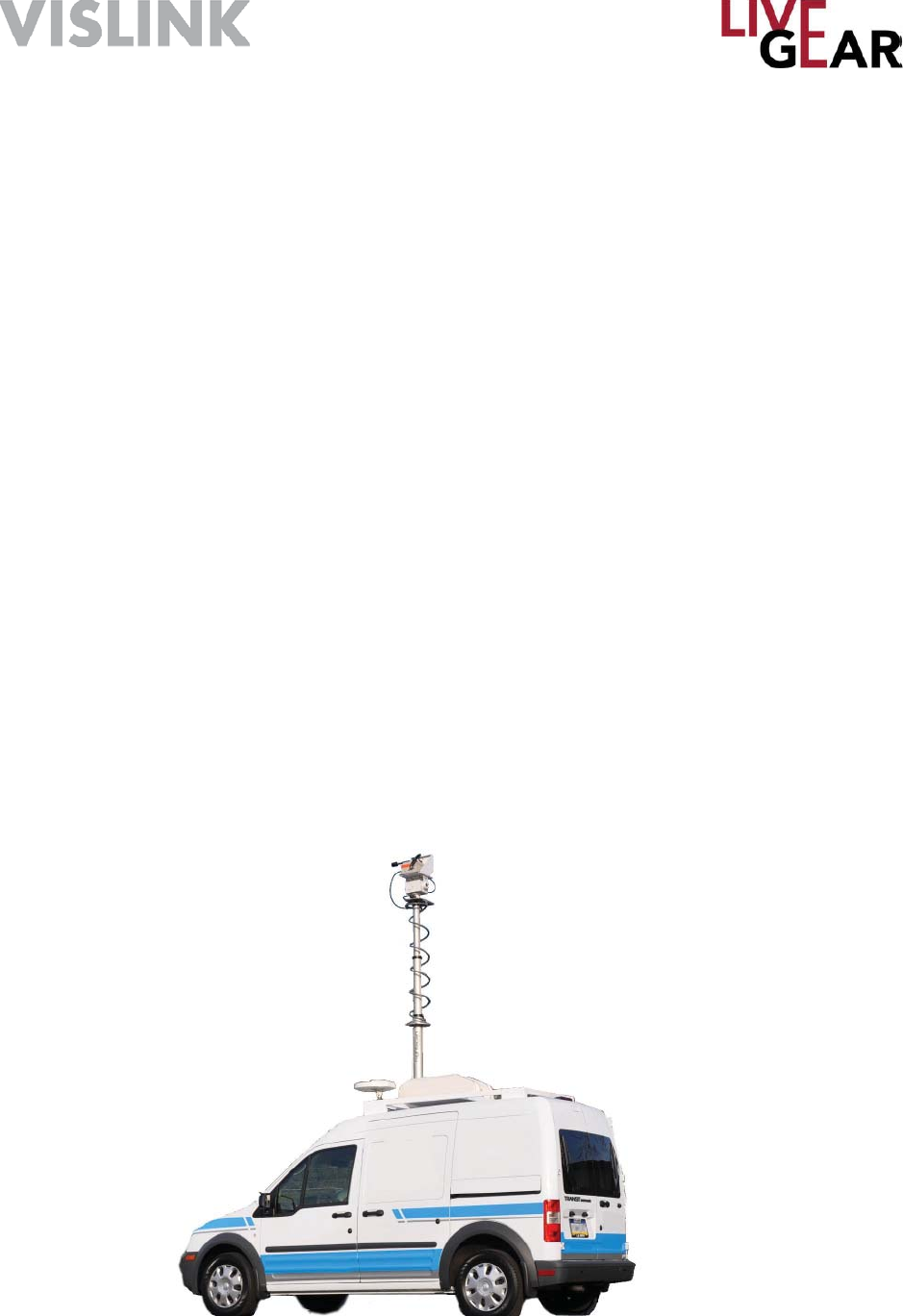
Page 9
NewStream User Guide and Technical Manual
Features [continued]
Compact, space-effi cient 2RU x 19” EIA all-inclusive rack mount design for
ENG, CNG and SNG control [CNG and SNG are Upgrade Options].
Preserves legacy BAS ENG Van Transmission functionality: the NewStream
system allows use of existing ENG Nycoil Assemblies confi gured for Type N,
TNC or Triax connections.
Space Effi cient ENG ODU: 2, 4, 7, 13, 2/7 GHz mast-mounted single enclosure
with built-in RF coaxial relay for omni-directional antenna selection.
Broadband Cellular ODU: Lightweight mast or roof-mounted cellular ODU
equipped with multiple bonded cellular modems and integral high-gain
broadband cellular antennas.
ENG Encoding: MPEG-2, H.264 HD/SD, 4:2:2/4:2:0
CNG Encoding: H.264 AVC high-profi le @ level 4.1 adaptive bit-rate coding
[ABR] encoding. [Upgrade Option]
SNG Encoding: MPEG-2, H.264 HD/SD, 4:2:2/4:2:0 [Upgrade Option]
ENG Modulation: COFDM [DVB-T]
CNG Modulation: COFDMA, CDMA
SNG Modulation: DVB-S QPSK, DVB-S2
Audio: Four embedded SDI MPEG-2 layer II and two Analog stereo pairs
Access – The VMS-1100 base system transcodes and streams out to multiple-
edged viewing devices such as smartphones, tablets and laptop computers.
Figure 2: NewStream Outdoor Unit Application
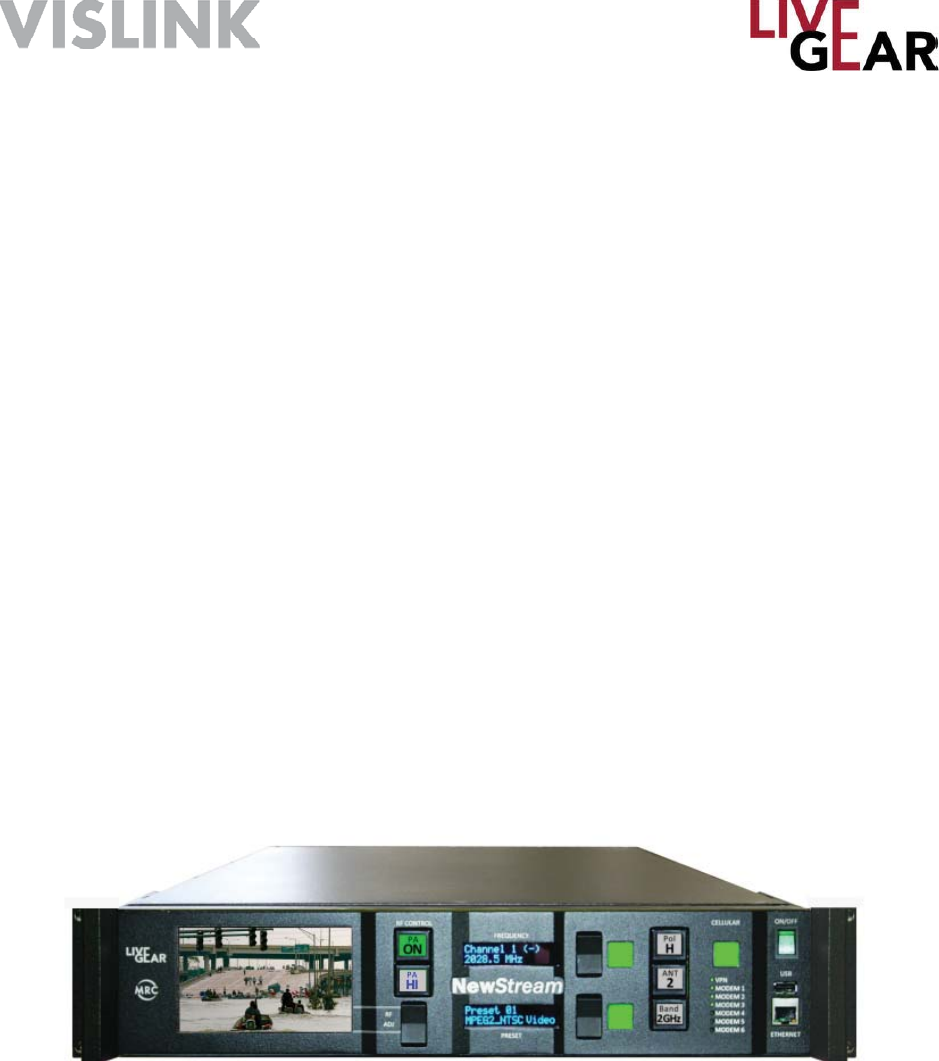
Page 10
NewStream User Guide and Technical Manual
System Description
The NewStream compact video transmitter system provides reliable and fl exible
microwave modulation, Cellular/Wi-Fi and MPEG2,/H.264 encoding functions. The
NewStream system includes an Indoor Unit [IDU] consisting of the 19-inch wide, 2-rack
unit [2RU] high, rack-mounted transmitter, as shown in Figure 3, and a mast-mounted
Microwave Outdoor Unit [ODU] or RF Unit [RFU]. The ODU is also known as an RF
head and/or Cellular Outdoor Unit [C-ODU] on-roof mounted units.
The NewStream IDU is typically mounted in a standard 19-inch [48.3 cm] rack for
mobile installations and the ODU is mounted on an antenna mast. The IDU contains the
baseband circuitry, power supply and control modules. It accepts a wide variety of audio
and video inputs, both analog and digital and generates a 70 MHz IF for legacy heads
and 950 MHz IF for NewStream heads.
The IDU can be locally controlled from its front panel or remotely from a PC, tablet or
smartphone over an IP connection using the NewStream’s Web browser graphical user
interface [GUI].
The IDU directs overall system control such as video encoding, modulation and power
distribution. The NewStream transmitter supports Cellular video streaming, MPEG2 HD
and SD encoding, H.264 HD/SD encoding, AES/EBU and Analog audio, ASI input and
output, as well as various modulations and rates.
Figure 3: NewStream Indoor Unit
The NewStream transmitter system [ENG] supports both single and dual band
operation. The IDU can interact with legacy MTX ODUs or new improved performance
NewStream ODUs which can be single or dual band in the same ODU housing.
NewStream is a video transmission system with digital modulation capabilities which
provides a sophisticated user interface with an adjustable color LCD display panel
with touch screen control. An analogous Web interface enables remote control of the
system.

Page 11
NewStream User Guide and Technical Manual
A fully equipped NewStream system is High Defi nition-ready and provides a robust
HD link from the fi eld to the studio with several digital video input formats accepted. In
addition, NewStream accepts analog audio inputs.
NewStream ODUs can be single or dual band confi gurations and come in many
different RF bands. These ODUs contain integrated RF up-conversion circuitry and
high power RF amplifi ers for maximum power and signal quality. With the new demands
for digital modulation, the ODUs have been optimized for improved Modulation Error
Ratio/Error Vector Magnitude [MER/EVM] performance with COFDM transmission.
Operational Modes
The following NewStream IDU and ODU I/O connections are available:
o Video and Audio:
• HD/SD SDI video input. One dedicated BNC connector.
• Analog composite video input. One dedicated BNC connector.
• AES/EBU Audio input. Two AES/EBU channels supported through DB25
connector.
• Analog Audio input. Two analog stereo pairs supported through DB25 connector.
• Unbalanced 75 Ohm audio input. One AES audio supported through DB25
connector.
o Transport Stream:
• ASI Transport Stream MPEG2 format input. One dedicated BNC connector.
o Data Interfaces:
• USB interface. One USB connector on system front.
• Ethernet interfaces. Total of three Ethernet RJ-45 connectors.
• Serial interface. Two serial inputs/outputs supported through DB9 connector; one
DB15 serial connector exclusively for Wayside Data.
o ODU to IDU interfaces [one each]:
• Ethernet Interface via Multimedia over Coax Alliance [MoCA] RF interfaces.
• ODU 1 port provides either 950 MHz or 70 MHz depending on type of ODU
[i.e. legacy or NewStream].
• ODU 2 port provides 70 MHz for legacy ODU when dual band legacy ODUs
are in use. Note that legacy and NewStream ODUs cannot be connected
simultaneously.
• Satellite Device attached to L-Band out
• Test Loopback device attached to L-Band Monitor
• Cellular ODU attached to Cellular ODU port
NOTE: Features not implemented in the version that you have purchased are listed
as upgrade options. Contact your Vislink representative for more information.
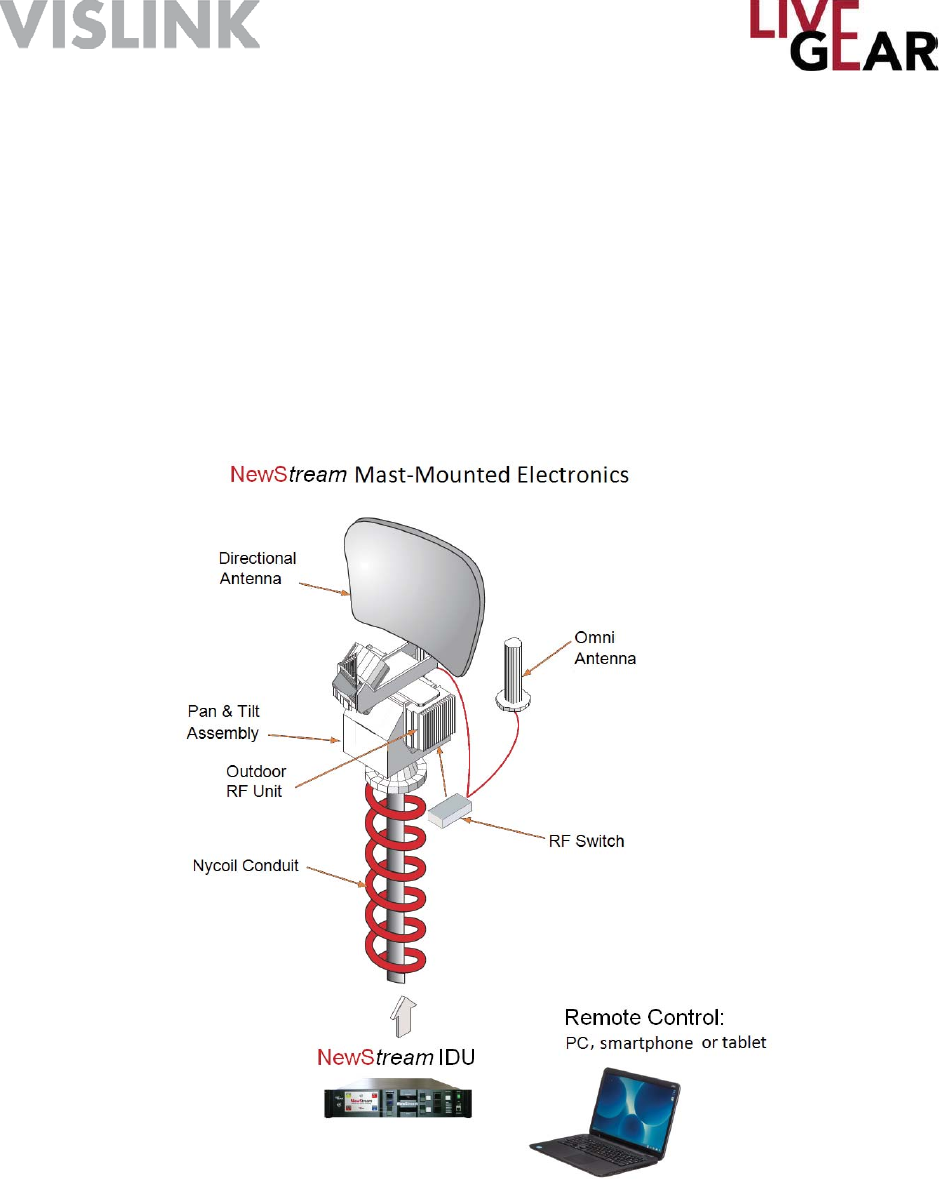
Page 12
NewStream User Guide and Technical Manual
The ODU shown in Figure 4, performs the signal up-conversion from 70 MHz IF to RF
[2 GHz or 7 GHz] and provides signal amplifi cation, as required.
The NewStream IDU is typically mounted in a standard 19-inch [48.3 cm] rack for
mobile installations and the ODU is mounted on an antenna mast. The IDU contains the
baseband circuitry, power supply and control modules. It accepts a wide variety of audio
and video inputs, both analog and digital and generates a 70 MHz IF output from the
rear panel and 70 MHz IF for control of a legacy ODU. The IDU also accepts ASI from
external encoders.
Figure 4: NewStream System Components
The IDU can be controlled locally from the front panel controls or it can be controlled
remotely. The IDU can be controlled from a PC at a remote location, such as a studio,
via the Google Chrome Web browser. A PC, tablet or smartphone can also be used to
provide remote control of the IDU during mobile operations.
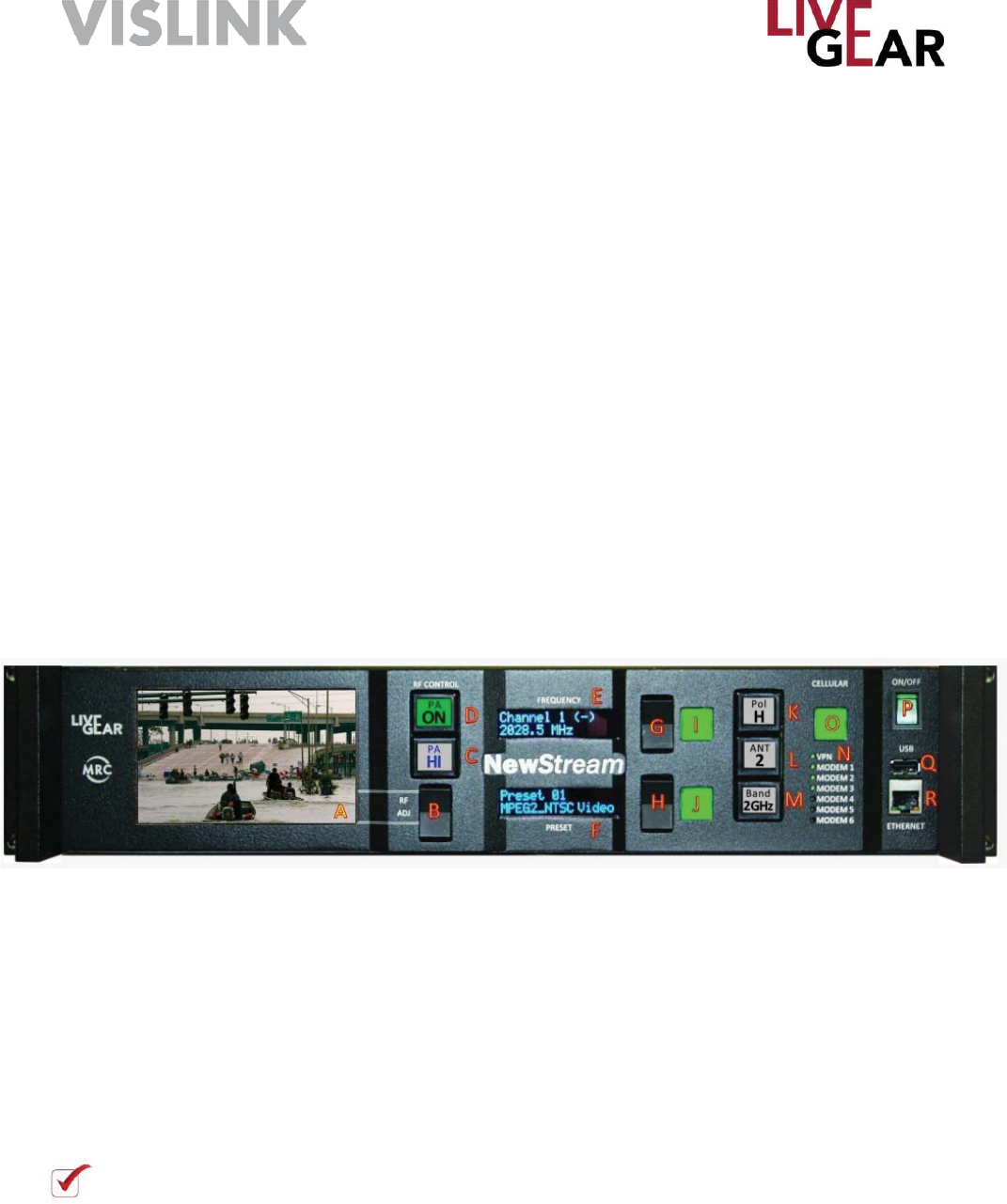
Page 13
NewStream User Guide and Technical Manual
All installations include an antenna, either directional, omni-directional or both. A legacy
Vislink RF switch can used on the antenna mast to select the antenna required or a
built-in RF switch when using NewStream ODUs can also be used. Antenna feed power
and control is available at the ODU via an 8 pin circular connector.
When using the mast-mounted antenna[s], a Nycoil conduit sheath covers the wiring
harness between the IDU and the ODU, as shown in Figure 4. The wiring harness
carries the DC power, IF control, and antenna band and polarization switching control.
Additional wiring is contained in the Nycoil conduit sheath for controlling the antenna
pan and tilt mechanism and for implementing additional functions such as off-air
monitors, mast lights, etc.
Operating Controls
All controls are located on the front panel of the NewStream IDU. Transmitter functions
are controlled using the OLED buttons and switches, as shown in Figure 5. The Liquid
Crystal Display [LCD] touchscreen controls Remote/Local control, fi rmware upgrades
and IP addressing of the IDU.
Figure 5: NewStream IDU Front Panel Operating Controls
The LCD with touch screen, buttons and function keys are used to select control and
diagnostic menu screens for both the IDU and the ODU. Option buttons displayed on
the LCD are used to control Preset selection, RF band selection, channel selection,
antenna selection, antenna polarization, transmitter operation, power [low, high or
adjustable], and to monitor the status of the IDU and ODU. The option buttons displayed
on the LCD may be selected using either the color LCD display panel touch screen or
the function keys. Table 1 lists the functions and displays of the controls.
NOTE: When the IDU is shut down all the component variables are saved at the last
state with which the IDU was confi gured. The exceptions to this are the following
states: Microwave Power Amplifi er, Satellite RF Carrier and Cellular Cell Transmit
which always default to Off on IDU powerup.
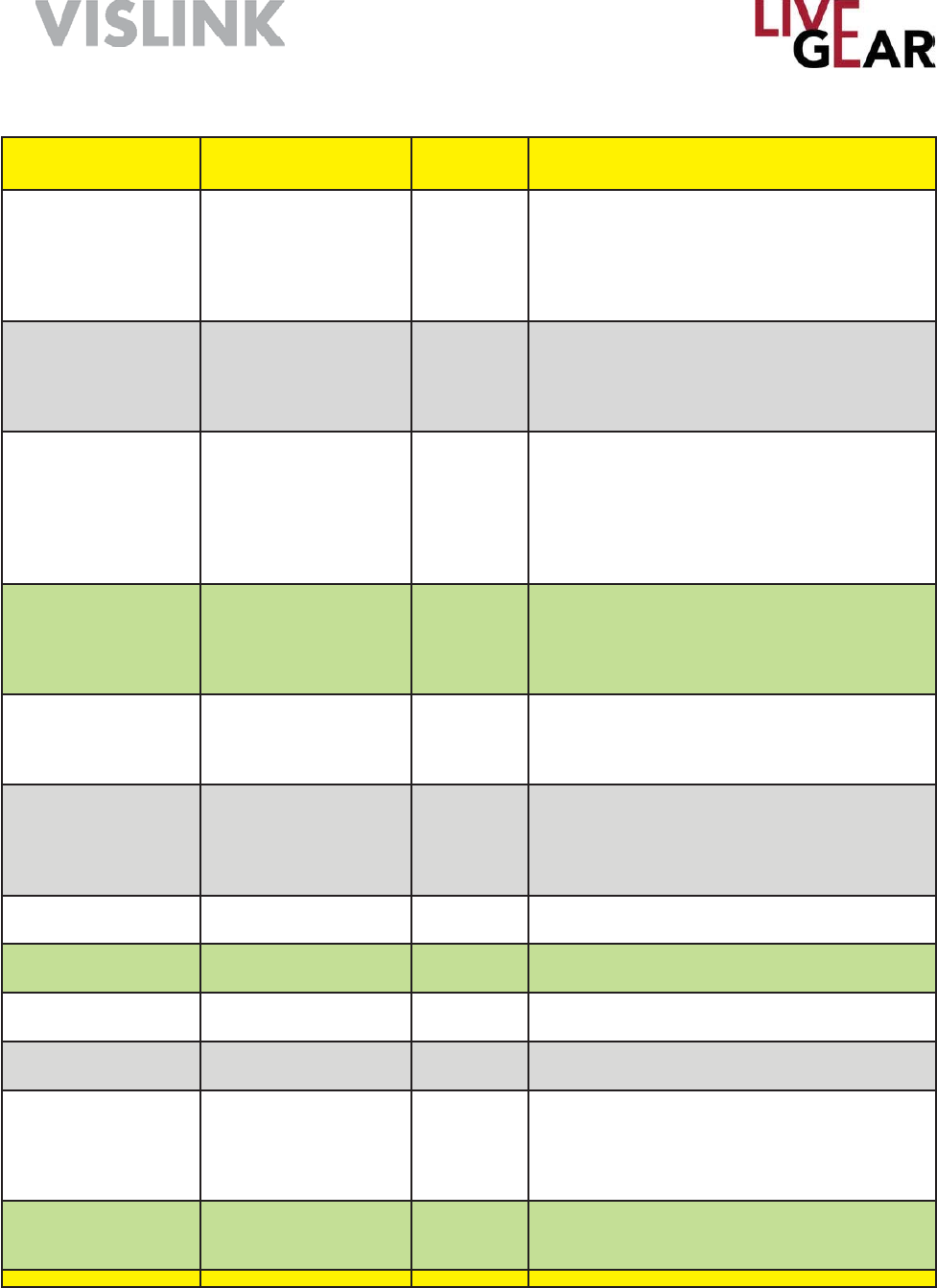
Page 14
NewStream User Guide and Technical Manual
Control/
Connection Type Button
Text Functions
A: Liquid Crystal
Display
Capacitive Touch TFT
5 in. [diag.] display n/a
This LCD displays:
• confi dence video monitor;
• alarm & status information;
• microwave & satellite RF Power readout;
• setup screens to confi gure IP address, local /
remote mode and fi rmware updates
B: RF Power Adjust Rocker Switch n/a
The Microwave Mode rocker switch allows:
• adjustment of Radio Frequency Power up &
down.
The Satellite Mode rocker switch allows:
• adjustment of L-Band Power up & down.
C: Microwave/
Satellite Switch
OLED Multi-function
Pushbutton Switch
PA HI
PA LOW
MOD ON
MOD OFF
The Microwave button allows:
• setting of RF Power to High, Low
• indicates PA ADJ [i.e. ADJ = Adjustable]
mode.
The Satellite Mode button allows:
• setting of state change of Modulation to on
or off.
D: Microwave/
Satellite Switch
OLED Multi-function
Pushbutton Switch
PA ON
PA OFF
CW ON
CW OFF
The Microwave Mode button allows:
• setting of Power Amplifi er to on or off.
The Satellite Mode button allows:
• setting of RF Carrier on or off.
E: Frequency Display 16x2 OLED Display n/a
The FREQUENCY display shows:
• active frequency & channel number;
• allows scrolling through pre-stored frequency
& channel plan [using rocker switch G].
F: Preset Display 16x2 OLED Display n/a
The PRESET display shows:
• active preset name & number and operating
mode;
• allows scrolling through pre-stored presets or
operating modes [using rocker switch H].
G: Frequency
Selection Rocker Switch n/a This switch allows scrolling through a pre-stored
frequency & channel plan.
H: Preset Selection Rocker Switch n/a This switch allows scrolling through pre-stored
presets or operating modes
I: Enter Frequency Illuminated Pushbutton
Enter Switch n/a This button provides a means to select a new
frequency.
J: Enter Preset Illuminated Pushbutton
Enter Switch n/a This button provides a means to select a new
preset value.
K: Antenna Polarity
Selection Switch
OLED Multi-function
Pushbutton Switch
Pol V
Pol H
Pol RC
Pol LC
The Antenna Polarity [Pol] selection button:
• V - sets Vertical Antenna Polarity;
• H - sets Horizontal Antenna Polarity;
• RC - sets Right Circular Antenna Polarity;
• LC - sets Left Circular Antenna Polarity.
L: Antenna Selection
Switch
OLED Multi-function
Pushbutton Switch
ANT 1
ANT 2
The Antenna selection button:
• ANT 1 - selects Antenna 1;
• ANT 2 - selects Antenna 2.
Table 1: NewStream Front Panel Operating Controls & Connections
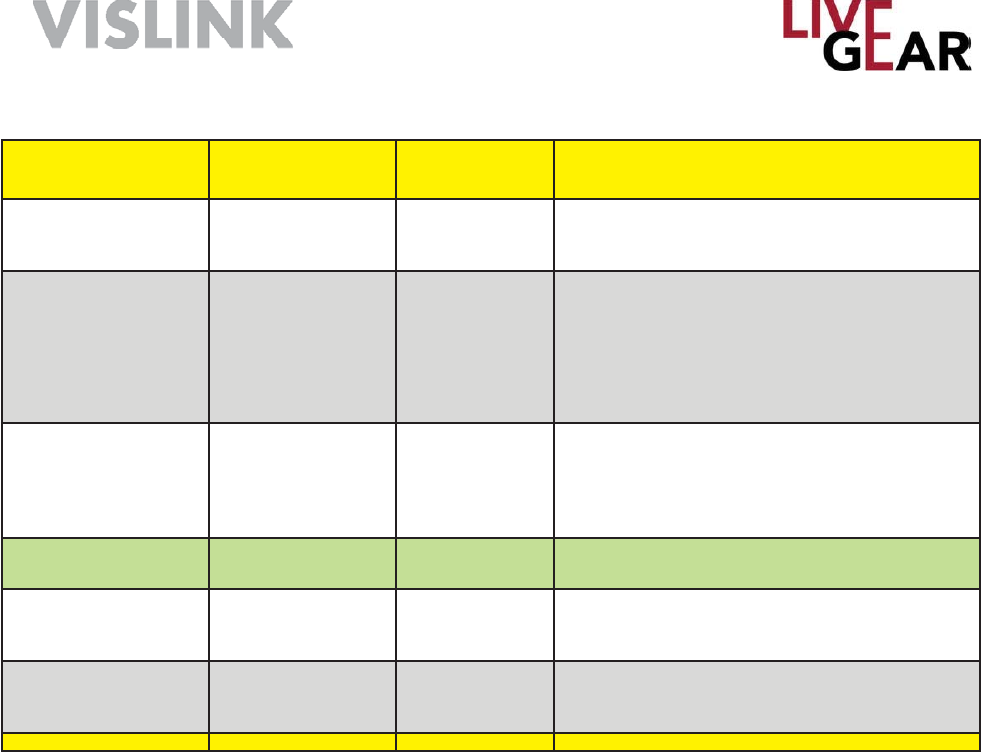
Page 15
NewStream User Guide and Technical Manual
Control/
Connection Type Button
Text Functions
M: RF Band
Selection Switch
OLED Multi-
function
Pushbutton Switch
Indicates the
current band
The RF Band selection button:
This band depends upon the type of ODU that is
connected.
N: Cellular Control LED Indicators n/a
These indicators display the status of the
transmission strength of the six cellular modems.
The LEDs are lit:
• green to indicate LTE/4G cellular
transmission, which is the optimum;
O: Start or Stop
Cellular Transmission
Illuminated
Pushbutton Enter
Switch
n/a
This button provides a means to start or stop
cellular transmission. This button also indicates:
• when lit - Cellular modems are transmitting &
• when unlit - Cellular modems are in stand-by
mode.
P: ON/OFF: Rocker Style
Power Switch n/a This button applies or removes power to the
NewStream transmitter.
Q: ETHERNET Port Ethernet
connection plug n/a
This port provides a connection to access a Web
browser via a PC or mobile device for setup
control & monitoring.
R: USB Port USB connection
plug n/a
The USB Connector provides a connection to
upgrade system fi rmware.
Table 1: NewStream Operating Controls & Connections [continued]
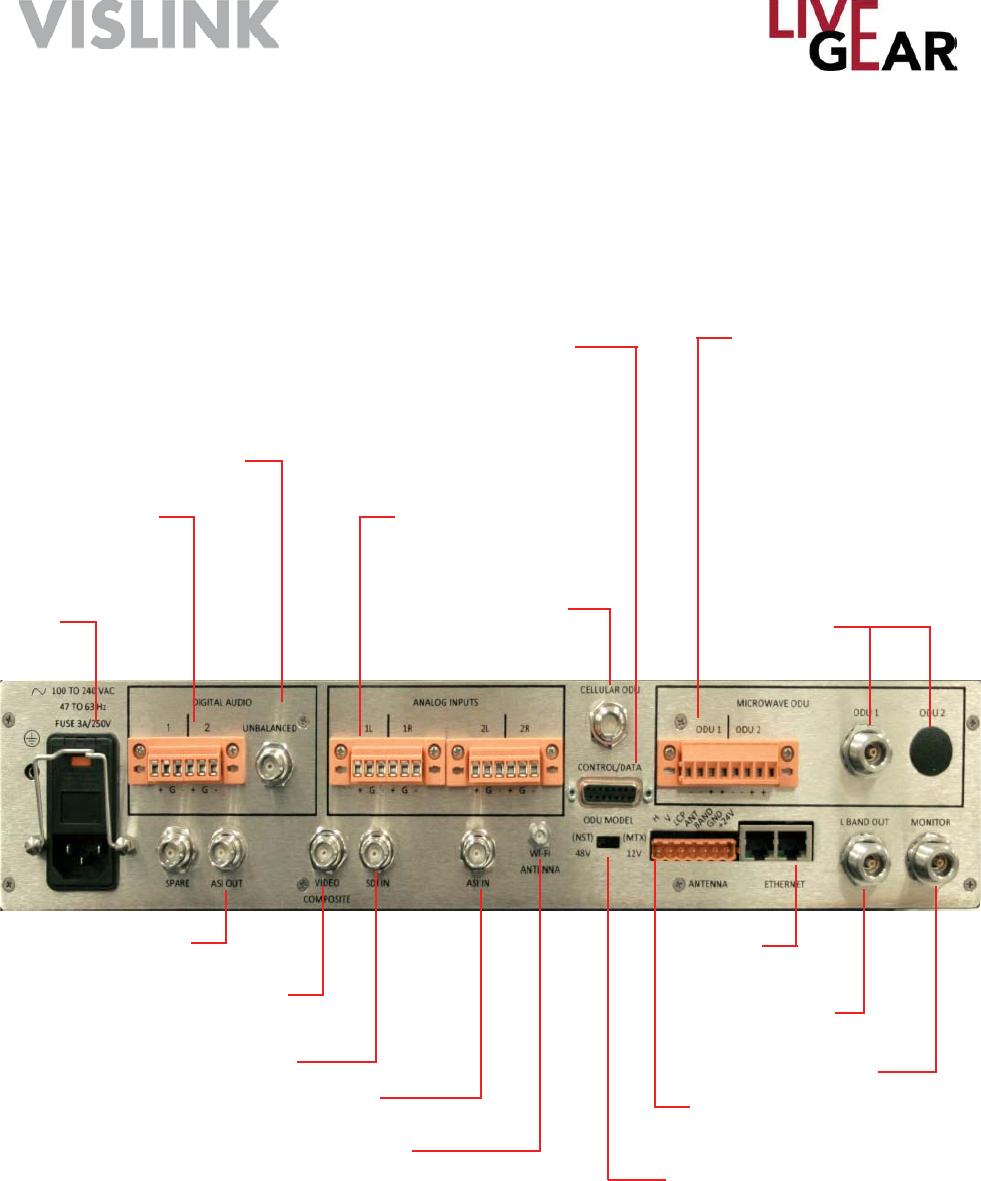
Page 16
NewStream User Guide and Technical Manual
Ethernet
I/O
ASI Input
Composite Video
Digital Audio
Balanced
SD or HD SDI Input
Cellular
ODU I/O
Analog Audio
Inputs
Antenna Polarization
Control
Connections
Connections to the NewStream transmitter are shown in the illustration below. The
Video input BNC connector, external antenna, power switch and SIM slots are located
on the right side of NewStream.
Control Data
Serial Port
Unbalanced
Microwave
ODU Voltage
Microwave ODU1 IF
Output [NewStream
ODU or 1st legacy MTX
ODU]
Microwave ODU2 IF
Output [2nd legacy
MTX ODU]
L-Band Out - to
SNG equipment
ASI Output
Wi-Fi SMA [future option]
AC Power Supply
Input & Circuit
Breaker
Figure 6: NewStream IDU Rear Panel Connections/Controls
L-Band Monitor
ODU Model - Do not
switch until ODUs
are powered down -
see Warning in ODU
Selection for RF Bands
section.

Page 17
NewStream User Guide and Technical Manual
IDU Local Operation
The NewStream IDU front panel provides monitoring and control of the entire system.
The Liquid Crystal Display [LCD] touchscreen provides menu screens for the set-up,
control and diagnostic status of both the IDU and ODU [see Figure 5 item A]. The LCD
also provides a preview monitor of the source video that is being transmitted by ENG,
SNG or CNG. If you are not in a sub-menu, the preview video is displayed. If there is
no video feed, the screen is blank. To change the control from Remote to Local, use the
Confi guration Mode touchscreen, and example of which is shown in Figure 20.
In addition to the main control LCD there are presets and frequency displays where
current preset mode and operation frequency are presented. Dedicated Organic Light-
Emitting Diode [OLED] buttons, rocker switches and lighted Enter buttons allow for
modifi cation of preset and frequency [see Figure 5 items E, F, G, H, I and J].
You can interact with the system via the touchscreen display or through function keys.
The front panel control display can be used for local control. The Web interface also
allows remote control of NewStream. Local control is preferred by operators who do not
want others to reconfi gure NewStream while they are controlling it; the LCD provides a
means to set local control. You can always use the Web interface to access information
and to determine status of NewStream, even when the operator has the IDU in local
mode. The Web interface is available for control of NewStream only when it has been set
to remote control by the local operator.
For quick system setup, dedicated controls exist on the front panel such as: preset
selection, operating frequency selection and ODU controls. When you press the On/
Off button on the front of NewStream [see Figure 5 item P], NewStream begins the
boot up process. This process starts with the On/Off button illuminating green and the
touchscreen displaying a Vislink logo. The start up time is approximately 40-45 seconds.
Once NewStream is fully booted up, the touchscreen displays the video preview, as well
as the status indicators. The OLED buttons and 16x2 Frequency and Preset indicators
[see Figure 5 items E and F] display the last state confi gured, except for the buttons
that control RF power, which are automatically set to Off upon applying power to the
transmitter, and for any major operational change to the system including preset change,
frequency change, and band change.
Changing Presets
There are three factory installed presets that you can use to begin operating NewStream.
The 16x2 Preset display [see Figure 5 item F] allows you to scroll through the list of
loaded presets via the rocker switch [see Figure 5 item H]. The rocker switch always
increments the preset number. If you continue to press the switch to the end of the list in
one direction, the list wraps around and starts again as you continue pressing the rocker
switch. As you scroll through the preset list and select a valid preset, by pressing the
Set Preset [Enter] indicator button [see Figure 5 item J], the Enter button begins blinking
amber. If an invalid preset is selected due, for instance, to not having the proper modules
or license installed in NewStream, then the Set Preset Enter button is lit red.

Page 18
NewStream User Guide and Technical Manual
When you locate the preset that you want to load, press the blinking Enter Preset
button [Figure 5 item J]. This action automatically turns off any NewStream RF
transmitting device [for example: PA On, Carrier On or Cellular On]. The Enter button
will not be illuminated indicating that the NewStream operating system has begun
loading the selected preset. Once the preset has been loaded, the Enter button is lit
green, indicating that the preset is operating normally. The 16x2 Preset display also
shows the preset that you have selected. Note that the preset loading state may last
ten or more seconds if you are switching from one operating mode to another [for
example ENG to SNG].
The top line of the Preset 16x2 display presents PRESET, the preset’s number [1-99]
and the mode of operation. The second line displays The name that you have assigned
it up to 16 characters. If the name is greater than 16 characters, the display will scroll
through the entire name and then revert back to the fi rst 16 characters, providing the
ability to ensure that the correct preset has been selected.
Preset Naming Using the Preset Display
• ENG and SNG cannot be used at the same time therefore only one active ENG
or SNG preset is valid.
• CNG mode can be used simultaneously with ENG / SNG or independently.
• Each preset name displays a prefi x of one of the following types:
o ENG – indicating microwave preset capability
o SNG – indicating satellite preset capability
o CNG – indicating cellular preset capability
o ENG/CNG – indicating simultaneous microwave and cellular operation
o SNG/CNG – indicating simultaneous satellite and cellular operation
o MANUAL – indicates that NewStream is not operating in a preset mode.
Manual mode can be employed when an operator wants to test a setting without
modifying an existing preset.
Preset names can be duplicated in the radio, however NewStream differentiates presets
by the index number. It is not recommended to duplicate preset names since it can
cause issues with preset reordering. Up to 99 presets can be saved on NewStream.
The fi rst line of the character display shows one of the 6 preset prefi xes followed by the
preset number. If the mode is manual, then the preset number is not displayed. The
second line of the character display shows the preset name, or it shows No Preset if
you are in Manual Mode.

Page 19
Changing Channels
The 16x2 Frequency display presents the current Channel number on the top line,
as well as the frequency of the channel on the bottom line [see Figure 5 item E]. The
available Channel selection depends on the type of ODU and preset selected [ENG vs
SNG]. Refer to the Change ODU [RF Bands] section to learn how frequency bands are
selected, and Change Preset to determine how presets are changed.
You can scroll through the available channels in this frequency mapping for this particular
frequency and ENG or SNG mode via the rocker switch [see Figure 5 item G]. The
rocker increments the channel number. If you press the rocker switch until the end of the
list in one direction, the list starts again. The Enter channel button will blink amber when
viewing a channel that is different from the currently active channel.
Press the blinking Enter Channel button when you locate the desired channel [see
Figure 5 item I]. This will automatically turn off any RF transmitting device in NewStream
[PA on, Carrier on or Cellular On]. The button is lit green to indicate that NewStream
accepted the state change and is operating correctly. The 16x2 Frequency display
presents a message: Channel Loading on the fi rst line and Please Wait on the second
line.
Once the channel has been loaded, the amber button is lit green. The 16x2 Frequency
display presents the channel that you selected. Should the channel not be set, the Enter
channel button will blink red for 5 seconds and then stays red and an alarm will indicate
that there was a problem with the channel selection.
USB Interface
The USB interface [see Figure 5 item Q] provides a connection to upgrade system
fi rmware. Refer to Software Upgrade Process for more information. You have the option
of recovering your NewStream system using the USB port to activate System Failure
Recovery. See the System Failure Recovery Process for details. You may also use this
port to export presets. Refer to Modify Presets for more details.
Ethernet Ports
The Ethernet ports provide to access a Web browser via a PC [or mobile devices] for
setup control and monitoring [see Figure 5 item R and Figure 6 (Ethernet I/O)]. There is
an RJ-45 port on the front panel and two RJ-45 Ethernet connectors on the rear. Any of
these three RJ-45 connections can be used to access NewStream’s Web interface.
NewStream User Guide and Technical Manual
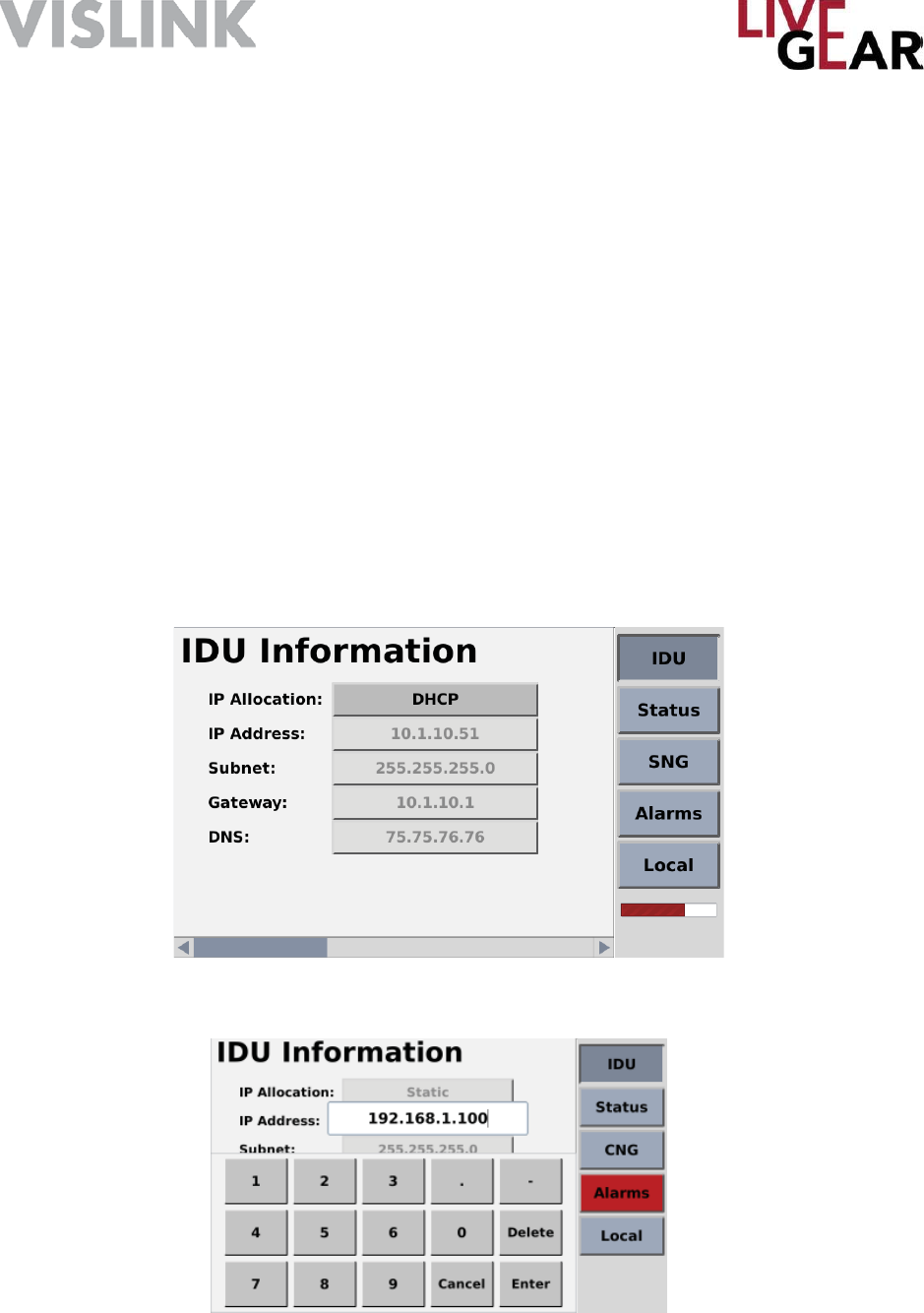
Page 20
NewStream User Guide and Technical Manual
IDU Information Touchscreen
IDU Information
The IDU Network Settings touchscreen displays the following information:
• IP Allocation [Static or Dynamic]
• IP Address
• Subnet
• Gateway
• DNS
For further information about the listed settings, refer to the NewStream Settings Web
interface section. Refer below to Figure 7 for the IDU Network Information and the
Numeric Entry Pad that appears when you press the entry fi elds. Swipe to the right on
the touchscreen to display the IDU Version screen.
Figure 7: NewStream IDU Information Touchscreen - Network Settings & Numeric Entry Pad
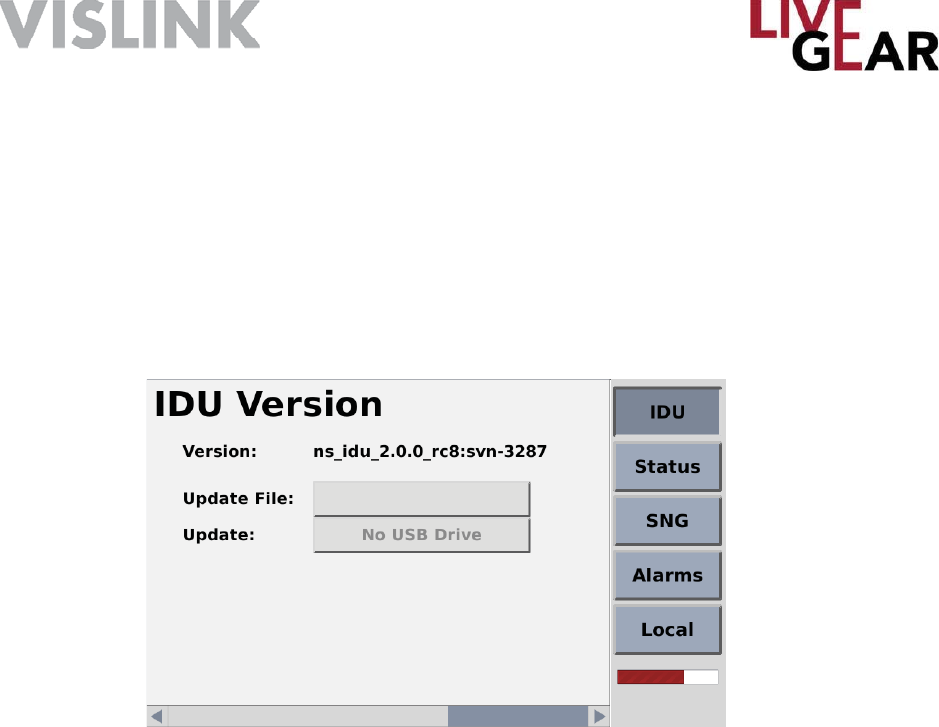
Page 21
NewStream User Guide and Technical Manual
Figure 8: NewStream IDU Information Touchscreen - Software Version & Upgrade
IDU Version
The IDU Software Version and Update touchscreen displays the following information:
• Current IDU software version
• Update option [press the Begin button to initiate upgrade]
Both pages can be viewed by swiping the screen and observing the placement of the
scroll bar at the bottom of the IDU Information touchscreen, as shown in Figures 7 and 8.

NewStream User Guide and Technical Manual
Software Upgrade Process
The following procedure must be strictly adhered to when you are issued an upgrade for
the latest fi rmware.
1. Copy
NewStream software fi le [.nsu fi le type] to the root of a partitioned USB fl ash
drive [data stick].
2. Insert the fl ash drive in the USB port on NewStream’s front panel
3. Press the IDU button on NewStream’s touchscreen and swipe to the IDU Version
touchscreen [refer to Figure 8].
4. Press the Update File fi eld until the most current version of NewStream’s software
is displayed.
5. Press the Update button to start the upgrade.
6. Press Confi rm if the version shown in the Update File entry fi eld is correct.
7. Next, observe that NewStream’s Logo appears with an Upgrading Software
message.
8. Do not remove the USB fl ash drive until the Update Complete message is
displayed. NewStream will restart automatically.
9. Allow this process to repeat and check that the ODU upgrade .nsu is shown in the
Update File fi eld, should you also be updating the Cellular ODU.
NOTE: When upgrading NewStream software, you must use the USB fl ash drive and
front panel operation. While the software upgrade occurs, the IDU front panel OLED
buttons and 16x2 Frequency and Preset displays will be unlit and the touchscreen will
display the message: Software Update In progress, DO NOT POWER-OFF.
System Failure Recovery Process
If NewStream refuse to restart, the following process can be used to recover system
functionality.
1. Copy
NewStream software fi le [recovery.nsu fi le] to the root of a partitioned USB
fl ash drive. It will be the only fi le at the drive root.
2. Insert the USB drive into the front panel port and apply power to the IDU.
3. Press buttons K: Antenna Polarity Selection Switch and M: RF Band Selection
Switch simultaneously and hold for at least 5 seconds [refer to Figure 5]. Wait until
the System Recovery Mode: Upgrading Software message is displayed on the
touchscreen.
4. Insert the fl ash drive and wait for at least 30 seconds. System Recovery Mode:
Upgrading Software message will be displayed.
5. Next, observe that NewStream’s Logo page appears with an Upgrading Software
message.
6. Do not remove the USB fl ash drive until the Update Complete message is
displayed. NewStream will restart automatically.
Page 22
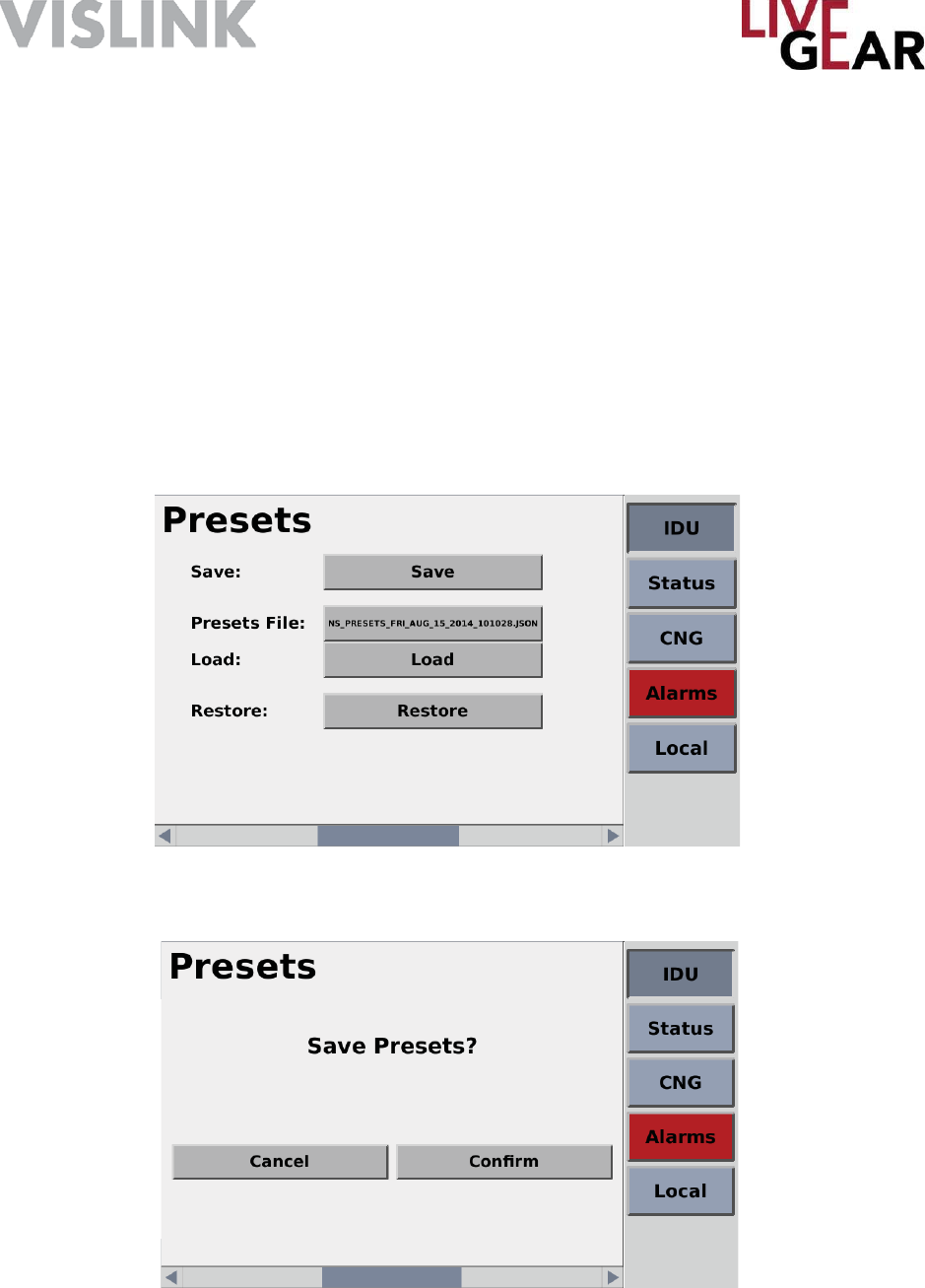
Page 23
NewStream User Guide and Technical Manual
Preset Export and Import
Export Process
The Import and Export of Presets can be accomplished from the IDU front panel and
under Remote control. Refer to the Modify Presets Web interface for more information
about the Remote control options. To Export or Save presets from the NewStream’s
IDU, insert a fl ash drive into the front panel USB port and swipe from the IDU
Information touchscreen to display to the Presets touchscreen, as shown below. The
Presets File button will display the preset confi gurations that exist on the IDU and as
you press the button, each preset is listed within the button.
When you press Save, a confi rmation screen will appear, as shown in Figure 10. Press
Confi rm to save the presets from the IDU to the fl ash drive.
Figure 9: NewStream IDU Preset Touchscreen
Figure 10: NewStream IDU Save Preset Confi rmation Touchscreen
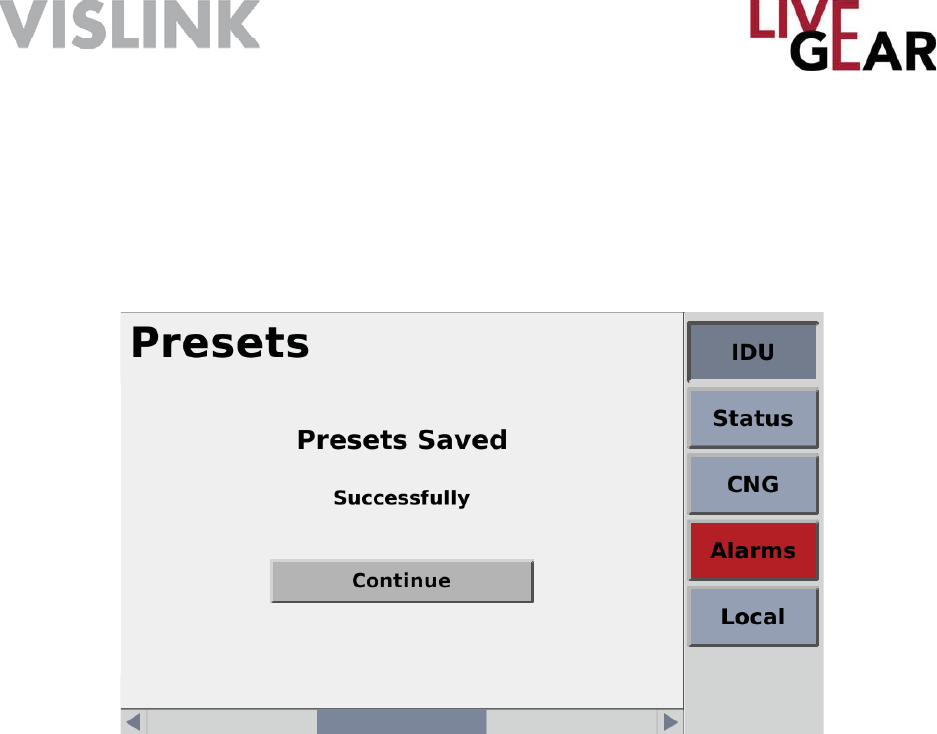
Page 24
NewStream User Guide and Technical Manual
Figure 11: NewStream IDU Presets Saved Success Touchscreen
Figure 11 shows the affi rmation of your Export of preconfi gured settings to the fl ash
drive. With this drive you can distribute the preset fi les by the drive itself, via email or
by saving the presets on a shared server, from which any NewStream operator can
access remotely. Press Continue to conclude the preset export process.
Import Process
To Import or Load presets to the NewStream’s IDU, insert a fl ash drive that includes the
preset fi les that you wish to import in the front panel USB port and swipe from the IDU
Information touchscreen to display to the Presets touchscreen, as shown in Figure 9.
The Presets File button will display the preset confi gurations that exist on the fl ash drive
and as you press the button, each preset is listed within the button.
When you press Load, a confi rmation screen will appear, as shown in Figure 12. Press
Confi rm to save the presets from the IDU to the fl ash drive.
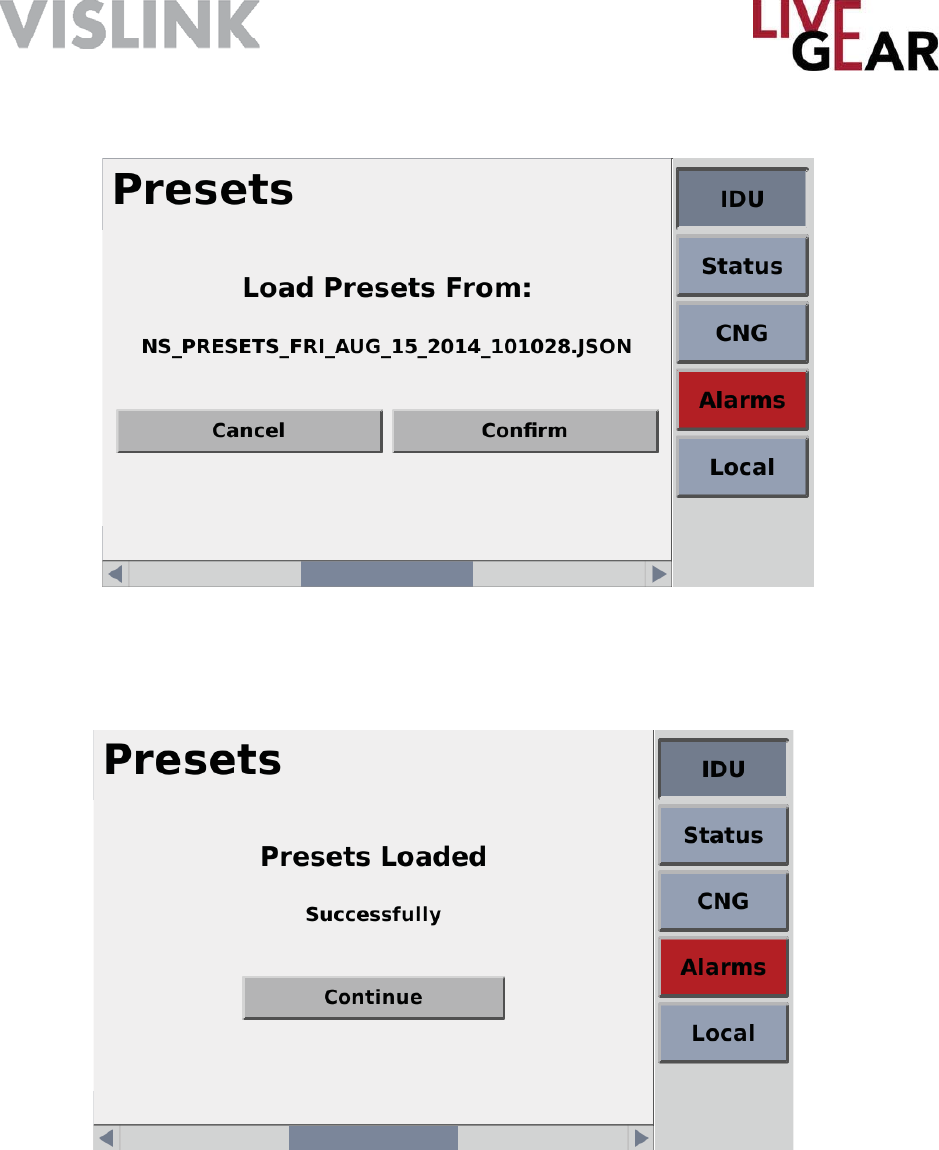
Page 25
NewStream User Guide and Technical Manual
Figure 12: NewStream IDU Load Presets Confi rmation Touchscreen
Figure 13: NewStream IDU Presets Loaded Success Touchscreen
When the presets have been loaded to your IDU, a confi rmation of success screen will
appear, as shown in Figure 13. Press Continue to conclude the preset import process.
When you press the Restore button, NewStream takes a snapshot of your system
each time you apply power to the IDU. If you would like to restore NewStream to the
state it was in when you last applied power, click Restore. This will overwrite any preset
changes that were made since NewStream was last powered on. Press Confi rm and
then Continue to conclude the preset import process.
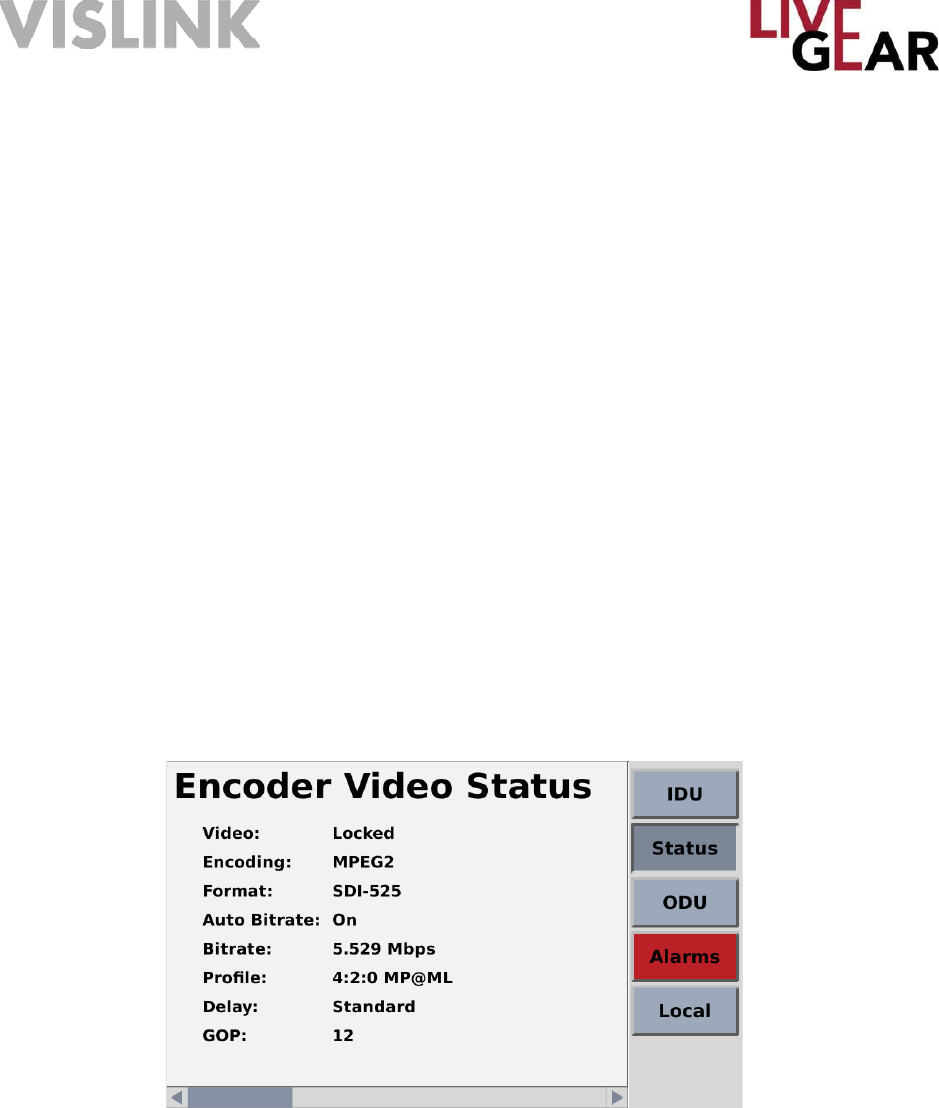
Page 26
NewStream User Guide and Technical Manual
Local Microwave Control
Microwave transmission is implemented using an ENG preset and the NewStream or
legacy Outdoor Units. The ENG Status touchscreens are shown below and the ODU
Information touchscreen is shown in Figure 14. ODU functional explanations follow
along with diagrams of the NewStream and legacy ODUs in Figures A-1 through A-4.
Before starting operation, set the IDU to Remote Mode and go to the Modify Presets
Web interface to make unique copies of the ENG, SNG and CNG Presets in order to
create customized presets that your operators will use during broadcast. For more
information refer to the Modify Presets section. For Remote Control operation see
the sections below: Confi guration Mode touchscreen and Remote Operation Using the
Web Interface
ENG Status
The Microwave Status touchscreens display Video and Audio Encoders, Modulator
and Transport Stream Status listings for the current preset. Each of the pages can be
viewed using a swiping motion. The scroll bar at the bottom of the Status touchscreens
indicates the relative position of each screen. For further information about the listed
settings, refer to the Status Web interface section. Refer below to Figure 14 -17 for
examples of the listed information.
Figure 14: NewStream ENG Encoder Video Status Touchscreen

Page 27
NewStream User Guide and Technical Manual
Local RF Control
There are two OLED buttons and one set of rocker switches that control Radio
Frequency functionality [see Figure 5 items C and D].
ENG Mode
The upper RF Control OLED button is used to control the Power Amplifi er functionality
[see Figure 5 item D]. This button toggles between PA ON to PA OFF. When you press
this button, it will show inverted colors until the operation is complete. Should the action
take a few seconds to resolve, you have positive acknowledgment that NewStream
received input and is loading the state change request. PA ON will display a blue
background allowing you to see this indicator at a distance without having to be close
enough to read the text.
The lower OLED button toggles between PA HI and PA LO [see Figure 5 item C]. The
last state of this button is restored upon system shutdown and startup. Pressing the
rocker up or rocker down button under the PA HI/PA LO OLED will put NewStream
into PA ADJ mode [see Figure 5 item B]. The power level of PA ADJ will default to full
power [zero attenuation] if PA ADJ has not been selected for this ODU Band before,
but otherwise entering PA ADJ will recall the last adjustable power setting for this ODU
Band.
The PA ADJ state for dual band ODUs [i.e. 2/7 GHz] may display different RF level
readings as the adjustment for each RF band, either 2 GHz or 7 GHz, is independent of
one another. This will cause the bottom OLED to show PA ADJ [see Figure 5 item B],
and will allow the up/down rocker to adjust PA power. While in PA ADJ, pressing the
bottom OLED will take the system out of PA ADJ mode, and put it into the last power
state.
SNG Mode
The upper OLED button is used to control the Satellite Carrier functionality [Figure 5
item D]. This button toggles between Carrier enabled [CW ON] and CW OFF. When
you press this button, it will show inverted colors until the operation is fi nished.
Similarly, the lower OLED button [see Figure 5 item C] toggles between Modulation
disabled, MOD OFF and enabled, MOD ON. Both the OLED button’s default states
are OFF.
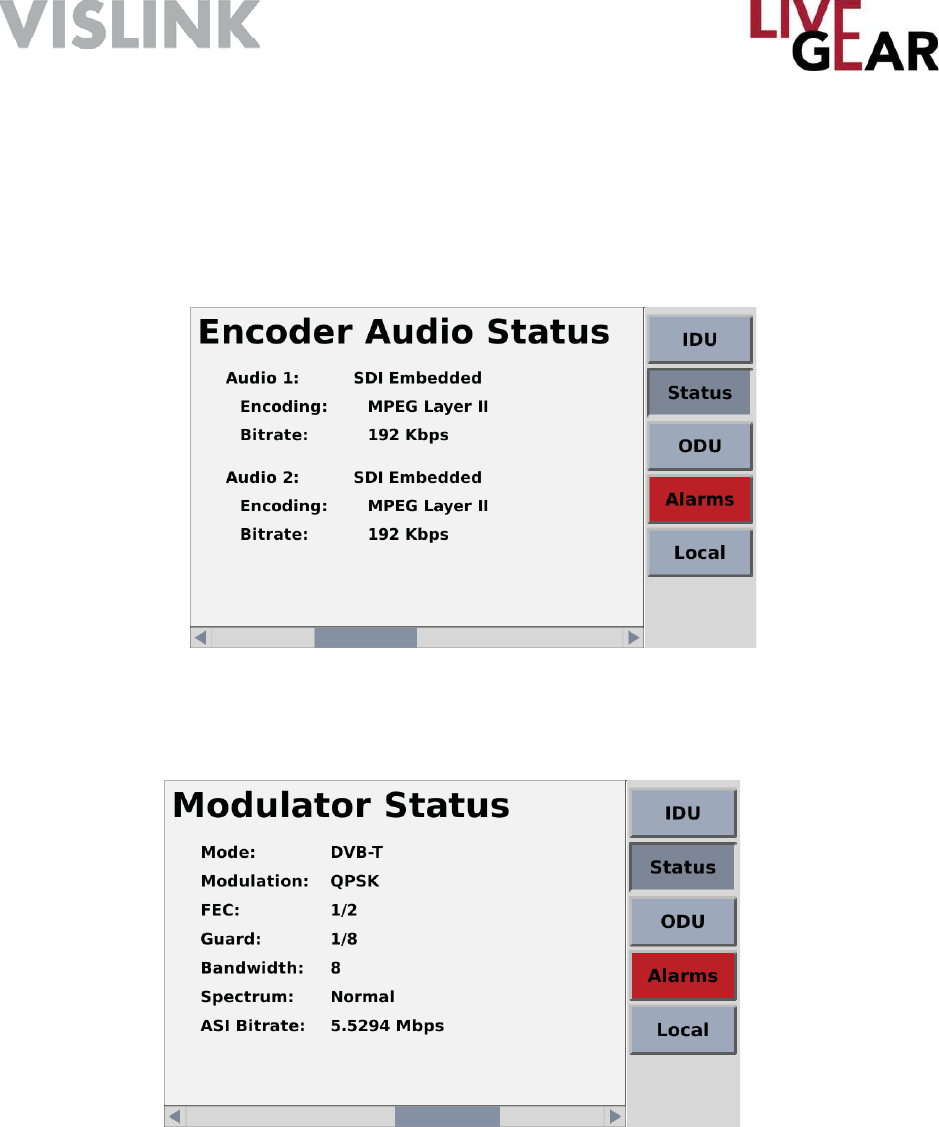
Page 28
NewStream User Guide and Technical Manual
Figure 15: NewStream ENG Encoder Audio Status Touchscreen
The Encoding Status displays the information shown in Figures 14 and 15. The display
layout changes if the Video Encoding Mode is set to External ASI, the remaining
Encoder Status fi elds will show hyphens only. Also, Transport Stream Status will
display hyphens as well.
Figure 16: NewStream ENG Modulator Status Touchscreen
The Transport Stream Status listings displays information about the transport stream
including PIDs, service name, network name, encryption status, wayside data, and
baud rate.
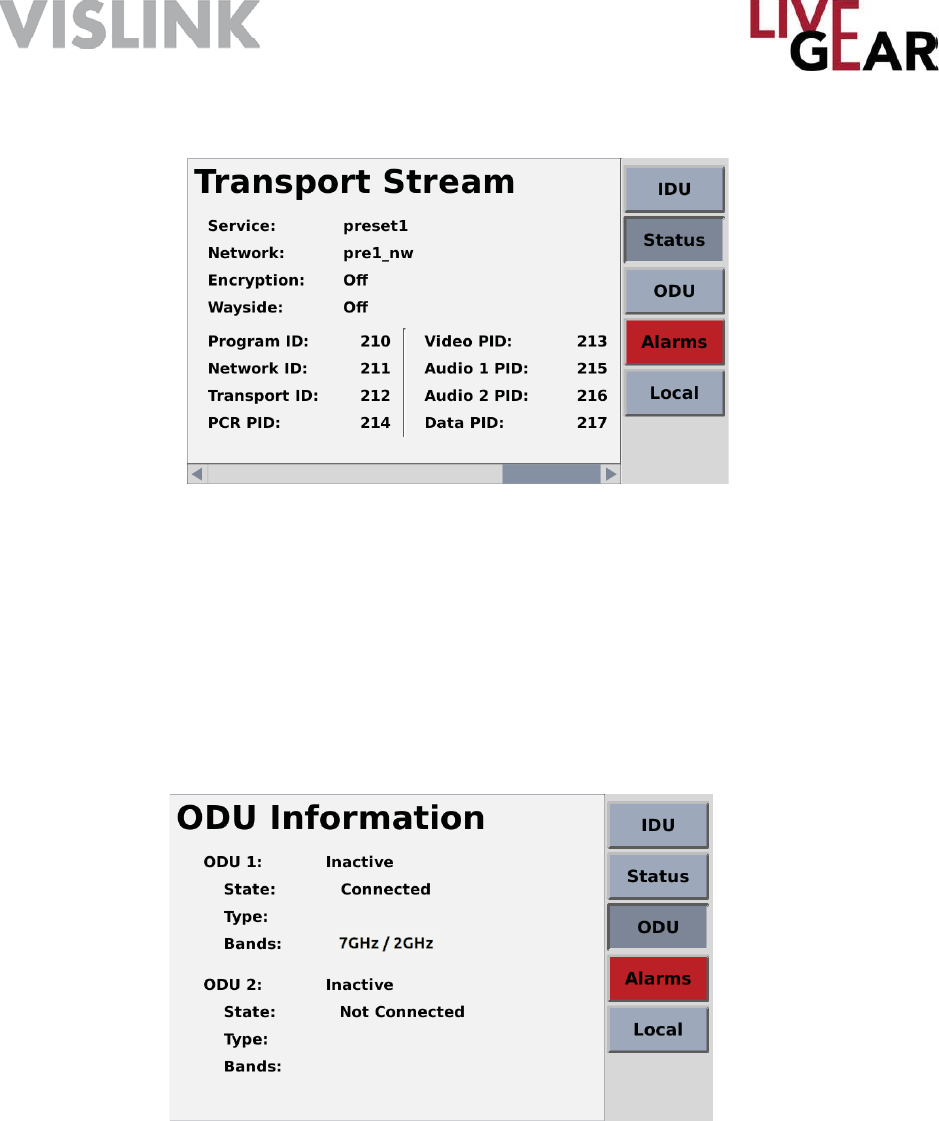
Page 29
NewStream User Guide and Technical Manual
Figure 17: NewStream ENG Transport Stream Status Touchscreen
ODU Selection for RF Bands
There is one OLED button on the NewStream touchscreen that corresponds to the
ODU number labeled 1 or 2 on the rear panel, as well as ODU Frequency band that is
currently used. NewStream automatically determines which ODU is to be selected.
Refer below to Figure 18.
Figure 18: NewStream ODU Information Touchscreen

Page 30
NewStream User Guide and Technical Manual
The ODU button allows you to view with which RF ODU NewStream is communicating.
There are a few confi gurations of ODUs which can be selectable. A rear panel
ODU switch is provided to set the NewStream IDU to the correct voltage and IF to
communicate with either legacy [MTX 12V] or NewStream ODU [NST 48V] type. You
cannot hook up multiple NewStream ODUs to the NewStream IDU.
WARNING: If the ODU the switch is placed in the wrong position or if you
change the ODU type without changing the switch position and restart the IDU
this may result in damage to the ODU and inability to communicate with the ODU.
Toggle Mode RF Band Button Behavior
If the toggle switch is in NewStream ODU mode [NST 48V], and the NewStream ODU is
dual band, the RF Band button can be used to specify which band is currently selected.
The button shows the RF Band covered by the current selection [2 GHz, 4 Ghz, 7L GHz,
7U GHz, 13 GHz]. If the toggle switch is in NewStream ODU mode and the NewStream
ODU is single band, the RF Band only displays the status of the RF band and will not act
as a selection button. The button shows the RF Band covered by the current selection [2
GHz, 4 Ghz, 7L GHz, 7U GHz, 13 GHz]. If no ODU is currently detected, then RF Band
button displays NO ODU.
Legacy Toggle Mode RF Band Button Behavior
If the toggle switch is in Legacy ODU mode [MTX 12 V], the RF Band button alternates
between using ODU 1 and ODU 2 outputs on the back of the IDU, regardless of which
ODUs are connected to those ports. When ODU 1 is selected, 70 MHz IF and FSK is be
directed to the ODU1 port, and 12 V is sent to ODU 1 power connector. When ODU 2 is
selected, 70 MHz IF and FSK is directed to ODU 2 port, and 12 V is sent to ODU 2 power
connector.
If an ODU is disconnected, NO ODU is shown in the OLED button, the 16x2 Frequency
display is unlit, the button next to it is lit red, and an alarm displays. If the ODU is
reconnected, the state of the IDU resumes operations. Pressing the PA Band button
switches to the other available ODU port however, the disconnected ODU is not be
selectable.
The RF Band button displays the ODU the RF Band covered by the current selection
on the bottom line [2GHz, 4Ghz, 7L GHz, 7U GHz, 13GHz]. The 16x2 Frequency also
displays the frequency band. If both ODUs are the same head type and frequency band,
the RF Band button toggles between ODU 1 and ODU 2 ports but displays the same
band information on the button. If no ODU is currently detected, then the RF Band button
displays NO ODU.

Page 31
NewStream User Guide and Technical Manual
ODU Disconnect/Reconnect During Operation
The NewStream IDU always monitors the connection between itself and the ODU on
the selected port. NewStream automatically detects whether the connection is lost
between IDU and ODU within 15 seconds. If connection loss is detected, an alarm
displays in the alarm indicator, the RF Band button displays NO ODU, and the 16x2
Frequency display is unlit and the selection LED button is lit red.
In case of a disconnect, the IDU continues to search within the current port for the ODU.
If the ODU connection is re-established, then the previous alarm will clear, and the RF
Band button will show the RF band of the ODU connected. The 16x2 Frequency display
presents the frequencies supported by the head. In the case of multiple bands included
within the ODU, the IDU will set the ODU to the band selected before the ODU was
disconnected.
Local Antenna control
ENG Mode
The upper Antenna Control OLED button controls Antenna Polarity [see Figure 5 item
K]. This button cycles between vertical [V], horizontal [H], right-hand circular [RC] and
left-hand circular [LC] polarization. There is minimal delay between switching from one
polarity state to another.
The middle OLED button controls a relay to switch between Antenna 1 and Antenna 2.
There should not be any delay between switching from one Antenna to another. The
ability to switch from Antenna 1 to Antenna 2 is an option that needs to be enabled from
the Web interface. If this option is not selected, then pressing the antenna button will
not cause the state of NewStream to change.
The lower Antenna Control OLED button controls RF band based on which ODU is
connected. See Change ODU [RF Bands] for more detail on this.
SNG Mode
The OLED buttons under Antenna Control are re-purposed as frequency selection
arrow keys when a SNG preset is used.
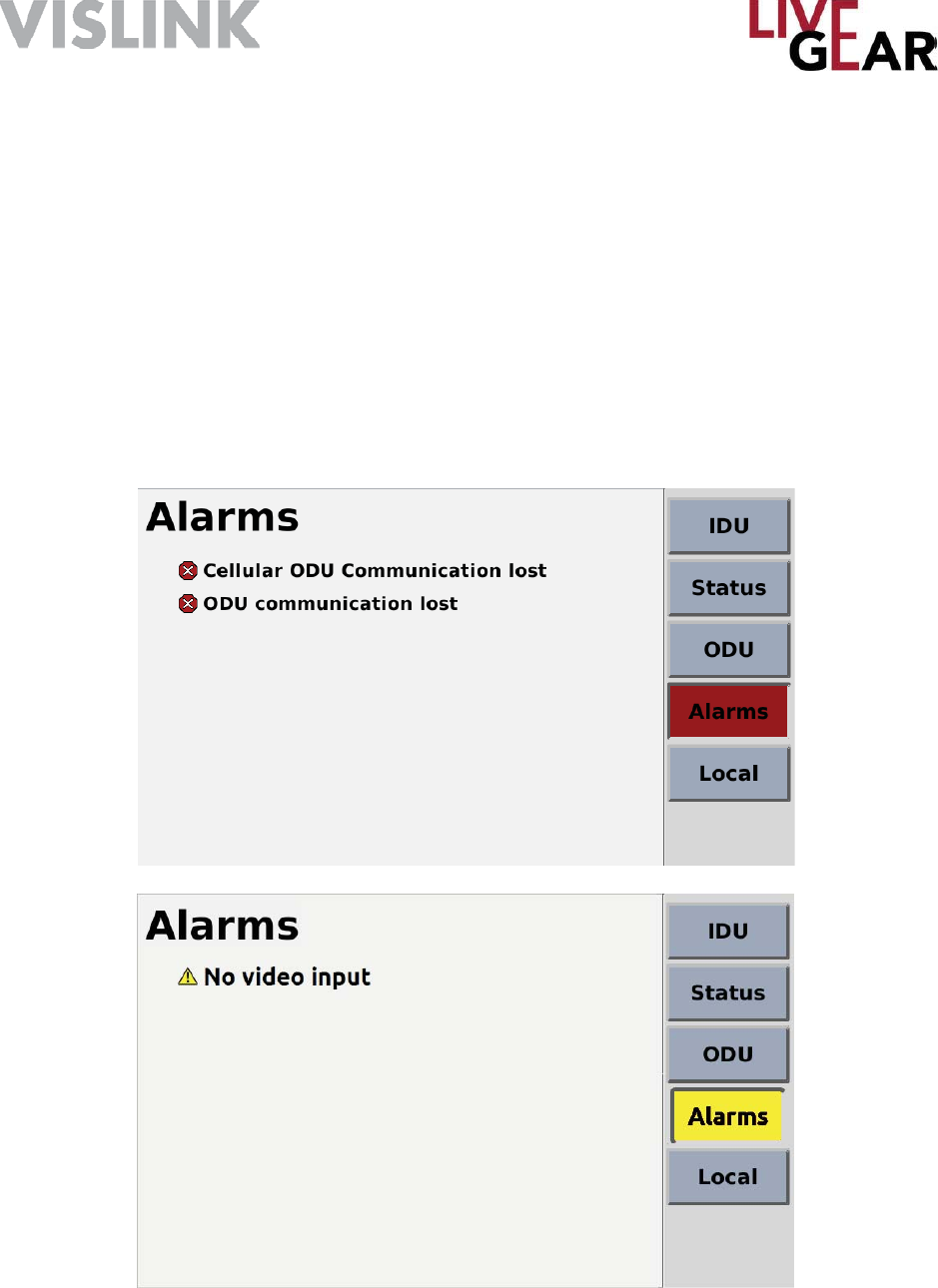
Page 32
NewStream User Guide and Technical Manual
Alarms
The Alarms touchscreen displays all the NewStream alerts or alarms. If a critical alarm
is present, this button is red [as shown below]; when an alert or warning is present the
Alarms button will be amber and with no alarm activated, the button is gray.
Alarm conditions include:
• Video Lock – when video feed is absent,
• Mismatched preset settings
• Internal modules malfunctioning
• Attempt to change mode of operation to an unlicensed option
• Communications with ODU have been lost
• Other ODU alerts and alarms such as temperature conditions
Figure 19: NewStream System Alarms Touchscreen Examples
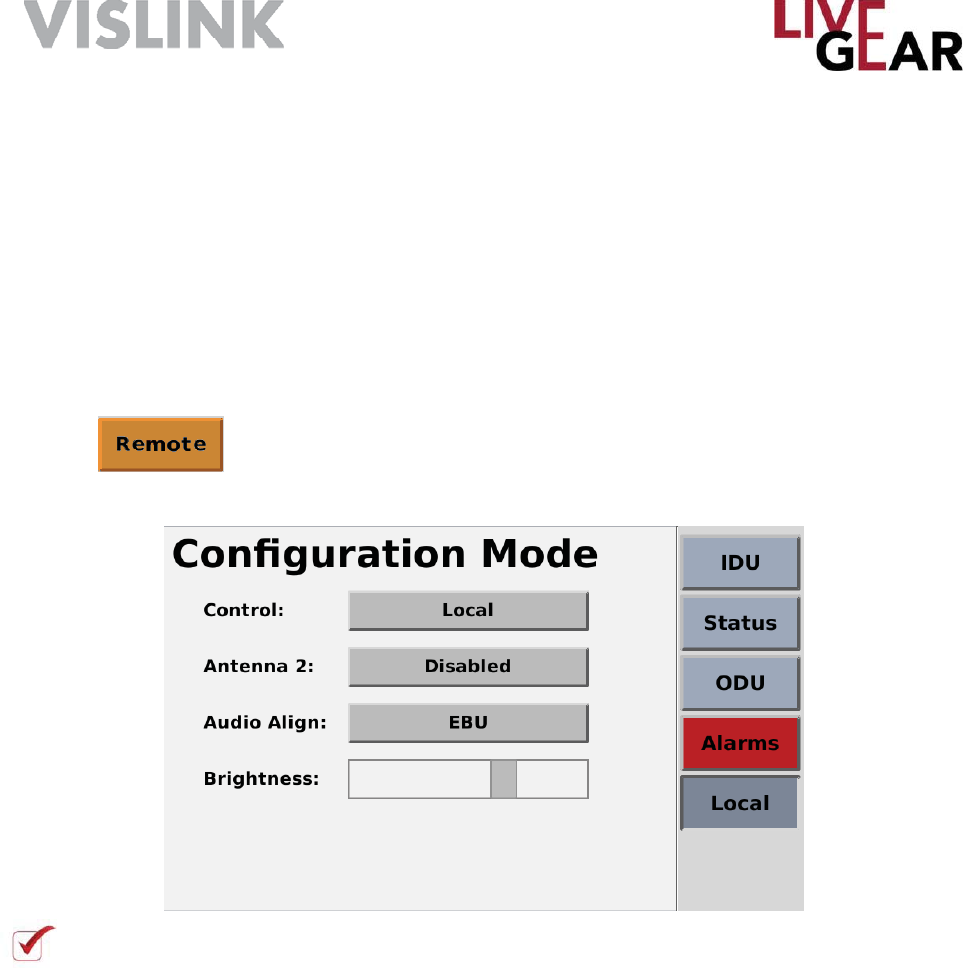
Page 33
NewStream User Guide and Technical Manual
Confi guration Mode
The Confi guration Mode touchscreen displays the current operational state of the
NewStream system. The Local/Remote control button allows you to toggle between the
two states.
• Local mode – operation and control of the transmitter is done solely from the IDU
front panel and read only access is allowed to NewStream via the Web interface.
• Remote mode – operation and control of the system can be executed from the
Web interface. The IDU front panel buttons are inactive but the displays, screens
and buttons show current states. The Local button changes color and Remote
appears when the toggle is activated [see example].
NOTE: Setting the unit in Local or Remote mode is done at the IDU by the operator
and must remain in this mode each time the unit is started. When NewStream is in
Local mode the IDU will not accept any remote commands however, remote access
is allowed for status monitoring.
The touchscreen also allows you to view the current Antenna [1 or 2 in ENG mode
only] and Audio Alignment confi guration. There are two Audio Alignment options:
EBU or SMPTE. For more information, refer to NewStream Settings under Remote
control in the General Settings section. There is also a Brightness control for
the overall appearance of the screens. Tap the button to the right to brighten the
touchscreen display.
Cellular [CNG] Operation
This section describes the operation of the IDU in local and remote control using the
touchscreen and the button/LEDs associated with the front panel Cellular portion, as
well as the Web interface.
Figure 20: NewStream Local/Remote Selection Touchscreen

Page 34
NewStream User Guide and Technical Manual
Confi guring Cellular Communications
When confi guring Cellular Presets, you must type an IP Address to designate the
destination for the cellular video stream. The LiveGear Receiver’s [LGR] IP address
is the destination to communicate with the NewStream IDU. You must also designate
the LGR Port and Channel numbers for the cellular video stream. Use the LGR Port
and Channel numbers assigned for communication with NewStream. This information
can be added to the CNG Presets that you confi gure with the Web interface in
Remote mode. Refer below to the following Initial Setup section to assist your Cellular
confi guration endeavors.
As mentioned for Microwave control, set the IDU to Remote Mode and go to the
Modify Presets Web interface to make unique copies of the CNG Presets in order to
create customized presets that your operators will use during broadcast. For more
information refer to the Modify Presets section. For Remote Control operation see
the sections below: Confi guration Mode touchscreen and Remote Operation Using the
Web Interface.
Initial CNG Setup
It is recommended that you pre-confi gure the transmitter and receiver together in the
studio to ensure that the initial settings are analogous. It is also suggested that you
test the system with a live video feed prior to sending a transmitter team to a remote
location. The initial steps for the confi guration procedure are as follows:
Live Gear Receiver [LGR-1000] - Refer to the LiveGear Receiver User and Technical
Manual for more information.
Connect AC Power Supply.
Connect Video Output [SD/HD OUT / 1 to monitor].
Connect Ethernet Cable [WAN port to router].
Set the rear Power Supply switch to On position.
NewStream Transmitter
Install SIM cards [up to 6] in the Cellular ODU if not pre-installed - refer to
Appendix A for further information.
Set IDU to Remote control.
Connect video source [SD or HD SDI Input on the rear panel - refer to Figure 6].
Connect AC power supply [on the rear panel - refer to Figure 6].
Steps to Stream Video in CNG Mode:
1. Connect a laptop to the 4 port switch on the rear panel and apply power to the
LGR by setting the Power Supply rocker switch on the rear panel and by pressing
the front panel Power push button. Check the LCD to ensure that the initialization
process has completed.
2. Browse to the default IP address of the LGR on the LAN at http://192.168.2.200.
Log in using the UID/PW: admin/admin.
3. Browse to Setup > Network Settings
4. Set your IP address information in the WAN Confi guration box and click Save.
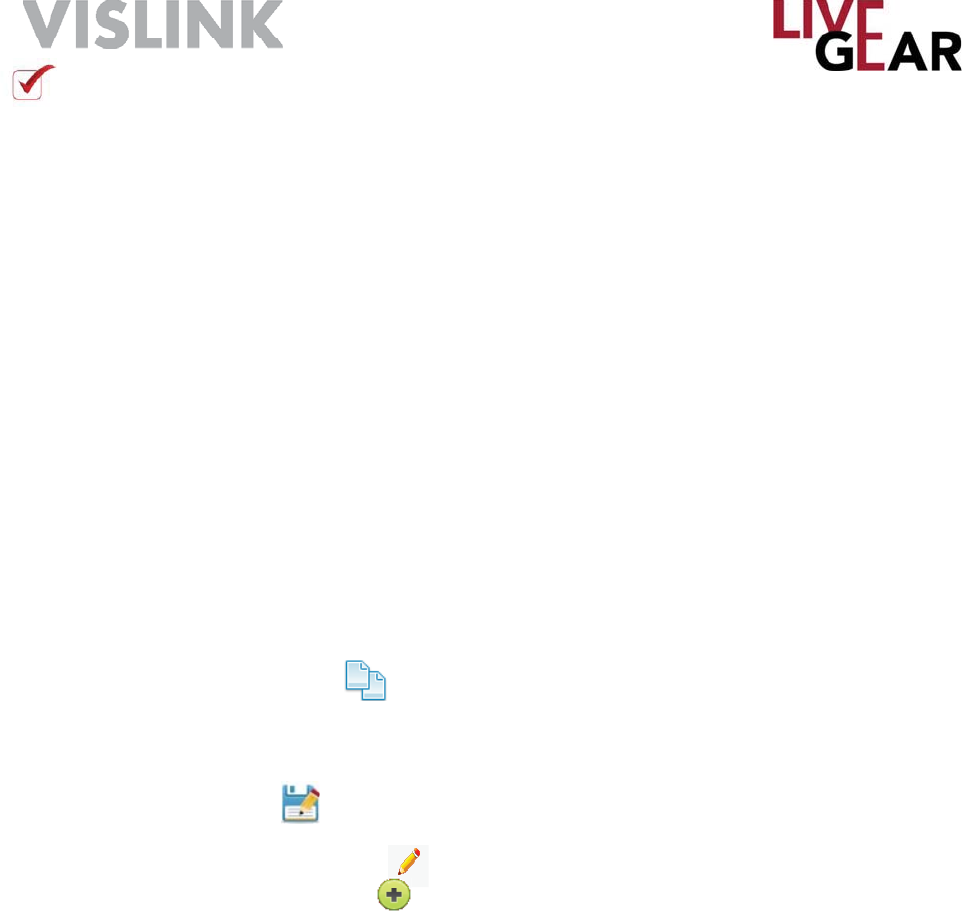
Page 35
NewStream User Guide and Technical Manual
NOTE: If you are placing the LGR behind a router/fi rewall, you will need to forward at a
minimum, port 4001 TCP/UDP to the LGR. You can change the LGR’s listening port on
the Setup > LGR Inputs Web page. If you do change the port, be sure to change the port
on NewStream as well.
5. On the LiveGear Receiver:
a. Using the touchscreen on the front panel, press the up arrow to display the WAN
IP address. This IP address needs to be entered in the Destination Stream
address fi eld using the NewStream Web page [see confi guration steps below].
b. Default Listening Ports are: 4001 for Channel 1 or 4002 for Channel 2.
c. Save the settings
d. Select the Status button to return to the Status screen.
6. Apply power to NewStream using power rocker switch on front panel. Wait for the
initialization process to complete [approximately 45 seconds]. Allow approximately one
minute for NewStream to boot up and optimize the cellular links for broadcast.
7. On the
NewStream IDU - fi rst connect an Ethernet cable to an Ethernet port:
a. Check that the Cellular Status screen shows service for the cell modems with
SIM cards installed [refer below to Figure 31 (and Figure 21 in Local mode)].
Power cycle the IDU if the cellular carriers do not connect.
b. Once NewStream is booted and the modems are connected, select Remote
Control mode and open the Web interface and select Setup > Modify Presets. Select
the Copy Preset option on the default CNG Preset if you have not yet confi gured
any CNG Presets to begin confi guration. Refer to Remote Operation Using the Web
Interface, in this manual for more information about NewStream Remote control.
c. Name the new CNG Preset, click the Create Preset button and fi nally click the
Save Preset icon . It is important to note that if you modify the preset name
or type, be sure to click the Save Preset icon before customizing additional settings.
d. Use the Edit Preset icon to customize the newly created preset. Select the
Cellular Settings using the icon and chose the Cell Mode Delay that most closely
matches the type of video that you plan to transmit.
e. Ensure that the Destination Stream IP address is set to the LGR’s IP address to
which you will stream the video feed.
f. Select a Port Number [#] to set the listening port to stream the video feed.
g. Select a Channel number to set the LGR Channel to stream the video feed.
h. Adjust the Encoder controls based on the carrier service available.
i. Set the Cellular Transport Stream using the entry fi elds provided.
j. Set the Audio Encoding and Input based on the carrier service available.
k. Select the Save button to return to the Modify Presets Web page.
l. Ensure that you have a secure connection to your video source at the Video
Input BNC connector on the rear panel of the NewStream transmitter.
m. Press NewStream’s Start or Stop Cellular Transmission button to begin live
streaming [see Figure 5 item O].
8. You can view connection status by logging into the LGR Web interface and selecting
Channel 1 on the drop-down menu.
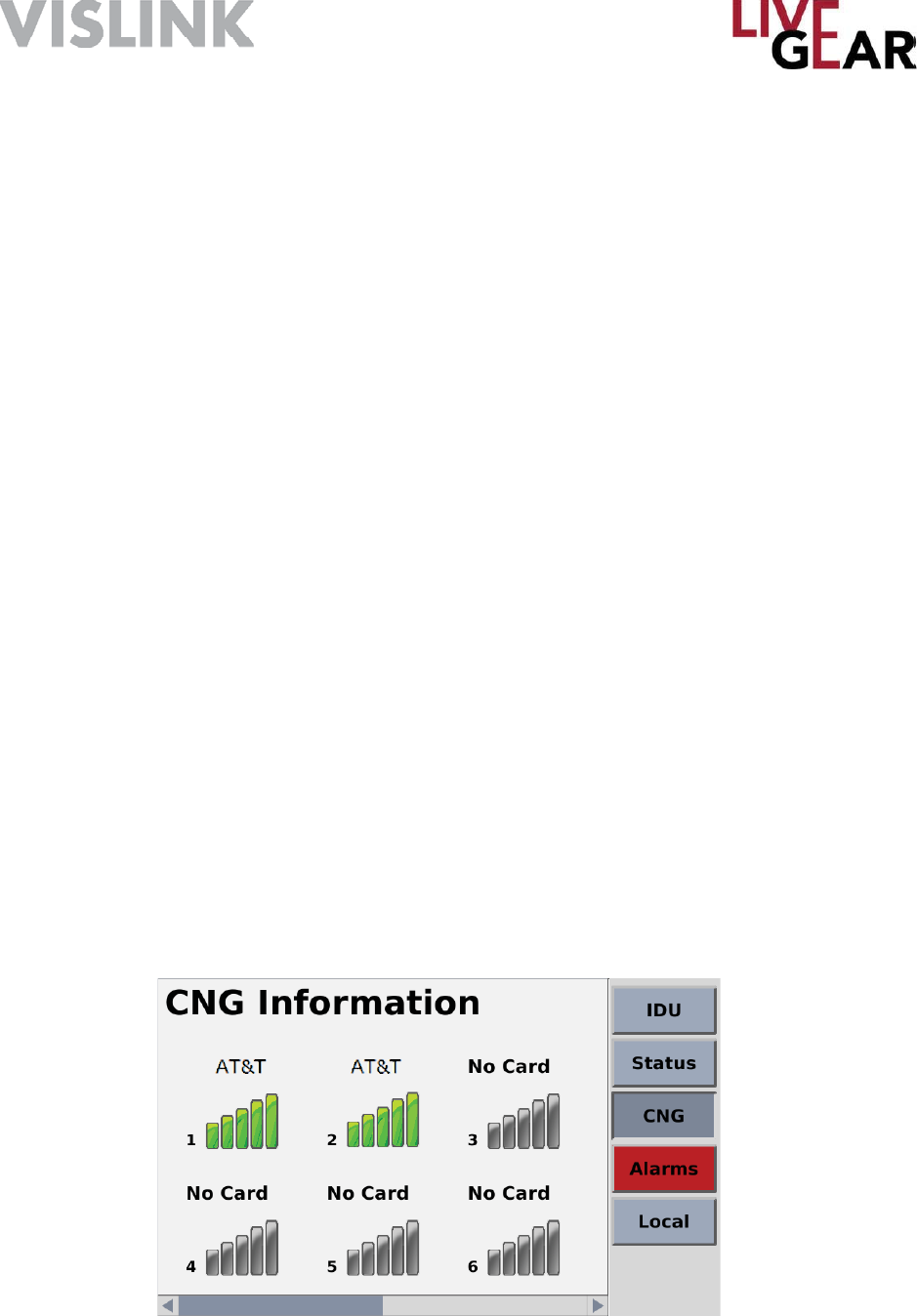
Page 36
NewStream User Guide and Technical Manual
Figure 21: NewStream CNG Information Touchscreen
CNG Touchscreens
When the NewStream has the capability of operating in a cellular mode, the
touchscreens are labeled CNG displaying information and settings specifi c to cellular
transmission. When the NewStream does not detect the cellular ODU, the CNG
information screen shows the message Cellular ODU is loading, please wait. Once
the cellular ODU has booted up and can provide information about its confi guration, the
message changes to a status screen describing the current connectivity of the modems
in the cellular ODU. This CNG Information screen displays the following:
1. A graphical representation of the current RSSI per modem using signal strength
bars similar to a phone.
a. If RSSI > 120 = 5 gray bars
b. If RSSI > 95 and < 120 = 1 red bar, 4 gray bars
c. If RSSI > 85 and < 95 = 2 amber bars, 3 gray bars
d. If RSSI > 75 and < 85 = 3 amber bars, 2 gray bars
e. If RSSI > 60 and < 75 = 4 green bars, 1 gray bar
f. If RSSI > 1 and < 60 = 5 green bars
g. When a modem is not detected the words No Modem replace the signal bars
graphic.
h. If a modem is detected but there is no SIM card installed, the words No Card
replaces the signal bars.
i. If a modem and a SIM card are detected but not yet not connected to a
network, the word Connecting replaces the signal bars
2. The name of the carrier to which the modem is connected.
3. The service [3G/4G/LTE] to which the modem is connected.
4. The number of the SIM card slot in which the SIM is inserted.
The CNG Information touchscreen is shown below in Figure 21. This screen displays
the relative signal strength information for each of the six modems
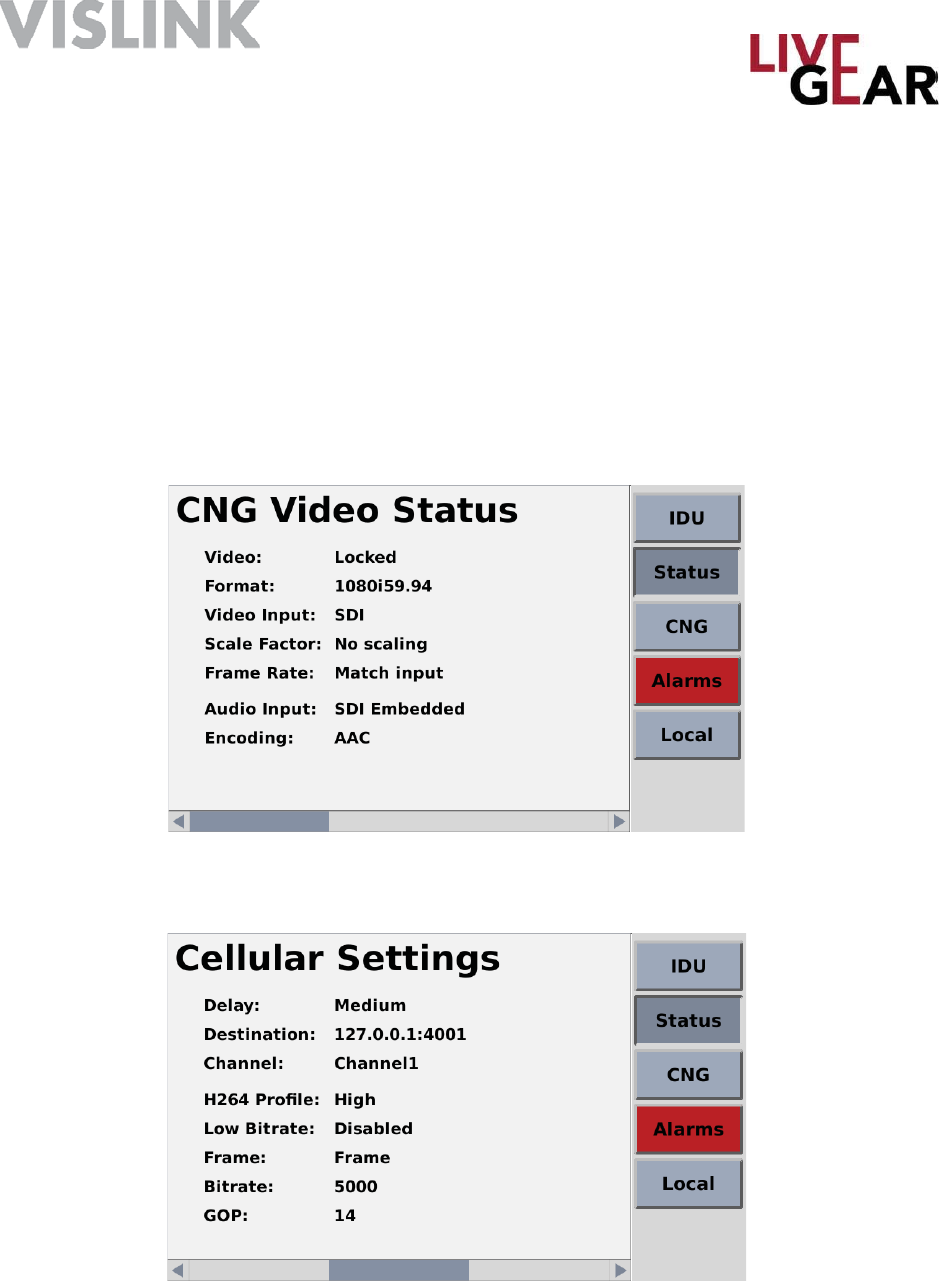
Page 37
NewStream User Guide and Technical Manual
CNG Versions
Use the slider at the bottom of the CNG Information touchscreen to display a listing of
CNG Model number, Revision, Software and Encoder fi rmware version.
CNG Status
The Cellular Status touchscreens display Video Encoder, Transport Stream and
Cellular Settings Status for the CNG preset confi guration. Each of the screens can be
viewed using a swiping motion. The scroll bar at the bottom of the Status touchscreens
indicates the relative position of each screen. For further information about the listed
settings, refer to the Status Web interface section. Refer below to Figures 22 -24 for
examples of the information displayed on the CNG Status touchscreens.I
Figure 22: NewStream CNG Encoder Video Status Touchscreen
Figure 23: NewStream CNG Cellular Settings Touchscreen
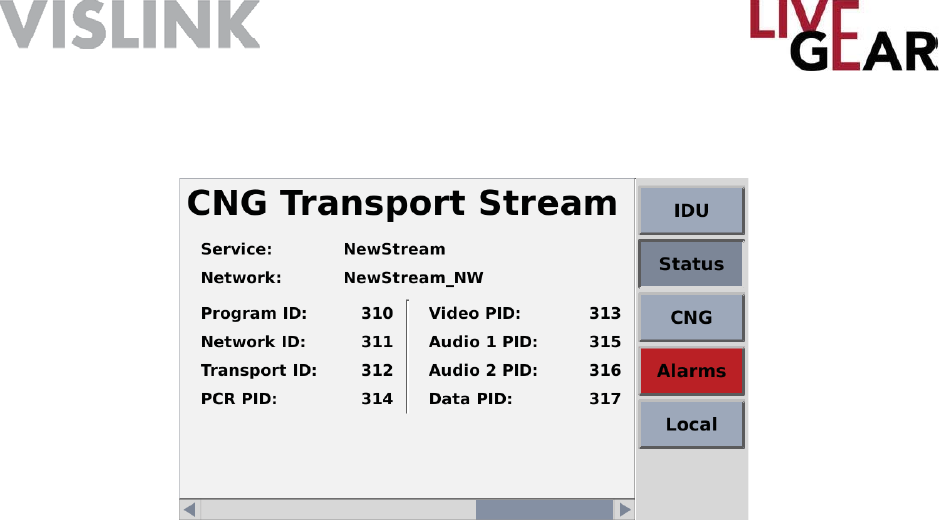
Page 38
NewStream User Guide and Technical Manual
Figure 24: NewStream CNG Transport Stream Status Touchscreen
NewStream Video Cellular Transmitter Data Usage
The monthly operating cost of a NewStream transmitter is entirely dependent upon
the consumption of wireless broadband data. Wireless service providers typically offer
monthly data packages with a maximum “use-it-or-lose-it” usage capped in gigabytes
[GB] before data overuse charges are implemented, usually in 1 GB increments.
A key attribute of H.264 AVC [MPEG-4 Part 10] encoding is that HD quality video can
be transmitted at less than half the data rate required by MPEG-2. While broadcast
video streaming quality is regarded more subjectively than classic contribution and
distribution standards, there are some basic guidelines that you can adopt to determine
the appropriate data rate required in a given situation.
The degree of video motion to be encoded directly impacts the upload data rate,
typically expressed in megabits per second [Mbps]. For example, low motion 29.97/30
fps [frames per second] video, often referred to as “talking head” video, requires a video
encoding data rate ranging between 1.0 - 3.0 Mbps, whereas fast motion video, such as
a sporting event, can require data rates as high as 8 Mbps, depending on the resolution
[e.g. 720p/1080i] selected. An average data rate of 3.0 Mbps provides approximately
30 hours of video transmission consuming about 40 GB of data. Encoding at 6.0 Mbps
consumes up to 80 GB of data, and at 8.0 Mbps, slightly more than 105 Mbps.
NewStream transmits video using up to six wireless network services simultaneously.
The system is designed to level load or equally distribute the total amount of data being
transmitted [i.e. uploaded] provided that there is equal wireless network availability for
each of the modems. In this ideal case, the total data used is equally distributed across
each of the six modems. In reality, network connection accessibility varies from one
venue to another and is also subject to its availability from a loading perspective.

Page 39
NewStream User Guide and Technical Manual
From a cost savings standpoint, it is judicious to set the maximum video encoding
data rate to the lowest level required to support the kind of video being produced. In
addition, NewStream’s adaptive bit rate encoding technology automatically reduces the
encoding data rate based upon the degree of motion detected, to further enhance data
usage conservation.
Satellite [SNG] Operation
NewStream’s satellite system allows you to transmit using your existing equipment.
Your Block Up-converter [BUC] is used in the transmission [uplink] of satellite signals. It
converts a band of frequencies from a lower frequency to a higher frequency. There are
three frequency tuning options in satellite mode: Frequency Tuning in L-Band [Block-
upconverter disabled], Frequency Tuning with BUC enabled in Ka, Ku and C bands
and with either High or Low side local oscillators. Additionally, you can set up preset
frequencies in Remote control categorized by specifi c channels [Channel tuning].
SNG functionality allows user-defi nable frequency and power level confi guration. SNG
modes have fi ne control of frequencies down to 1 KHz gradations and power outputs
down to 0.1 dB gradations. To facilitate this, the up/down/left/right and enter buttons to
allow you to easily select frequency and power level in local control on the front panel.
As mentioned for Microwave and Cellular control, set the IDU to Remote Mode and
go to the Modify Presets Web interface to make unique copies of the SNG Presets in
order to create customized presets that your operators will use during broadcast. For
more information refer to the Modify Presets section. For Remote Control operation
see the sections below: Confi guration Mode touchscreen and Remote Operation Using
the Web Interface.
In SNG mode, the three OLED buttons on the right [Figure 5 items K and L] are not
used for antenna control. Instead, they have been re-purposed for the Left and Right
movement as arrow buttons.
Touchscreen Display for SNG Operation
SNG Sub-menu
When in Satellite Mode, the touchscreen replaces the ODU sub-menu with an SNG
sub-menu. Under this sub-menu the following information is displayed:
o Channel Plan Mode or Frequency Tune Mode selection
• You can select either Channel Plan Mode or Frequency tune mode via this sub-
menu.
o Block Up-converter [BUC] LO Frequency - button in the BUC Setup touchscreen
• Spectrum Non-Inverted or Spectrum Inverted Selection underneath BUC
Power Level Selection
The section that previously showed ENG power level is replaced with a section that
shows SNG power output from the NewStream . This section also allows you to set a
power level between -40.0dBm and +5.0dBm with resolution up to 0.1 dBm.

Page 40
NewStream User Guide and Technical Manual
Frequency Selection
Block Up-converter Options
When using Block Up-converter Options, you are able to enter the frequency that you
want and the spectrum inversion properties of the Block Up-converter. The NewStream
tunes the L-Band modulator with the proper calculation. This allows you to enter the
LO [Local Oscillator] frequency of the Block Up-converter that you are using, and set
which type of LO injection is used by the BUC. Low side LO indicates a non-inverted
spectrum and High side LO, an inverted spectrum. See Satellite Frequency Tune Mode
- BUC Enabled - IDU Touchscreen Control, on the next page, for more infromation.
Refer to Frequency Tuning Example With BUC Enabled for detailed instructions.
You can also setup as many as 99 Channels that designate specifi c frequencies and
use the Channel Plan option [a.k.a Channel Tuning in remote control] to select them.
You must setup these channels via the Web interface. Refer to the Frequency Plans
Page [SNG] for more information.
Frequency 16x2 Character Display
In Satellite Channel Plan Mode, the two lines of the frequency display window [Figure 5
item E] will show
CH #
Frequency in MHz.
The frequency shown will always be the Frequency output of [BUC LO + L-Band IF if
Spectrum Non-Inverting Low Side] or [BUC LO – L-Band IF Spectrum Inverting High
Side]. If BUC LO is not entered, use L-Band IF frequency. In Frequency Tune Mode,
the two lines of the frequency display window [Figure 5 item E] will show Frequency
Tune Mode Frequency in MHz.
The frequency shown here is always the desired frequency output of the BUC. If the
Block Up-converter Local Oscillator is not entered, the output will be between 950 -1750
MHz.
Power Rocker Switch
The RF power level is displayed on the touchscreen, in the lower right corner. You
can press the RF Adjustment rocker switch up or down [Figure 5 item B] to increment
or decrement the power in .5dBm steps. Exact levels can be entered by pressing
the Power button on the 5” touchscreen display. The rocker will always move to the
nearest 0.5dB, even if the last number was set to an in-between power level.
Example: If you set the power to 0.2dBm on the touchscreen, then press the rocker
up button, the power will show 0.5dBm. Likewise, if the power reads 0.2dBm and you
press the rocker down button, this will read 0.0 dBm.
The L-Band power ranges from -40.0d B to +5.0 dB in 0.1dB increments. The power
level will always return to the last used power level. A typical application is to set the
L-Band power to the correct level [-12dB is typical] to satisfy the satellite amplifi er’s
input and the control power to the satellite using the amplifi ers control panel.
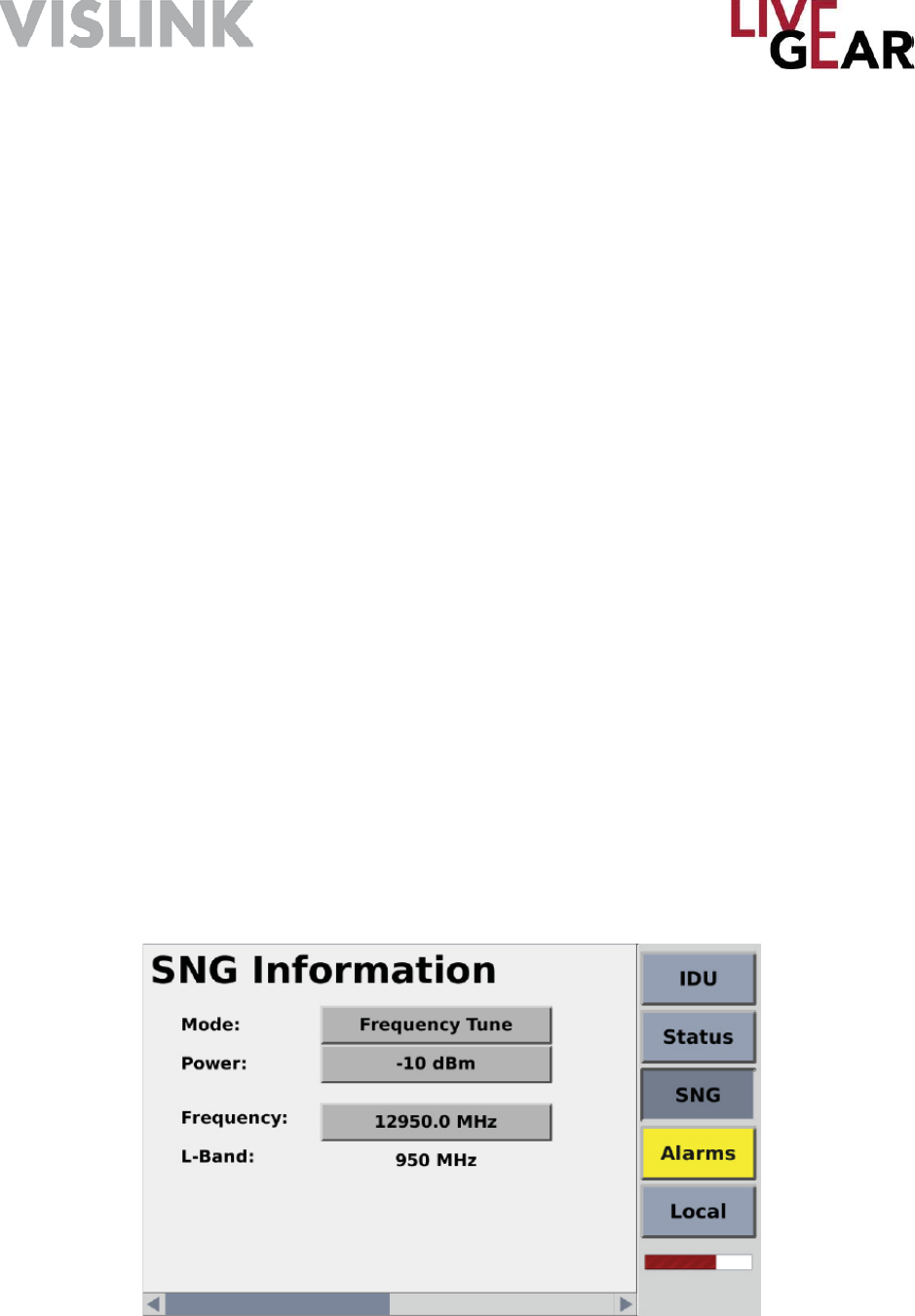
Page 41
NewStream User Guide and Technical Manual
Figure 25: NewStream SNG Information Touchscreen - Frequency Tune
SNG Information - Frequency Tune Mode - IDU Touchscreen Control
To change settings within the SNG Information touchscreen, in Local Mode, press
the Mode: botton to toggle to Frequency Tune Mode [see Figure 25]. Next, press the
Power: button to display the numeric keypad, type the value in dBm and then press
the Enter key on the keypad to set the L-Band power level. L-Band power settings
range from -40 to 5 dBm. When you press the CW [Carrier] button [Figure 5 item D], the
power level selected is displayed in the lower right of the touchscreen below the red bar
graph, in the lower right of the touchscreen. The CW toggle will disable the Mode and
Frequency settings while the Carrier is On.
When you press the Frequency: button, the numeric keypad displays allowing you to
set the SNG frequency. You must set the Block Up-converter frequency to the correct
level, which is dependent on your system’s Block Up-converter. Press the Enter key
shown on the keypad after each of the keypad actions.
If you want to use the IDU front panel buttons and rocker switches to set Satellite
frequencies, select an SNG Preset and start with the rocker switch [Figure 5 item G],
that controls each digit of frequency, as displayed within the Frequency 16x2 display.
You can move the cursor within the Frequency 16x2 display to increment the digits of
the numeric display using the left/right arrow buttons [Figure 5 items K and L]. Selecting
the frequency setting feature automatically sets the cursor to the leftmost position and
causes the Enter button [Figure 5 item I] to start blinking amber. Pressing [Figure 5 item
L] right arrow allows movement of the cursor to the right by one digit and then using the
rocker switch [Figure 5 item G] you can increment that digit up or down. You can set
the cursor to the left by using the left arrow [Figure 5 item K]. When you are satisfi ed
with the entry, press the Enter button [Figure 5 item I] to save the new frequency. If no
action occurs after 15 seconds, the frequency window reverts to the last frequency set.
Frequency settings persist from one power cycle to the next.
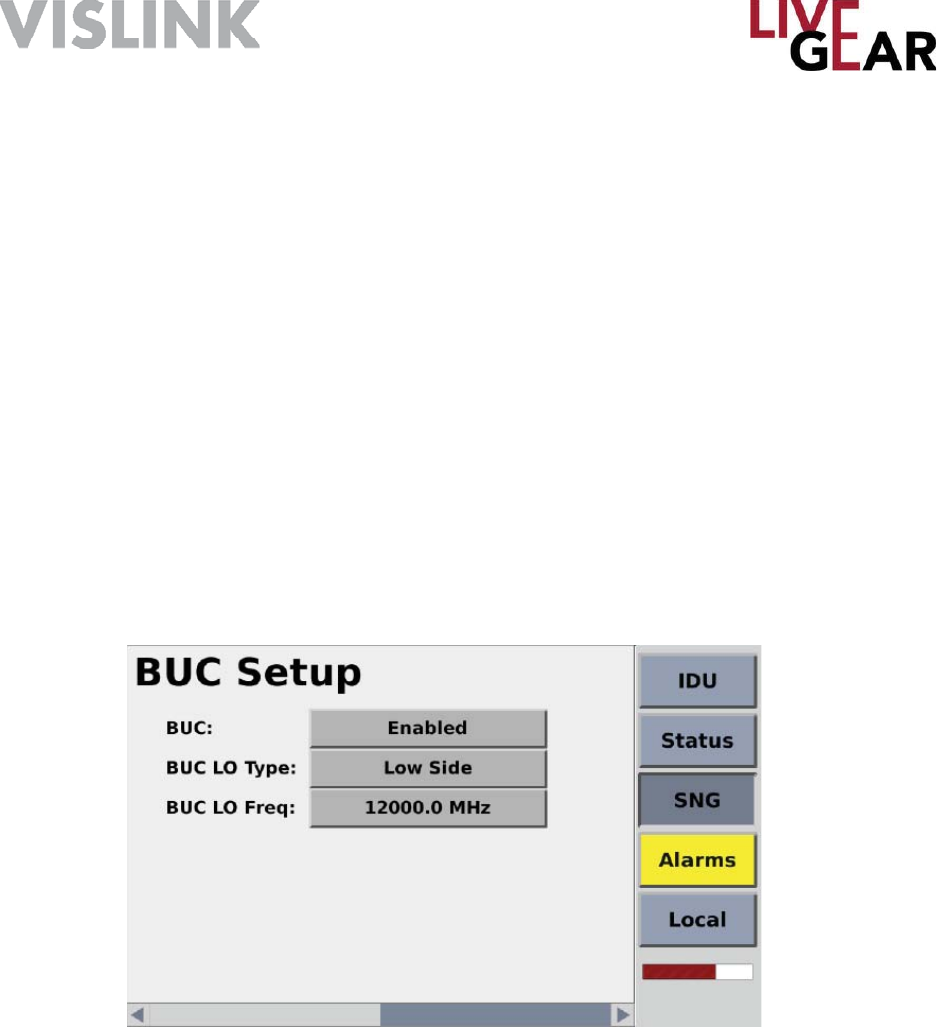
Page 42
NewStream User Guide and Technical Manual
• If a Block Up-converter frequency is entered and the spectrum is non-inverting
Local Oscillator [LO] type is Low Side, the frequency range is 950.000 MHz to
1750.000 MHz above the Block Up-converter frequency in 1kHz steps.
• If a Block Up-converter frequency is entered and the spectrum is inverting LO type
is High Side, the frequency range is 950.000 MHz to 1750.000 MHz below the BUC
frequency in up to 1 kHz steps.
When you select the Frequency Tune mode with the Block Up-converter disabled, your
range exists in L-Band [950.00 - 1750.00 MHz] and can be modifi ed in 1 kHz steps as
shown below in Figure 26.
Figure 26: NewStream SNG Touchscreen - BUC Setup Frequency Tune Mode
SNG BUC Setup - Frequency Tune Mode - IDU Touchscreen Control
When you swipe the slide control at the bottom of the SNG Information touchscreen,
the BUC Setup touchscreen appears, as shown in the fi gure below. To Enable the
Block Upconverter in Frequency Tune Mode, press the BUC: Enable/Disable button, as
shown in Figure 26.
When the NewStream IDU is in Frequency Tune Mode, under Local control, the
Satellite BUC Setup touchscreen allows you to set a frequency in 1 kHz increments on
the IDU touchscreen.
This touchscreen also allows you to select BUC LO Type: to the Low or High side
Local Oscillator. Pressing the BUC LO Freq.: button also displays the numeric keypad,
allowing selection of the Block Up-converter Local Oscillator frequency.
There is also the RF Adjustment rocker switch [Figure 5 item B] next to the bottom
right corner of the touchscreen that is available for power adjustment on the IDU front
panel.
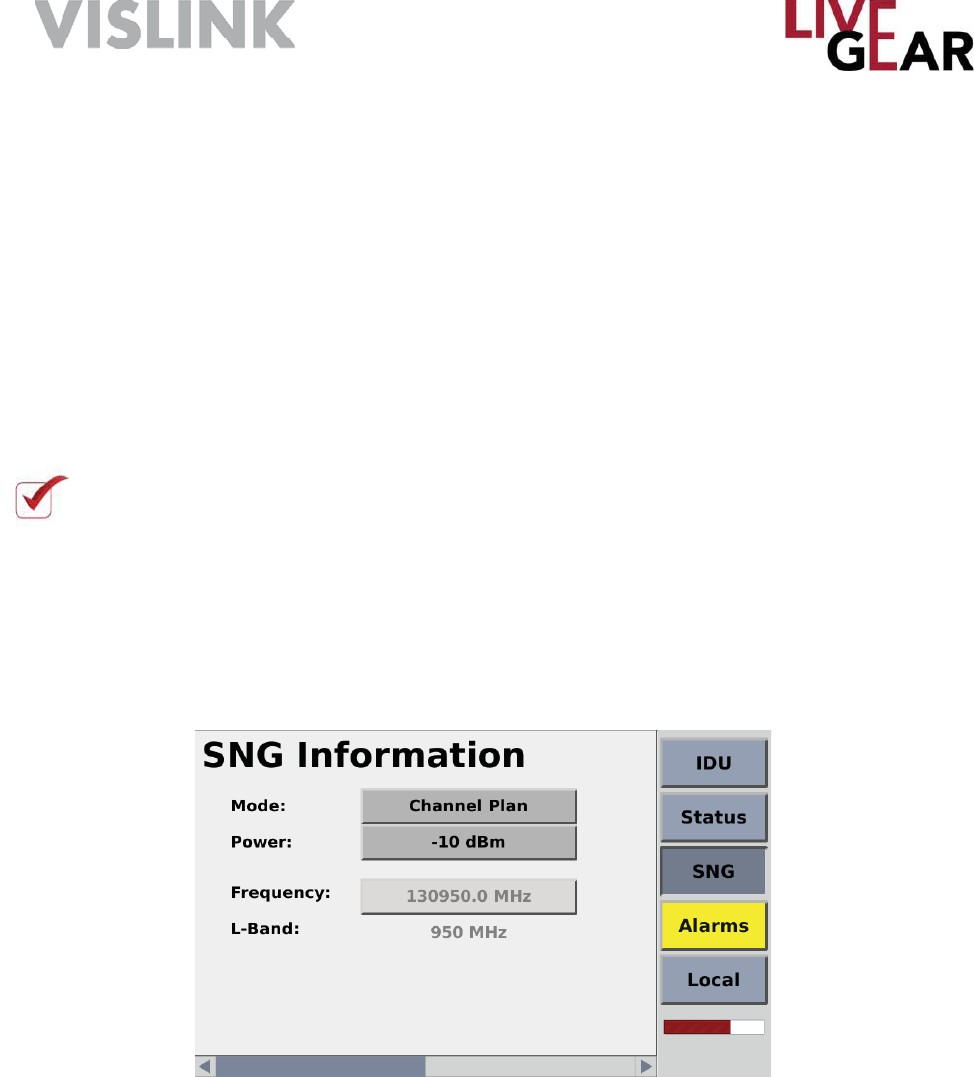
Page 43
NewStream User Guide and Technical Manual
SNG Information - Channel Plan Mode - IDU Touchscreen Control
Press the Frequency Tune button to toggle to the Channel Plan touchscreen, as
shown in Figure 27. When the NewStream is in Satellite Channel Plan Mode, you select
a frequency by scrolling through a pre-confi gured listing of channels. The frequency
selection does not link presets and channels.
You can scroll through the list of channels that are pre-confi gured via the rocker switch
[Figure 5 item G] and press the Enter button [Figure 5 item I] to select the desired
frequency. The Enter button [Figure 5 item I] blinks amber as you scroll through the
list, and reverts back to the last known selected frequency if there is no action for 15
seconds. Channel selection persists from one power cycle to the next.
NOTE: You must fi rst create an SNG Channel Plan via the SNG Frequency Plans
Page in Remote control to use the channel plan setting under Local control with
the IDU touchscreen. Refer to the Channel Plan example in the Satellite Frequency
Plans [SNG] Web interface section.
Figure 27: NewStream SNG Information Touchscreen - Channel Plan Mode
When you operate SNG in Channel Plan Mode, the Block Downconverter Setup
touchscreen is disabled.

Page 44
AirStream User Guide and Technical Manual
Frequency Tuning Example With BUC Enabled
If the BUC Spectrum Non-Inverting LO Type is Low side, the sum of the NewStream
frequency output IF and BUC is equal to:
LO + [L-Band IF from NewStream] = Frequency display
If the BUC LO Type is High Side is Spectrum Inverting, the difference between the
frequency output IF and BUC is equal to:
LO – [L-Band IF from NewStream ] = Frequency display
As the name implies, Spectrum Non-Low Side LO type Inverting does not invert the
Satellite Modulation however, Spectrum Inverting High Side Local Oscillator Type does
invert the spectrum. If a Spectrum Inverting Low Side Block Up-converter is selected,
the NewStream automatically toggles the spectrum inversion from the selection in the
preset. You are not shown this inversion, as the Spectral inversion in the preset refl ects
your selection. This allows the same set of presets to be used regardless of whether a
Low side or High Side Block Up-converter is used.
Example: In KU Satellite operation, a fi xed-spectrum Low Side LO Type non-inverting
[BUC] Block Up-converter frequency @ 13,050 MHz is used.
The KU range is 14,000 - 14,800MHz.
Front Panel State
Enter 13.050 MHz into BUC frequency fi eld and select Spectrum Non-Inverting Low
Side LO Type.
• Desired frequency = 14000 MHz // 13050 MHz + 950 MHz = 14000 MHz // the
L-Band IF tunes to [950MHz] =950MHz
• Desired frequency =14275 MHz // 13050 MHz + 1255 MHz = 14250 MHz // the
L-Band IF tunes to 1255 MHz
SNG Status
The Satellite Status touchscreens consist of four information displays for the current
SNG preset. Each of the pages can be viewed using a swiping motion. The scroll bar at
the bottom of the Status touchscreens indicates the relative position of each screen. For
further information about the listed settings, refer to the Status Web interface section.
Refer above to Figures 14 through 17 for examples of the listed information for SNG
mode.

Page 45
NewStream User Guide and Technical Manual
Steps to Stream Video in SNG Mode
After confi guring SNG Presets, you can continue in Remote mode to create Channel
Plans to allow quick selection of frequencies used to begin transmitting video and audio
signals. Refer to the Web interface Frequency Plans Page [SNG] section below for
more information. The following steps must be followed to begin Satellite transmission
while in Remote Mode. Each of the steps can also be done using the front panel in
Local mode, the buttons and switches used are noted.
1. Confi gure SNG Presets and then select the preset you will use for broadcast.
In Local mode, you would select using the rocker switch [Figure 5 item H] and then
pressing the Enter button [Figure 5 item J].
2. Set frequency tuning mode method:
a. Frequency Tune BUC disabled [L-Band] - refer to Figure 25.
b. Frequency Tune BUC enabled [Ka or Ku-bands] - refer to Figure 27.
c. Channel Plans setup to quickly tune to pre-confi gured and stored frequency
choices - refer to Figure 26.
3. Set the Power level using the RF Level rocker switch to the desired level [Figure 5
item B].
4. Press CW ON to enable the carrier and readjust the power level as needed. It is
recommended that you start on a lower power level. This action starts unmodulated
satellite transmission.
5. Press MOD ON to begin modulated satellite transmission.
6. Either MOD OFF or CW OFF can be pressed to stop transmission.

Page 46
NewStream User Guide and Technical Manual
IDU Touchscreen Last State Displayed
When power is reapplied to the IDU, most of the confi guration options of the
NewStream IDU return to the last operational state, although there are a few exceptions
to this rule. In general, RF energy is not applied upon startup in order to protect
downstream ODUs. Instead, any state variables that control RF energy default to the
powered down state. All other options retain the last state. The following list describes
the state variables explicitly.
Common variables:
o Frequency – Save last state
o Antenna Polarity – Save late state
o Antenna Switch – Save last state
o RF Band – Save last state
Microwave:
o RF Power [Hi/Low/Adj]– Save last state
o Power Amp – Always default to off on powerup
Satellite:
o RF Carrier – Always default to off on power up
o RF Modulation – save last state
Cellular:
o Cell Transmit – Always default to off on powerup
IDU Touchscreen States on Startup or Preset Change
When power is applied to the NewStream IDU, the state of each touchscreen and the
associated buttons display the operational state last confi gured, prior to shut down, with
the following exceptions:
o The PA On / Off OLED [ENG], or carrier on / off OLED [SNG] are always set in
the off or standby state.
o The Cellular On / Standby button is always set in the standby state.
o The 5” touch screen always starts at the default main screen [as shown
in the cover photograph].
o When an ENG or SNG preset is selected and initiated [you must press the Apply
button on front panel to initiate] the Power Amplifi er [PA] or Carrier [CW] OLED
will return to the standby state.
o When a frequency is selected and initiated, the PA or CW OLED will return
to the standby state.
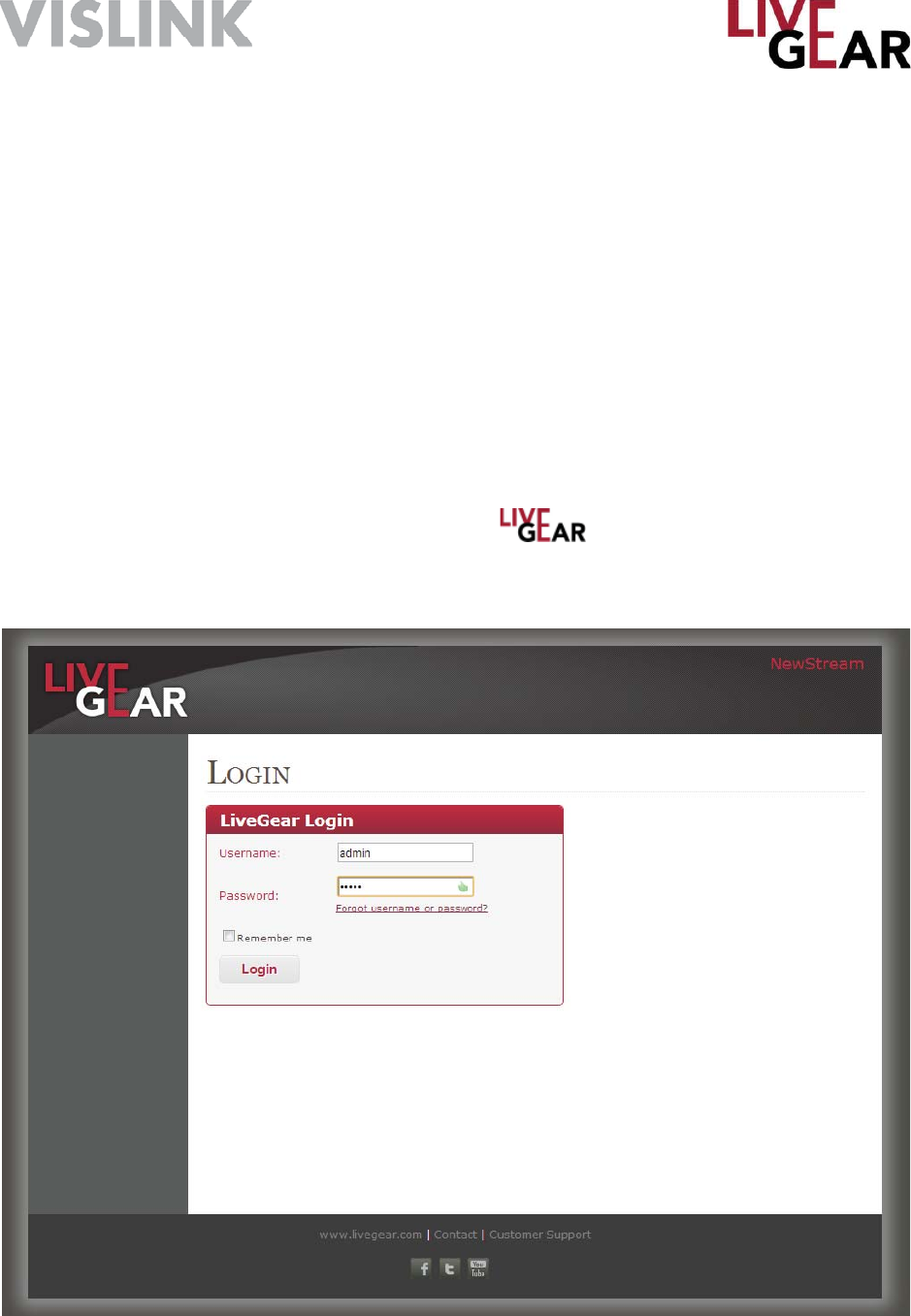
Page 47
NewStream User Guide and Technical Manual
Remote Operation Using the Web Interface
NewStream‘s Web interface provides an alternate means of control and confi guration
for NewStream when the operator selects the Remote control option in NewStream‘s
touchscreen. Figure 29 displays an example of the Web interface in Remote control for
the ENG mode, where multiple operators may confi gure the NewStream using the Web
interface. Figure 31 and 32 display examples of the NewStream‘s SNG and CNG Web
interface while in Local and Remote control modes. To toggle between Remote and
Local control, you must press the Local button on the side menu and then the Local
button displayed in the Confi guration Mode touchscreen, as shown in Figure 20.
The Login page [see Figure below] is displayed when you access the default IP
address http://192.168.1.10/. The Status page appears once you login [see the fi gure
below]. The default User name and Password is admin.
Examples of NewStream‘s various Status pages are shown in Figures 29-32. You
can also access any Status page by clicking the logo. The page displayed is
dependent on the preset selected.
Figure 28: NewStream Login Page

Page 48
NewStream User Guide and Technical Manual
Microwave Status Page
The Microwave [ENG] Status Web page displays the following parameters of the
NewStream transmitter:
• Current Preset
• RF Control
• Encoding Status
• Modulation Status
• Frequency Control
• Antenna Control
• Cellular Control [Upgrade Option]
• Cell Card Information [Upgrade Option]
When you click the Current Preset drop-down, a list of available presets displays,
allowing you to select an alternate. Within the RF Control options section, you are
able to apply power to the Power Amplifi er [PA], the Carrier [CW] and the Modulation
control. The Encoding and Modulation Status section displays read-only information.
You may apply power to Cellular Transmission. The Frequency Control section
provides a means to select Channels and Frequency Bands. The Antenna Control
section provides a means to select the ODU antenna and change the ODU antenna’s
Polarity. The Cellular Card Information section displays the signal strength of each SIM
installed within NewStream.
Confi gure Preset
To display Modify Presets, Frequency Plans, NewStream Settings, Manual Mode and
License Manager, you must leave the Status page by clicking the Setup button. Refer
to the Modify Preset page, as shown in Figure 33. The factory default presets cannot
be modifi ed however, you may save them under a different name and then make
changes to it using the Modify Presets page. Up to 99 new presets may be created for
NewStream.
• Refer to Figures 38 & 39 in the Frequency Plans sections for more information.
• Refer to Figure 41 in the NewStream Settings section for more information.
• Refer to Figures 34 through 37 in the Modify Presets sections for more information
concerning creation of custom presets.
Current Preset
The Current Preset fi eld appears when you use the drop-down to select a previously
confi gured preset. When you click the Apply Preset button, the confi guration is applied
to NewStream and the values that you have selected or modifi ed take effect for the
current video transmission.
Refresh Status
The Refresh Status icon provides a means to update the page. Any entries that
you have revised such as RF, Frequency or Antenna Controls are reloaded using this
option. The Status screen is updated automatically however, under remote control this
button ensures that your settings are updated pro-actively.
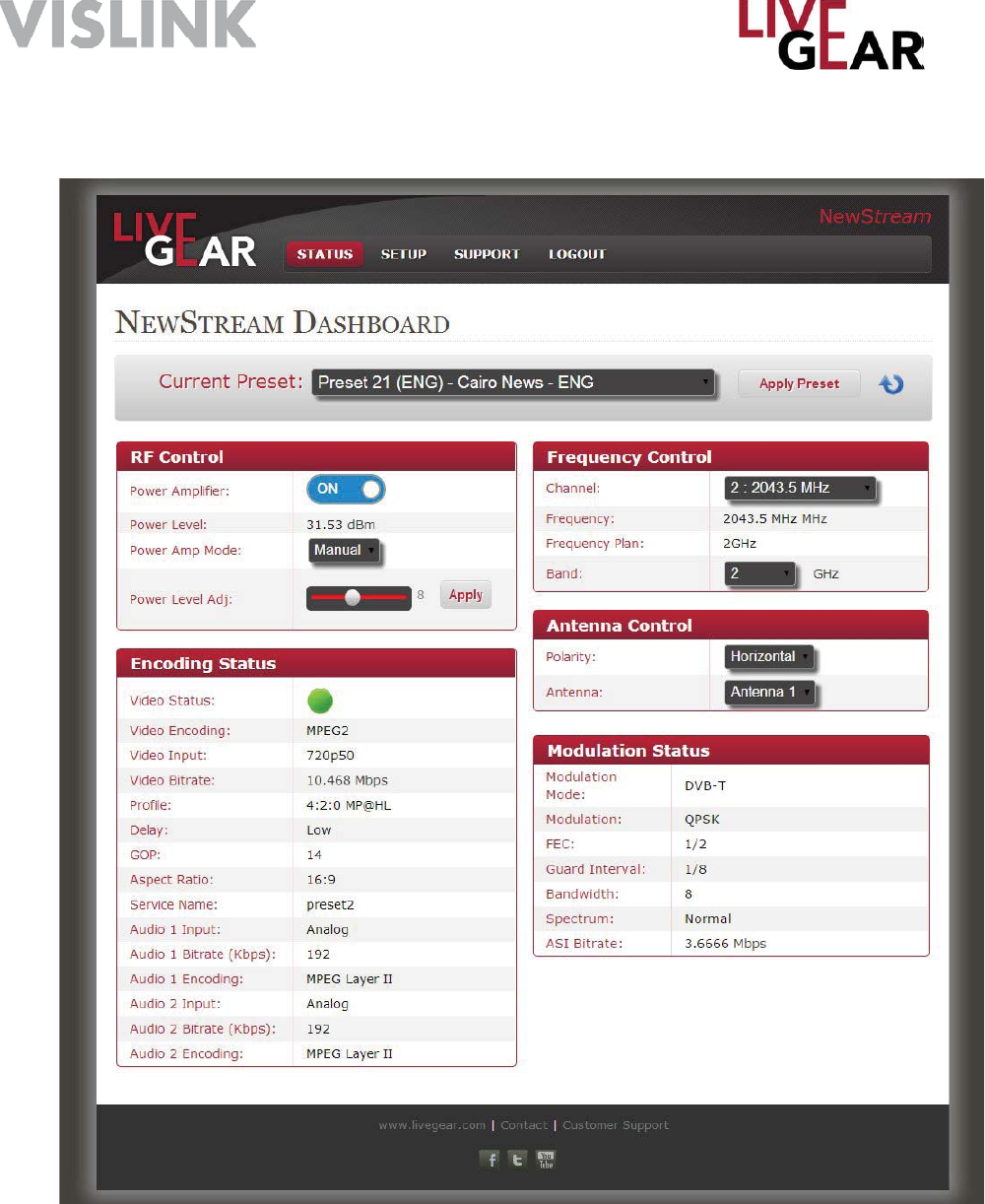
Page 49
NewStream User Guide and Technical Manual
Figure 29: NewStream Status Page [ENG Remote Control Mode]

Page 50
NewStream User Guide and Technical Manual
Microwave Status Page [Continued]
Radio Frequency Control
Power Amplifi er [ENG]
This button allows you to augment NewStream’s transmission capabilities by turning on
the RF power amplifi er. This button is used to toggle the power amplifi er between PA
Standby and PA ON. The default state is Off.
Carrier [SNG Upgrade Option]
This button provides a means to toggle the CW carrier On and Off; enabling the carrier
frequency output or disabling the carrier frequency output. The default state is Off.
Modulation [SNG Upgrade Option]
This button allows you to turn Modulation on or off.
Power Level [ENG]
This fi eld displays the RF output power in dBm of the microwave ODU.
Power Amplifi er Mode
This fi eld allows the selection of a Power Amplifi er Radio Frequency Level of:
• High
• Low
• Manual - if manual is selected, the Power level adjust is active and is used to set
the RF level in 1 dB steps.
Power Level [SNG Upgrade Option]
This fi eld displays the Satellite News Gathering L-Band RF level that is output from the
rear panel L-Band connector.
Power Level Adjust
This fi eld displays the Electronic News Gathering Attenuation to which the NewStream
is calibrated. You can use the arrow buttons to select an Attenuation level from 0 to
31. The range changes depending on which type of ODU is connected, NewStream or
legacy.
Attenuation [SNG Upgrade Option]
This fi eld is used to adjust the L-Band power output in 0.5dB steps. You can use the
arrow buttons to select an Attenuation level from 0 to 40.

Page 51
NewStream User Guide and Technical Manual
Microwave Status Page [Continued]
Encoding Status
This set of fi elds present the settings to which the NewStream’s Encoder is currently
set. These fi elds are read-only.
Manual mode is accessed by the Setup drop-down menu. For further information refer
to the Manual Mode Pages.
Video Status
This LED is lit green when video encoder is sending a signal to the designated receiver.
It is lit red when Video transmission has stopped or when the video encoder is powered
down.
Video Encoding
The Video Encoding fi eld displays one of three options:
• MPEG2
• H.264
• External ASI
Video Input
The Video Input fi eld displays one of the following options:
• NTSC
• NTSC No Pedestal
• PAL
• PAL-M
• PAL-N
• BARS-525
• BARS-625
• 720p50
• 720p59.94
• 1080i50
• 1080i59.94
• SDI-525
• SDI-625
• HD Bars
Video Bitrate
The Video Bitrate value ranges from 0-99.999 Mb/s.
Profi le
The Profi le fi eld Profi le values differ depending on encoding type [H.264 or MPEG2].
The MPEG-2 SD example is:
• 4:2:0 MP@ML
• 4:2:2 P@ML

Page 52
NewStream User Guide and Technical Manual
Microwave Status Page [Continued]
Modulation Status
The Modulation Status fi elds present NewStream’s microwave settings for the selected
preset.
Modulation Mode
This fi eld displays one of the following modulation classes for each microwave preset:
• COFDM-DVB-T — Coded Orthogonal Frequency - Division Multiplexing - Digital
Video Broadcasting — Terrestrial
• LMS-T — Link Modulation Scheme —Terrestrial
• DVB - S — Digital Video Broadcasting — Satellite Mode
• DVB - S2 — Digital Video Broadcasting —Satellite Mode
Modulation
This fi eld displays the following modulation classes for each microwave preset in the
Microwave Settings page. Moving up the scale of modulations allows higher throughput
but at the cost of robustness:
• QPSK — Quadrature phase-shift keying
• 16-QAM — Quadrature amplitude modulation
• APSK — Amplitude Phase-shift Keying [for both 16 and 32-APSK]
• 64 - QAM — Quadrature amplitude modulation
FEC
Forward Error Correction [FEC] or channel coding is a technique used for controlling
errors in data transmission over unreliable or noisy communication channels. This fi eld
displays the FEC for the existing microwave preset. Lower fractions are more robust
to noise and fading but at the cost of reduced information bandwidth. Common FEC
values include:
• 1/4
• 1/2
• 1/3
• 2/3
• 3/4
• 5/6
• 7/8
Guard Interval
The Guard Interval is a method used to prevent interference within distinct
transmissions. The Guard Interval confi gured for the microwave preset is displayed in
this fi eld. The Guard Interval values include:
• 1/32
• 1/16
• 1/8
• 1/4

Page 53
NewStream User Guide and Technical Manual
Microwave Status Page [Continued]
Bandwidth
The Bandwidth value confi gured for the microwave preset is displayed as one of the
following:
• 6 MHz
• 7 MHz
• 8 MHz
• 10 MHz
• 20 MHz
Spectrum
The Spectrum fi eld displays either Normal or Inverted.
ASI Bitrate
The Video Bitrate displayed ranges from 0 to 99.999 Mb/s.
Antenna Polarization Control
The Antenna Polarization Control section presents NewStream’s ODU antenna settings
for the selected preset. The fi elds allow selection of ODU Polarity and the antenna to
which the polarity is to be applied, as shown in Figure 29.
Polarity
This drop-down fi eld allows you to select from the following:
• Vertical
• Horizontal
• Left Circular[LC]
• Right Circular [RC]
Antenna
This fi eld allows for the selection of ODU 1 or 2. Note that the antenna switch function
can be disabled if no antenna switch is being used.
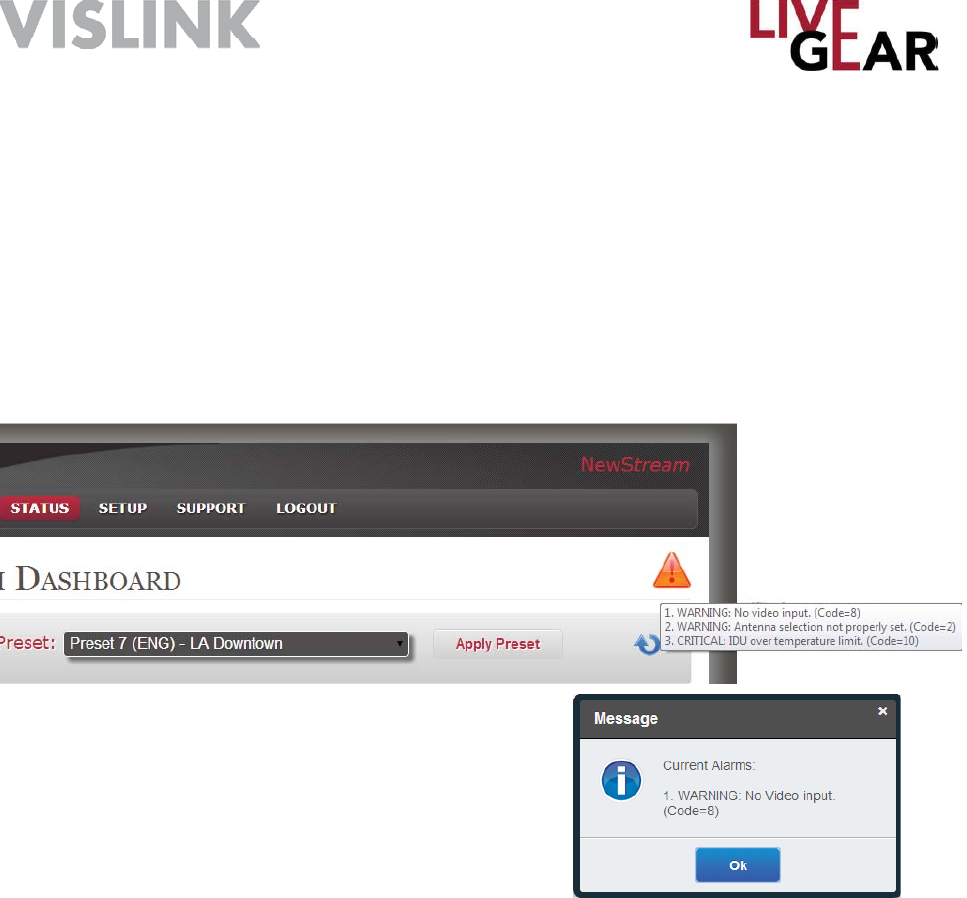
Page 54
NewStream User Guide and Technical Manual
Microwave Status Page [Continued]
Alarm Indicators
When an Alarm is activated on the IDU, it will be indicated on the top, right-hand corner
of the Status page, as shown below in Figure 30. The Alarm may indicate a cautionary
warning or a critical situation, as shown in the example. Click the Alarm icon to display
a Warning/Alert dialog box or mouse over the icon to view alarm details, as shown in
the example.
Figure 30: NewStream Alarm Indicator on Status Page and Message Dialog Box
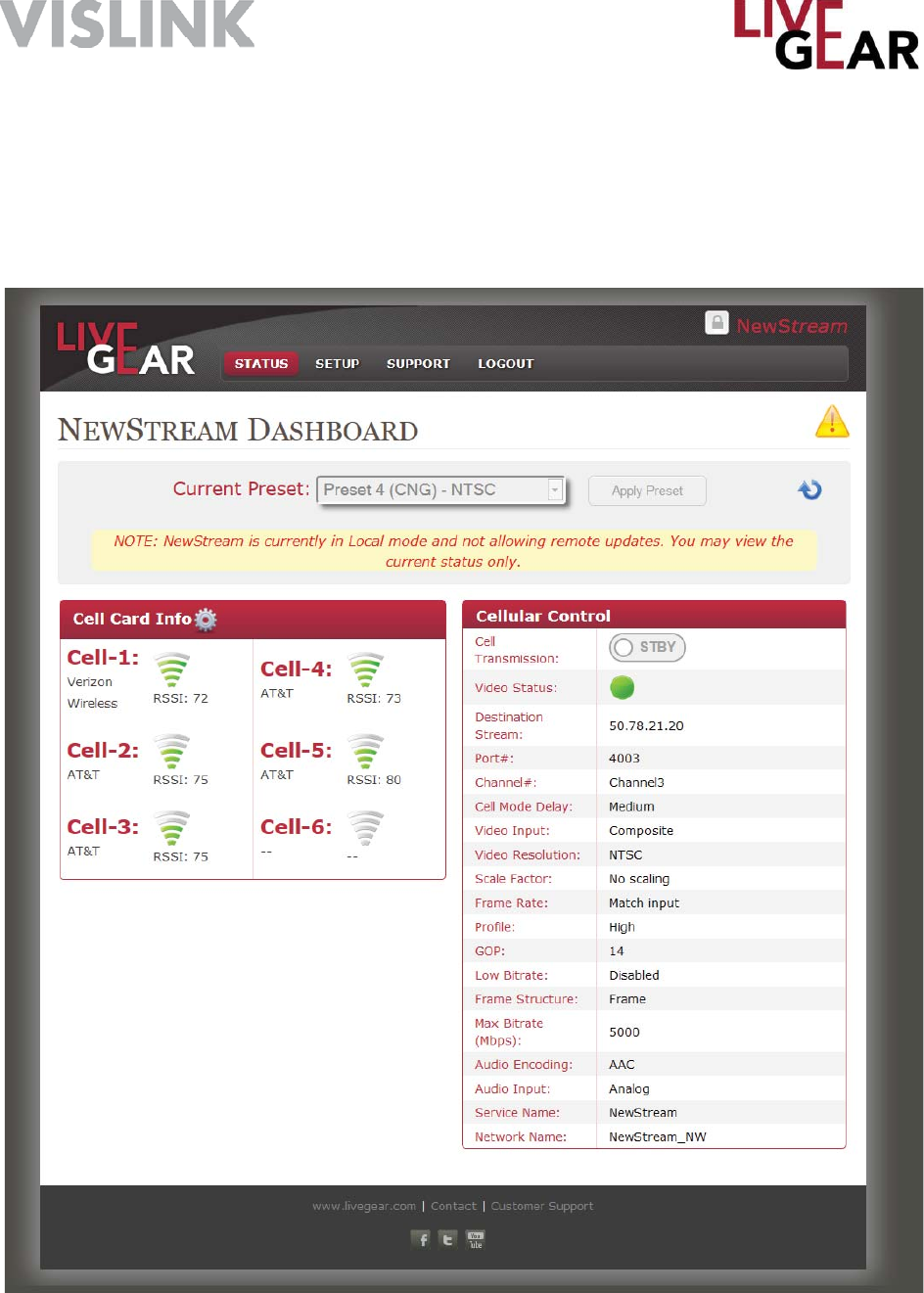
Page 55
NewStream User Guide and Technical Manual
Figure 31: NewStream Status Page [CNG Local Control Mode]
Cellular Status Page
A CNG Preset is displayed in the example below. If you are operating in Remote
Control, you are allowed the choice of changing the preset within the Status page or
initiating Cellular Transmission. Figure 31 shows the system in Local Control, where the
Web page is read-only.

Page 56
NewStream User Guide and Technical Manual
Cellular Status Page [Continued]
Cellular Card Information
This status listing displays each cellular card’s RSSI. The RSSI is the relative received
signal strength in arbitrary units. RSSI is an indication of the power level being received
by the antenna. The lower the RSSI number, the stronger the signal. Refer to the CNG
Touchscreens section for more information.
When you click the manage icon shown within the Cell Card Info box, the Cell
Modem Confi guration dialog box displays providing a means of confi guring each
individual modem of the those available.
Modem #
The Modem number drop-down fi eld allows you to select one of six modems supported
by NewStream.
Mode
The Mode drop-down provides the means to select Auto or Custom Mode.
APN
The Access Point Name is a confi gurable network identifi er used by NewStream when
connecting to a GSM carrier. The carrier examines the APN identifi er to determine the
network connection type for the NewStream transmitter. The APN determines which IP
addresses are to be assigned to NewStream, which security methods to be used, and
how or if, it will be connected to a private network.
Login Name
The Login Name identifi es those administrators that are responsible for the
maintenance of the NewStream cellular modems. Type your user name in this fi eld to
submit your revised modem cofi guration.
Password
Type the Password associated with your Login Name in this fi eld to authenticate the
submission.
PIN
This fi eld provides further authentication with a Personal Identifi cation Number.
Submit or Cancel
To make any changes to a Cell Modem Confi guration, click the Submit button or Cancel
to retain existing settings.
Cellular Control
The Cellular Control Status presents NewStream’s cellular settings for the selected
preset.
Cellular Transmission
This button allows you to turn Cellular Transmission On or Off. when operating in
Remote Controll mode . The default state is STBY. [or Off]

Page 57
NewStream User Guide and Technical Manual
Cellular Status Page [Continued]
Video Status
The Video Status LED idicates the current video transmission state. When lit green, the
video signal is being transmitted to the LiveGear Receiver. When lit red, the signal is not
being transmitted and an alarm state may be present [refer to Figure 31].
Destination Stream
This fi eld displays the IP Address that designates the destination for the cellular video
stream - the LGR’s IP address.
Port #
This fi eld displays the Port number, which ranges from 1 to 65,535.
Channel #
This fi eld displays the LGR Channel number, which ranges from 1 to 6.
Cell Mode [Delay]
The NewStream transmitter has three cellular modes of operation: Low, Medium and
High delay, offering fl exibility for optimizing overall video performance as a function of
cellular link connectivity performance.
Low - this delay mode is used in applications where there is very good 3G/4G
cellular connectivity. This setting minimizes the overall video buffer size and allows
for approximately 1 to 2 seconds of delay over the cellular network. This setting is
to be used in areas where there is intermittent or degrading cell connectivity; in
these areas there is a larger overall packet jitter which leads to an overfl ow of the
video buffering or the loss of video frames.
Medium - this delay mode offers the optimum video quality and an overall delay
of less than 5 seconds while minimizing the loss of video frames. This mode is to
be used with acceptable 3G/4G cellular network coverage.
High - this delay mode uses the largest video buffer size to minimize the loss of
video frames over the cellular link. Use this mode whenever 4G coverage is not
present and 3G services are unreliable. When cell coverage is unknown, High
delay should be used initially.
Video Input
This fi eld displays the selection of Composite or SDI Cellular Video Input for the listed
preset.

Page 58
NewStream User Guide and Technical Manual
Cellular Status Page [Continued]
Video Resolution
The Video Input Resolution fi eld displays the following values:
• 720p50, 720p60, 720p59.94
• 1080i50, 1080i59.94, 1080i60
• NTSC [National Television System Committee]
• PAL [Phase Alternating Line]
Scaling Factor
The Scaling Factor describes the use of magnifi cation in devices to compensate for
differences between size of viewing areas.
Frame Rate
Frame rate, also known as frame frequency and frames per second [FPS], is the
frequency or rate at which NewStream unique consecutive images called frames.
Frame rate is often expressed in frames per second [FPS] and is also expressed in
progressive scan monitors as hertz [Hz].
Profi le
The Profi le fi eld presents the H.264 settings for video, which are also available for
Microwave and Satellite transmission. The Profi le fi eld displays one of the following
values:
• Baseline
• Main
• High
• High 422
GOP
In MPEG encoding, a Group of Pictures [GOP] specifi es the order in which intra-frames
are arranged. The GOP is a group of successive pictures within an MPEG-coded
fi lm and/or video stream. Each MPEG-coded fi lm and/or video stream consists of
successive groups of pictures. The valid range of successive groups of pictures is from
0 to 60.
Low Bitrate
This fi eld displays whether Low Bitrate control is Enabled or Disabled.
Frame Structure
Video frame structure is the division of defi ned lengths of media, such as a sequence of
images in a video, into different fi eld information parts. Video frame structure commonly
defi nes independent key frames, predicted adjacent frames, and bi-directional
frmaes created from the comparison of multiple frames. Key frames contain all of
the information of an image and the predicted and bi-directional frames contain the
difference elements from other frames which results in much lower data that is required
to recreate the images.

Page 59
NewStream User Guide and Technical Manual
Cellular Status Page [Continued]
Max Bitrate
This fi eld displays a range of:
• 256 kilobits per second [kbps]
• 500 kbps
• 768 kbps
• 1.0 Megabit per second [Mbps]
• 1.5 Mbps
• 2.0 Mbps
• 2.5 Mbps
• 3.0 Mbps
• 3.5 Mbps
• 4.0 Mbps
• 5.0 Mbps
• 6.0 Mbps
• 7.0 Mbps
• 8.0 Mbps
• 9.0 Mbps
• 10.0 Mbps
Audio Encoding 1 & 2
The Audio Input Encoding types that are displayed in this fi eld include:
• Off
• MPEG Layer II — MPEG Audio Layer II is a core audio algorithm.
• AAC — Advanced Audio Coding
Audio Input
The Audio Input Encoding values that are displayed in this fi eld include:
• Analog
• SDI Embedded — Serial digital interface [SDI] is a family of video interfaces that
have been standardized by SMPTE. For example, ITU-R BT.656 and SMPTE
259M defi ne digital video interfaces used for broadcast-grade video. This mode
embeds the audio into the SDI stream.
• AES-EBU — The digital audio standard frequently called AES/EBU [aka AES3], is
used for carrying digital audio signals between various devices.
Service Name
This fi eld displays the name of the cellular service provider.
Network Name
The Network Name or SSID, differentiates one WLAN from another, so all Access
Points and all devices attempting to connect to a specifi c WLAN must use the same
SSID to enable effective roaming. As part of this association process, a wireless client
must have the same SSID as that entered in the Access Point or it will not be permitted
to join the BSS.
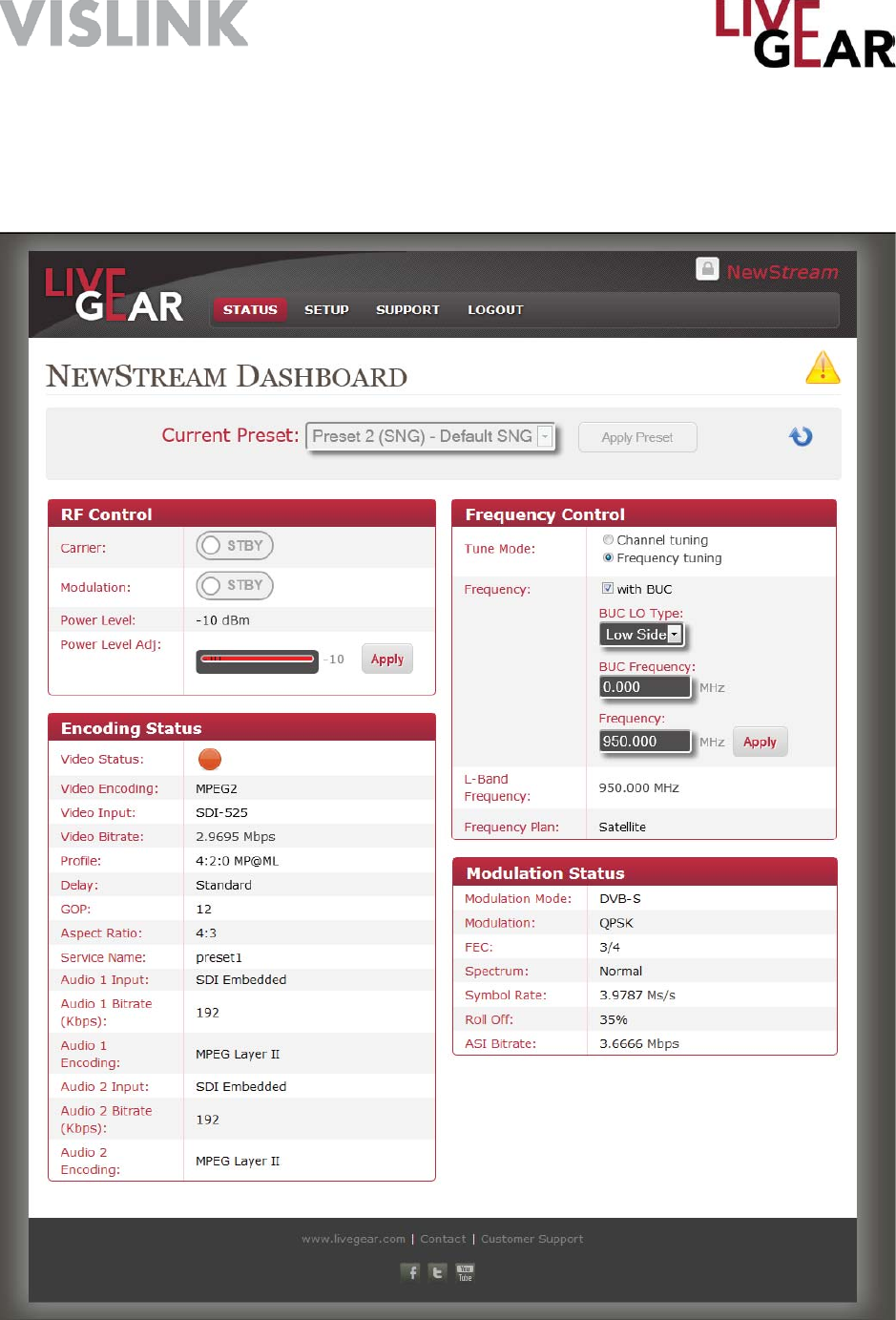
Page 60
NewStream User Guide and Technical Manual
Satellite Status Page
The Status Web page that displays when you select an SNG preset is shown in the
fi gure below. When in Remote control, you are able to change presets using the Current
Preset drop-down and the Appy Preset button.
Figure 32: NewStream Status Page [SNG Remote Control Mode]

Page 61
NewStream User Guide and Technical Manual
Satellite Status Page [Continued]
Radio Frequency Control
Carrier
This button provides a means to toggle the CW carrier On and Off; enabling the carrier
frequency output or disabling the carrier frequency output. The default state is Off.
Modulation
This button allows you to turn Modulation on or off.
Power Level
This fi eld displays the Satellite News Gathering L-Band RF level that is output from the
rear panel L-Band connector.
Power Level
This fi eld displays the Satellite News Gathering L-Band RF level that is output from the
rear panel L-Band connector.
Power Level Adjust
This fi eld is used to adjust the L-Band power output in 0.5dB steps. You can use the
arrow buttons to select an Attenuation level from 0 to 40.
Encoding Status
This set of fi elds present the settings to which the NewStream’s Encoder is currently
set. These fi elds are read-only.
Video Status
This LED is lit green when video encoder is sending a signal to the designated receiver.
It is lit red when Video transmission has stopped or when the video encoder is powered
down.
Video Encoding
The Video Encoding fi eld displays one of three options:
• MPEG2
• H.264
• External ASI

Page 62
NewStream User Guide and Technical Manual
Satelitte Status Page [Continued]
Video Input
The Video Input fi eld displays one of the following options:
• NTSC
• NTSC No Pedestal
• PAL
• PAL-M
• PAL-N
• BARS-525
• BARS-625
• 720p50
• 720p59.94
• 1080i50
• 1080i59.94
• SDI-525
• SDI-625
• HD Bars
Video Bitrate
The Video Bitrate value ranges from 0-99.999 Mb/s.
Profi le
The Profi le fi eld Profi le values differ depending on encoding type [H.264 or MPEG2].
The MPEG-2 SD example is:
• 4:2:0 MP@ML
• 4:2:2 P@ML
Delay
The Delay fi eld displays one of these three values:
• Low
• Standard
• Ultra Low
GOP
The values of successive groups of pictures ranges from 0 to 60.
Aspect Ratio
SD formats allow an Aspect ratio of either 4:3 or 16:9. HD formats aloow 16:9 only. The
Aspect Ratio fi eld displays one of these two values:
• 4:3
• 16:9
Service Name
This fi eld displays the 16 character service information name for the current preset.

Page 63
NewStream User Guide and Technical Manual
Satelitte Status Page [Continued]
Audio Input 1 & 2
The Audio Input Encoding values that are displayed in this fi eld include:
• Test Tone
• Analog
• SDI Embedded
• AES-EBU Balanced
• AES-EBU Unbalanced
Audio Bitrate [kbps] 1 & 2
The Audio Bitrate values for Audio 1 & 2 are displayed in this fi eld.
Audio Encoding 1 & 2
The Audio Input Encoding types that are displayed in this fi eld include:
• Off
• MPEG Layer I — MPEG Audio Layer I is a core audio algorithm
• MPEG Layer II — MPEG Audio Layer II is a core audio algorithm.
• Linear PCM — Pulse-code modulation
Frequency Control
The Frequency Control status provides a means to select the microwave, cellular
and satellite Channel and Band and to view the frequency at which NewStream is
calibrated. These settings can be modifi ed using the Frequency Plan page, as shown in
Figures 31 & 32.
Tune Mode
• Channel Tuning - Channel Tuning provides a means to confi gure preset
frequencies that you can employ when in SNG operation from the front panel in
Local Control [or also in Remote Control]. These frequencies are set up within
Satellite Channels while in Remote control.
• Frequency Tuning - This method of frequency selection can gbe done while
in Local or Remote control, as described in the touchscreen SNG Operation
section above and also in the Frequency Plans Web Page section below. The
frequency tuning can be set for Block-upconverter [BUC] Disabled [L-Band] or
BUC Enabled, as described below.
Channel
The frequency Channel can be selected using this drop-down fi eld. Channel options
depend on the frequency band in which you are operating. There are standard
frequencies broadcasters use, or which can be created. The frequency channel displays
the list of stored channels for the RF band in use. This fi eld displays the name of the
frequency channel that NewStream is set. This fi eld can be modifi ed in the Frequency
Settings page in Remote control. Refer to the Frequency Plans Page [SNG].

Page 64
NewStream User Guide and Technical Manual
Satelitte Status Page [Continued]
Frequency
This box displays the BUC Frequency for which NewStream is currently set.
With BUC [Block Up-Converter Enabling]
The block up-converter [BUC] is used in the transmission [uplink] of satellite signals. It
converts a band of frequencies from a lower frequency to a higher frequency. Modern
BUCs convert from the L-Band to Ku-band, C-band and Ka-band.
• BUC LO Type: This fi eld displays the BUC Local Oscillator [LO] Type frequency
for which NewStream is currently set. You can select Low or High Side for your
SNG system’s Local Oscillator.
• BUC Frequency: This fi eld displays the BUC Frequency for which NewStream
is currently set.
• Frequency: This fi eld displays the Frequency for which NewStream is currently
set.
L-Band Frequency
The ODUs operate on L-Band with BUC disabled. This fi eld displays the seleced
L-Band frequency.
Frequency Plan
This fi elld displays Satellite when using a SNG Preset.
Apply
You can reset frequency confi gurations by clicking the Apply button.

Page 65
NewStream User Guide and Technical Manual
Satelitte Status Page [Continued]
Modulation Status
The Modulation Status fi elds present NewStream’s microwave settings for the selected
preset.
Modulation Mode
This fi eld displays one of the following modulation classes for each microwave preset:
• COFDM-DVB-T — Coded Orthogonal Frequency - Division Multiplexing - Digital
Video Broadcasting — Terrestrial
• LMS-T — Link Modulation Scheme —Terrestrial
• DVB - S — Digital Video Broadcasting — Satellite Mode
• DVB - S2 — Digital Video Broadcasting —Satellite Mode
Modulation
This fi eld displays the following modulation classes for each microwave preset in the
Microwave Settings page. Moving up the scale of modulations allows higher throughput
but at the cost of robustness:
• QPSK — Quadrature phase-shift keying
• 16-QAM — Quadrature amplitude modulation
• APSK — Amplitude Phase-shift Keying [for both 16 and 32-APSK]
• 64 - QAM — Quadrature amplitude modulation
FEC
Forward Error Correction [FEC] or channel coding is a technique used for controlling
errors in data transmission over unreliable or noisy communication channels. This fi eld
displays the FEC for the existing microwave preset. Lower fractions are more robust
to noise and fading but at the cost of reduced information bandwidth. Common FEC
values include:
• 1/4
• 1/2
• 1/3
• 2/3
• 3/4
• 5/6
• 7/8
Spectrum
The Spectrum fi eld displays either Normal or Inverted.

Page 66
NewStream User Guide and Technical Manual
Satellite Status Page [Continued]
Symbol Rate
Symbol Rate [aka baud or modulation rate] is the number of symbol changes [i.e.
waveform changes or signalling events] made to the transmission medium per second
using a digitally modulated signal or a line code. The Symbol Rate is expressed in Mega
symbols/second [Ms/s]. The valid range is 1.0000-36.0000 Ms/s.
Roll Off
Roll-off describes the steepness of a transmission function with frequency, in connection
with fi lter circuits in the transition between a passband and a stop band.
Values of Roll-off are expressed in percentages, ranging from:
• 35%
• 25%
ASI Bitrate
The Video Bitrate displayed ranges from 0 to 99.999 Mb/s.
Modify Presets Page
While viewing a Status page, click the Setup button to display the drop-down menu. The
menu displays the following options:
• Modify Presets
• Frequency Plans
• NewStream Settings
• Manual Mode
• License Manager
Select Modify Presets to begin creating custom confi gurations for SNG, ENG and CNG
transmission in the page shown in Figure 33. NewStream is confi gured with three factory
default presets with the ability to create up to 99 custom presets. You can modify each
preset name and its type in the Modify Presets page, as shown in the fi gure. You can
confi gure additional settings for each custom preset by clicking the confi gure preset
icon. Presets marked with the padlock symbol are factory defaults and cannot be
modifi ed but can be used as a template for your custom presets. The active preset is
highlighted
highlighted.
In the Modify Presets page you can use the Export tool to save custom presets to a
fi le or to other IDUs. Additionally, you can import presets from a directory on your PC, to
another IDU or to a USB fl ash drive using the tool which loads custom presets from
a fi le. This feature can not be implemented while the system is transmitting.
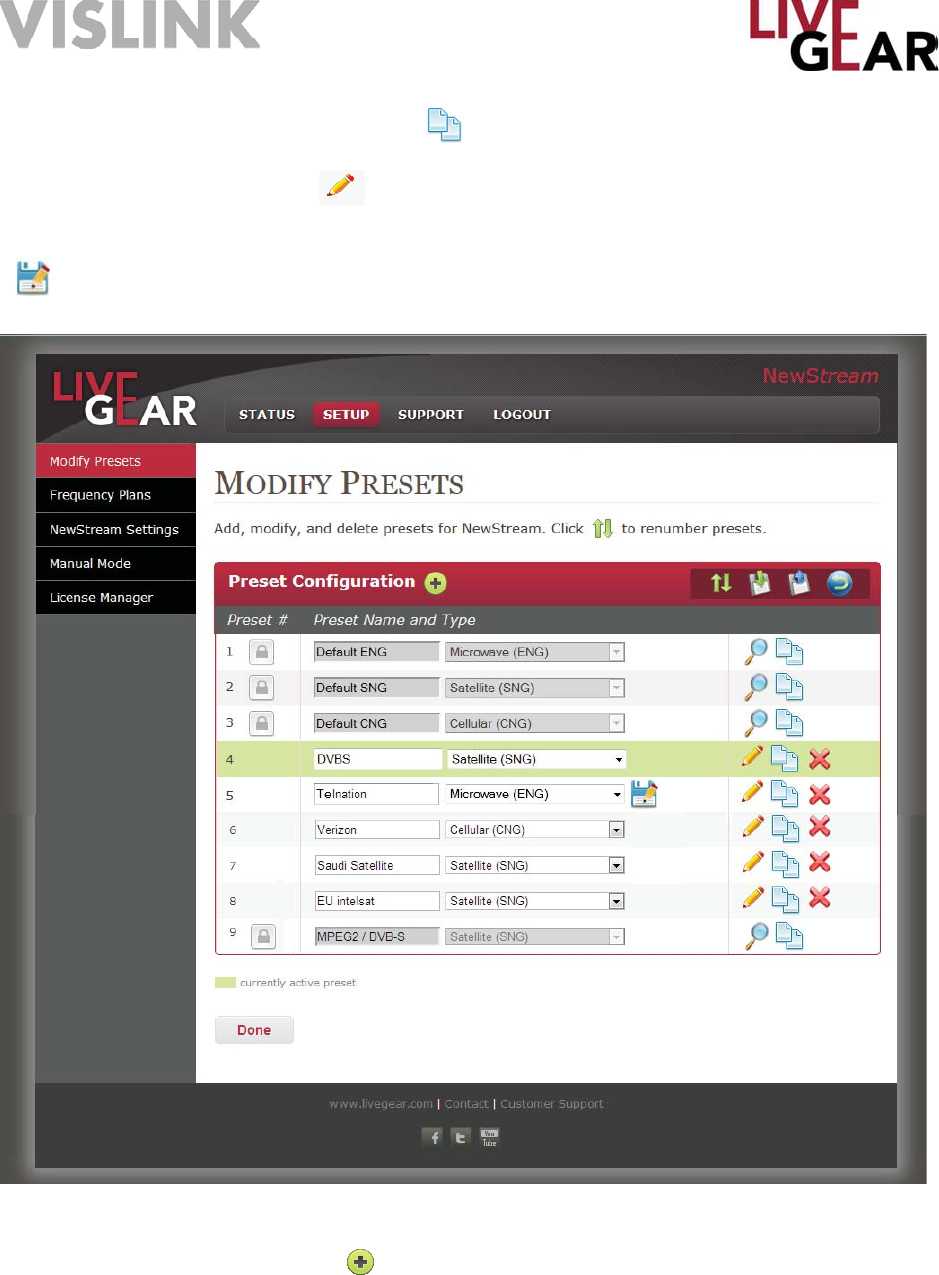
Page 67
NewStream User Guide and Technical Manual
To create customized presets, click the copy tool to add a similar preset with the
default parameters. This new preset is listed at the last entry fi eld and you can begin
customizing it by clicking the confi gure preset icon. Confi rm that you want to leave
the Modify Presets page and you are directed to a set up page that is similar to the
page shown in Figure 33. You may rename the copy and save it by clicking the save
icon.
Figure 33: NewStream Modify Presets Page
Add Preset
When you click the Add Preset button, a Create Preset dialog pop up appears,
providing a means to type a new preset name and choose a type. Click the Create
Preset button in this dialog pop up and Save Changes in the Modify Preset page.

Page 68 NewStream User Guide and Technical Manual
Preset Confi guration
Preset Number [#]
The Preset Number can be reordered. Click and drag the blue circle found
in the column to the left of the Preset number [#] column to reorder the preset list. Click
Save Changes to retain your modifi cation of the Preset Numbers.
Preset Name
Specify an alphanumeric name of up to 32 characters for each preset. You may also
use spaces and the following special characters: _ - ( ) / for the Preset Names. Note
that preset names longer than 16 characters will scroll on the front panel 16 x 2 Preset
display to show the complete name and then only show the fi rst 16 characters.
Preset Type
This drop-down fi eld provides a choice of Cellular, Satellite, Microwave or combinations
of such for NewStream transmissions. The choices include:
• Microwave [ENG]
• Cellular [CNG]
• Satellite [SNG]
• Microwave & Cellular [ENG/CNG (Upgrade Option)]
• Satellite & Cellular [SNG/CNG (Upgrade Option)]
Export Presets to a File
Use the tool to save custom presets to a fi le. You can export presets in a directory
on your PC, a shared server for other operators to access or on a USB fl ash drive.
Import Presets from a File
Use the tool to load custom presets from a fi le. This feature can not be implemented
while the system is transmitting. You can import a preset from a directory on your PC,
a shared server or on a USB fl ash drive. See the Preset Export and Import section to
learn how to Import and Export Presets in Local control.
Restore Preset Confi guration
Use the tool to restore preset confi guration to the factory defaults and to remove all
custom presets.
View Preset Settings
Use the tool to view default preset settings.
Save a Preset
Click the Save icon to create a copy of a preset or to save modifi cations to an
existing preset.
Copy a Preset
Use the tool to copy a selected preset. This is the action that allows you to create a
customized preset. Once you have copied a default or another customized preset, save

Page 69
NewStream User Guide and Technical Manual
it with a unique name and confi gure its parameters as needed for your ENG, CNG or SNG
broadcasts.
Delete a Preset
Use the tool to delete a selected preset.
Done
Click the Done button once you’ve fi nished viewing the settings in the Modify Presets
page. When you click Done no changes will be saved as you leave the page.
Save Changes
To retain any changes to the listed custom presets as well as renumbering changes to the
listed custom presets, be sure to click the Save button once you’ve fi nished reordering
listed presets in the Modify Presets page. This button appears in the Reorder Presets
page.
Factory Default Presets
The NewStream IDU is shipped with three default presets:
• Default ENG Microwave preset
• Default SNG Satellite preset
• Default CNG Cellular H.264 preset
The default presets are read-only but you can copy each default preset and rename it for
future use and modifi cation. Examples of the settings for the Microwave preset are listed
below:
Default ENG Preset
Encoder Settings
Video Settings
Video Encoding: MPEG2
Video In: SDI-525
SDI Horizontal Resolution: 720
Aspect Ratio: 4:3
Closed Captioning: Off
VBI: Off
Encoder Settings
Profi le: 4:2:0 MP@ML
GOP: 12 Frames [1-60]
Delay: Standard
Auto Bitrate: On
Video Bitrate: 5.529 Mb/s [0-99.999]
Remux: Off
Spectrum: Invert
Audio Settings
Audio 1 Encoder: MPEG Layer II
Audio 1 Input: SDI Embedded
Audio 1 Mode: Dual Mono
Audio 1 Bitrate: 192 [kbs]
Audio 2 Encoder: MPEG Layer II
Audio 2 Input: SDI Embedded
Audio 2 Mode: Dual Mono
Audio 2 Bitrate: 192 [kbs]
Wayside Data
Format: Off
Baud Rate: 19200

Page 70
NewStream User Guide and Technical Manual
Default ENG Preset [Continued]
Encryption Settings
Encryption Mode: Off
Security Key: [Undefi ned & Hidden]
Transport Stream
Service Name: preset1
Network Name: pre1_nw
Program ID: [210]
Network ID: [211]
Transport ID: [212]
Video PID: [213]
PCR PID: [214]
Audio A PID: [215]
Audio B PID: [216]
Data PID: [217]
Modulation Settings
Modulation Mode: DVB-T
Spectrum: Normal
Modulation: QPSK
FEC: 1/2
Guard Interval: 1/8
Bandwidth: 8 MHz
Cellular Settings
Cellular
Cell Mode Delay: Low
Destination Stream: 8.8.8.8
Port #: 4001
Video
Video Input: Composite
Resolution: NTSC
Scale Factor: No Scaling
Frame Rate: Match Input
Encoder
Profi le [H264]: Baseline
GOP: 35 Frames [1-60]
Low Bitrate: Enabled
Frame Structure: MBAFF
Encoder Bitrate: 50 [0 to 99.999]
Transport Stream
Service Name: cell_vislink
Network Name: cell_vislink_nw
Program ID: [310]
Network ID: [311]
Transport ID: [312]
Video PID: [313]
PCR PID: [314]
Audio A PID: [315]
Audio B PID: [316]
Data PID: [317]
Audio
Audio Encoding: MPEG Layer II
Audio Input: SDI Embedded
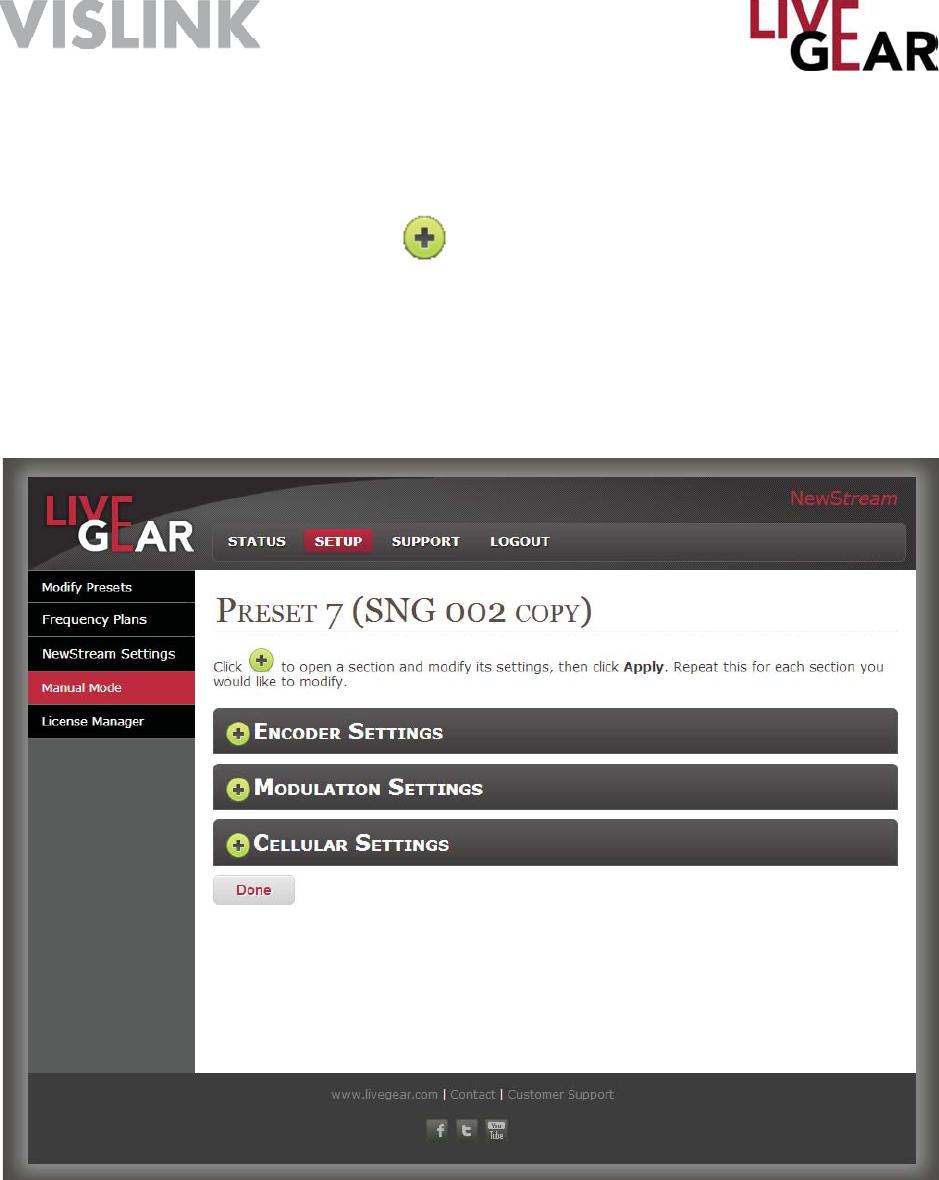
Page 71
NewStream User Guide and Technical Manual
Modify Presets Encoder Settings
Once expanded, the Encoder Settings appear, as shown in Figure 35. This set of fi elds
allows the confi guration of ENG, SNG or CNG options. The encoder settings fi elds
include Video, Audio, Encoder and Encryption settings, as well as Transport Stream
and Wayside Data confi guration fi elds.
Figure 34: NewStream Modify Presets Setup Page - Collapsed
Modify Presets Setup Page
When you select the Modify Presets menu item and confi rm this action, the following
setup page displays, allowing you to modify the NewStream transmitter’s preset. The
example shown is a SNG Preset that has been copied from the default SNG Preset [see
the fi gure below]. When you click the button, the Encoder, Modulation or Cellular
Settings Modify Presets Web options appear. Note that Modifying Presets is used to
revise parameters and have the changes applied immediately, this automatically allows
you to adjust NewStream‘s operating confi guration when transmission parameters
change. The Modify Presets feature is designed to provide operational fl exibility as
needed.
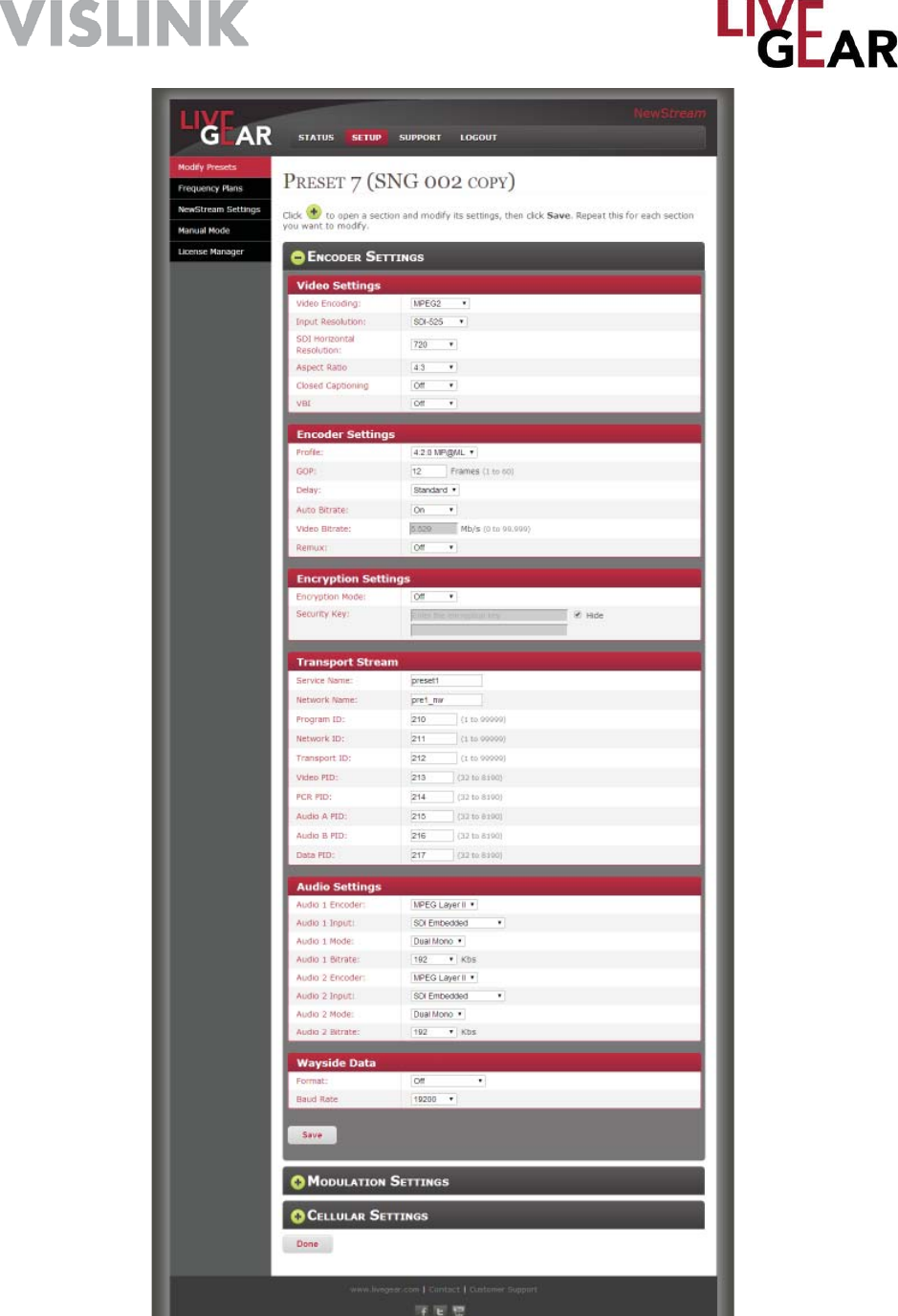
Page 72
NewStream User Guide and Technical Manual
Figure 35: Modify Presets Encoder Settings Page

Page 73
NewStream User Guide and Technical Manual
Modify Presets Encoder Settings
Video Settings
Video Encoding
The Video Encoding drop-down fi eld allows the selection of one of three options:
• MPEG2
• H.264
• External ASI
Input Resolution
The Video In drop-down fi eld allows the selection of one of the following options:
• NTSC
• PAL
• PAL-M
• PAL-N
• BARS-525
• BARS-625
• 720p50
• 720p59.94
• 1080i50
• 1080i59.94
• SDI-525
• SDI-625
• HD Bars
SDI Horizontal Resolution
The SDI Horizontal Resolution drop-down fi eld allows the selection of one of the
following options:
• 720
• 704
• 544
• 528
• 480
• 352
Aspect Ratio
The Aspect Ratio type drop-down fi eld allows the selection of one of three options:
• 4:3
• 16:9

Page 74
NewStream User Guide and Technical Manual
Modify Presets Encoder Settings [Continued]
Closed Captioning
The Closed Captioning drop-down fi eld allows the selection of one of three options:
• Off
• CC-608
• CC-708
VBI
The Vertical Blanking Interval option can be enabled with the selection of On.
Encoder Settings
Profi le
The Profi le type drop-down fi eld allows the selection of one of two options:
• 4:2:0 MP@ML
• 4:2:2 P@ML
GOP
In MPEG encoding, a Group of Pictures [GOP] specifi es the order in which intra-frames
are arranged. The GOP is a group of successive pictures within an MPEG-coded
fi lm and/or video stream. Each MPEG-coded fi lm and/or video stream consists of
successive groups of pictures. The valid range of successive groups of pictures is from
0 to 60. For “Intra Refresh,” enter 0 in this fi eld.
Delay
The Delay type drop-down fi eld allows the selection of one of three options:
• Low
• Standard
• Ultra
Auto Bitrate
The Automatic Bitrate option can be enabled with the selection of On.
Video Bitrate
The Video Bitrate value ranges from 0-99.999 Mb/s
Remux
The Remux option can be enabled with the selection of On.

Page 75
NewStream User Guide and Technical Manual
Modify Presets Encoder Settings [Continued]
Encryption Settings
The Encryption Settings provide the selection of Encryption Mode and the Security Key.
Encryption Mode
This fi eld allows selection of the following Encryption Modes for the microwave preset:
• BISS1 — Basic Inter-operable Scrambling System, usually known as BISS, is a
satellite signal scrambling system.
• BISSE — Basic Inter-operable Scrambling System - Encrypted
• Off
Security Key
Type a key in this fi eld to apply encryption to NewStream transmissions.
Hide Characters
When the check box is selected, characters will not appear in the Security Key entry
fi eld.
Transport Stream
The following entry fi elds are used by the system to differentiate NewStream Transport
Streams.
Service Name
This fi eld provides a means to differentiate the NewStream Transport Stream with a
unique Service Name.
Network Name
This fi eld provides a means to differentiate the NewStream Transport Stream with a
Network Name.
Program ID
This fi eld provides a means to differentiate the NewStream Transport Stream with a
Program Identifi cation [valid IDs range from 1 to 99999].

Page 76
NewStream User Guide and Technical Manual
Modify Presets Encoder Settings [Continued]
Network ID
This fi eld provides a means to differentiate the NewStream Transport Stream with a
unique Network Identifi cation [valid IDs range from 1 to 99999].
Transport ID
This fi eld provides a means to differentiate the NewStream Transport Stream with a
unique identifi cation [valid IDs range from1 to 99999].
Video PID
This fi eld displays the Video Packet Identifi cation for the NewStream Transport Stream
[valid IDs range from 32 to 8190].
PCR PID
This fi eld displays the Program Clock Reference Packet Identifi cation for the
NewStream Transport Stream [valid IDs range from 32 to 8190].
Audio A & B PID
This fi eld displays the Audio A and B Packet Identifi cation for the NewStream Transport
Stream [valid IDs range from 32 to 8190].
Data PID
This fi eld displays the Data Packet Identifi cation for the NewStream Transport Stream
[valid IDs range from 32 to 8190].
Audio Settings
Audio 1 & 2 Encoder
The Audio Encoding parameters that are available in this fi eld include:
• MPEG Layer I - MPEG Audio Layer I is a core audio algorithm.
• MPEG Layer II - MPEG Audio Layer II is a core audio algorithm.
• Linear PCM - Pulse-code modulation
• Off
Audio 1 & 2 Input
The Audio Input parameters that are available in this fi eld include:
• Test Tone
• Analog
• SDI Embedded
• AES-EBU Balanced
• AES-EBU Unbalanced

Page 77
NewStream User Guide and Technical Manual
Modify Presets Encoder Settings [Continued]
Audio 1 & 2 Mode
The Audio Mode parameters that are available in this fi eld include:
• Stereo
• Dual Mono
Audio 1 & 2 Bitrate
This drop-down fi eld presents a range of:
• 128 kilobits per second [kbps]
• 160
• 192
• 224
• 256
• 320
• 384
Wayside Data
Format
The Wayside Data Format parameters that are available in this fi eld include:
• Off
• TTV
• CJM2 (Normal)
• Low Delay CJM2
Baud Rate
The Baud Rate parameters that are available in this fi eld include:
• 1200
• 2400
• 4800
• 9600
• 19200
• 38400
• 57600
• 115200
Apply
Click the Apply button to confi gure the encoder settings and submit preset changes to
the IDU.
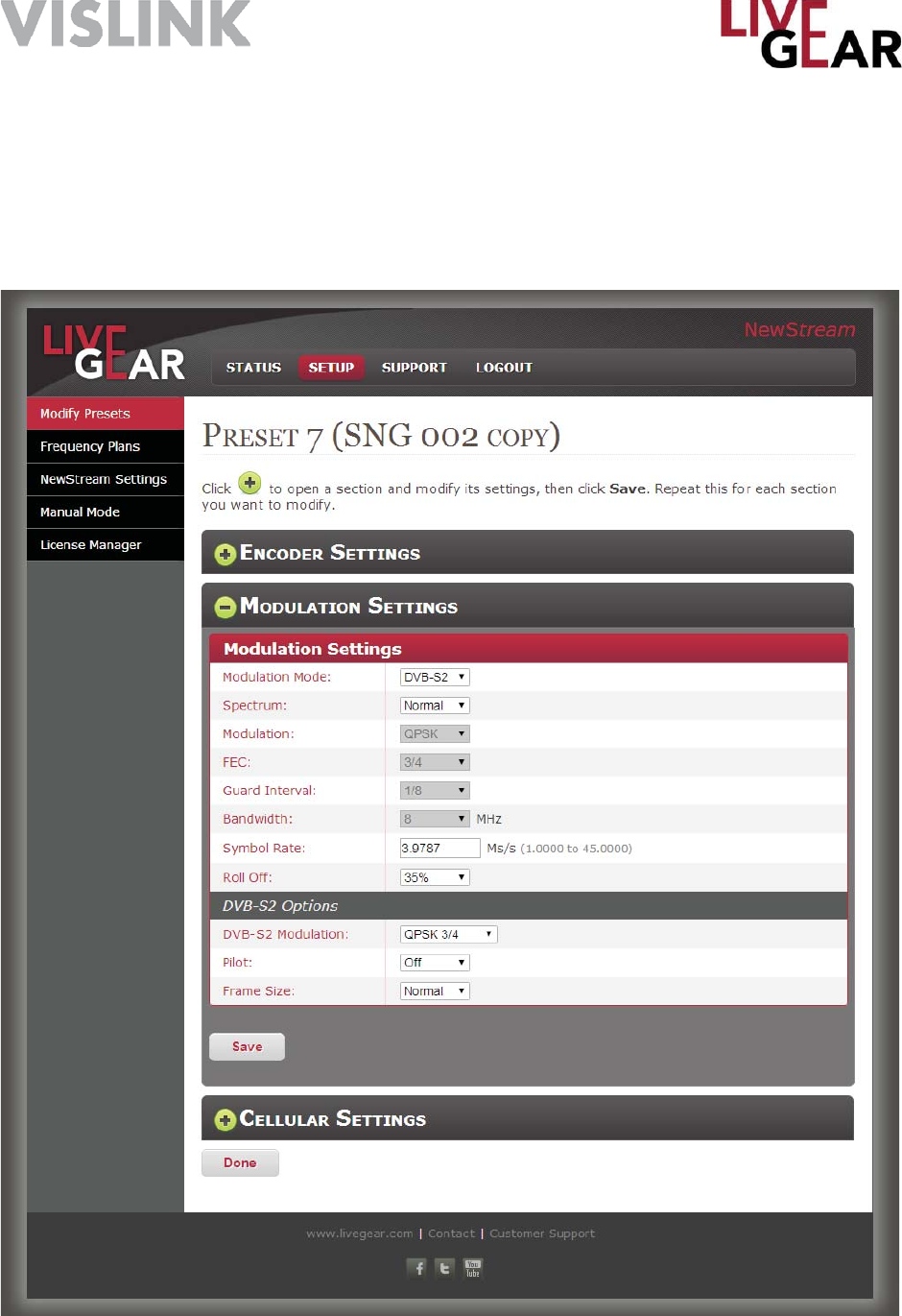
Page 78
NewStream User Guide and Technical Manual
Figure 36: Modify Presets Modulation Settings Page
Modify Presets Modulation Settings
The Modulation Settings for preset modifi cation Setup appears as shown in the fi gure
below. This set of fi elds allows the confi guration of ENG or SNG modulation settings.
The modulation settings fi elds include modulation mode, spectrum, FEC, guard interval,
bandwidth, symbol rate, roll off and DVB-S2 options confi guration fi elds.

Page 79
NewStream User Guide and Technical Manual
Modify Presets Modulation Settings [Continued]
Modulation Settings
Modulation Mode
The Modulation Modes that are available are:
• DVB-T
• LMS-T
• DVB-S [SNG only]
• DVB-S2 [SNG only]
Spectrum
The choices for Spectrum are Normal or Inverted.
Modulation
This fi eld displays the following modulation classes that can be selected for each
microwave, cellular or satellite preset found in the Modify Presets page. This list is
combines the values for both DVB-T and DVB-S modulations. These modulation options
will change for ENG, CNG and SNG presets.
• QPSK — Quadrature Phase-Shift Keying
• 16-QAM — Quadrature amplitude modulation
• APSK — Amplitude Phase-shift Keying for both 16 & 32 APSK
• 64-QAM — Quadrature Amplitude Modulation
FEC
Forward Error Correction [FEC] or channel coding is a technique used for controlling
errors in data transmission over unreliable or noisy communication channels. This fi eld
allows selection of the FEC for the existing microwave preset. The FEC values include:
• 1/2
• 2/3
• 3/4
• 5/6
• 7/8
Guard Interval
The Guard Interval is a method used to prevent interference within distinct transmissions
The Guard Interval confi gured for the microwave preset is displayed in this fi eld. The
Guard Interval values include:
• 1/32
• 1/16
• 1/8
• 1/4

Page 80
NewStream User Guide and Technical Manual
Modify Presets Modulation Settings [Continued]
Bandwidth
The 6, 7 and 8 MHz bandwidths are used for DVB-T and that 10 and 20 MHz are used
for LMS-T.
• 6 MHz
• 7 MHz
• 8 MHz
• 10 MHz
• 20 MHz
Symbol Rate
Symbol Rate [aka baud or modulation rate] is the number of symbol changes [i.e.
waveform changes or signalling events] made to the transmission medium per second
using a digitally modulated signal or a line code. The Symbol Rate is expressed in
Mega symbols/second [Ms/s]. The valid range is 1.0000-36.0000 Ms/s.
Roll Off
Roll-off describes the steepness of a transmission function with frequency, in
connection with fi lter circuits in the transition between a passband and a stop band.
Values of Roll-off are expressed in percentages, ranging from:
• 35%
• 25%
DVB-S2 Options
DVB-S2 Modulation
The DVB-S2 Modulation drop-down menu includes the following options:
• QPSK 1/4, QPSK 1/3, QPSK 2/5, QPSK 1/2, QPSK 3/5, QPSK 2/3,
• QPSK 3/4, QPSK 4/5, QPSK 5/6, QPSK 8/9, QPSK 9/10.
• 8PSK 3/5, 8PSK 2/3, 8PSK 3/4, 8PSK 5/6, 8PSK 8/9, 8PSK 9/10.
• 16PSK 2/3, 16PSK 3/4, 16PSK 4/5, 16PSK 5/6, 16PSK 8/9, 16PSK 9/10.
• 32APSK 3/4, 32APSK 4/5, 32APSK 5/6, 32APSK 8/9, 32APSK 9/10.
Pilot
To assist carrier recovery, DVB-S2 can insert special “pilot symbols” at the physical
layer. The Pilot option can be enabled with the selection of On, depending on satellite
requirements.
,
Frame Size
The following Frame Size options are available, depending on satellite requirements:
• Normal
• Short
Apply
The Apply button activates the Modulation Settings that you have confi gured for the
NewStream IDU.

Page 81
NewStream User Guide and Technical Manual
Modify Presets Cellular Settings
The Cellular Settings appear as shown in Figure 37. This set of fi elds allows the
confi guration of CNG settings. The Cellular Settings fi elds include Cellular, Video,
Encoder, Transport Stream and Audio parameters.
Cellular
Cell Mode Delay
The NewStream transmitter has three cellular modes of operation: Low, Normal and
High delay, offering fl exibility for optimizing overall video performance as a function of
cellular link connectivity performance.
Low – this delay mode is used in applications where there is very good 3G/4G
cellular connectivity. This setting minimizes the overall video buffer size and
allows for approximately 1 to 2 seconds of delay over the cellular network. This
setting is used in areas where there is good cellular connectivity.
Medium – this delay mode offers the optimum video quality and an overall delay
of less than 3 seconds while minimizing the loss of video frames. This mode is
used with acceptable 3G/4G cellular network coverage.
High - this delay mode uses the largest video buffer size to minimize the loss of
video frames over the cellular link. Use this delay whenever 4G coverage is not
present and 3G services are unreliable. It is recommended that you use Robust
delay initially when cellular network coverage is unknown. Robust delay may be
up to 6 seconds.
Destination Stream
Type an IP Address to designate the destination for the cellular video stream. If you
are using the LiveGear Receiver [LGR], use its IP address to communication with
NewStream.
Port #
The Port number ranges from 1 to 65,535. Type a Port to designate the destination for
the cellular video stream. If you are using the LiveGear Receiver [LGR], use the LGR
Port number assigned for communication with NewStream. The default LGR ports are
4001 and 4002.
Channel
This fi eld displays the receiver channel. Type a Channel designated for the destination
of the cellular video stream. If you are using the LiveGear Receiver [LGR], use a
channel number assigned for communication with NewStream.
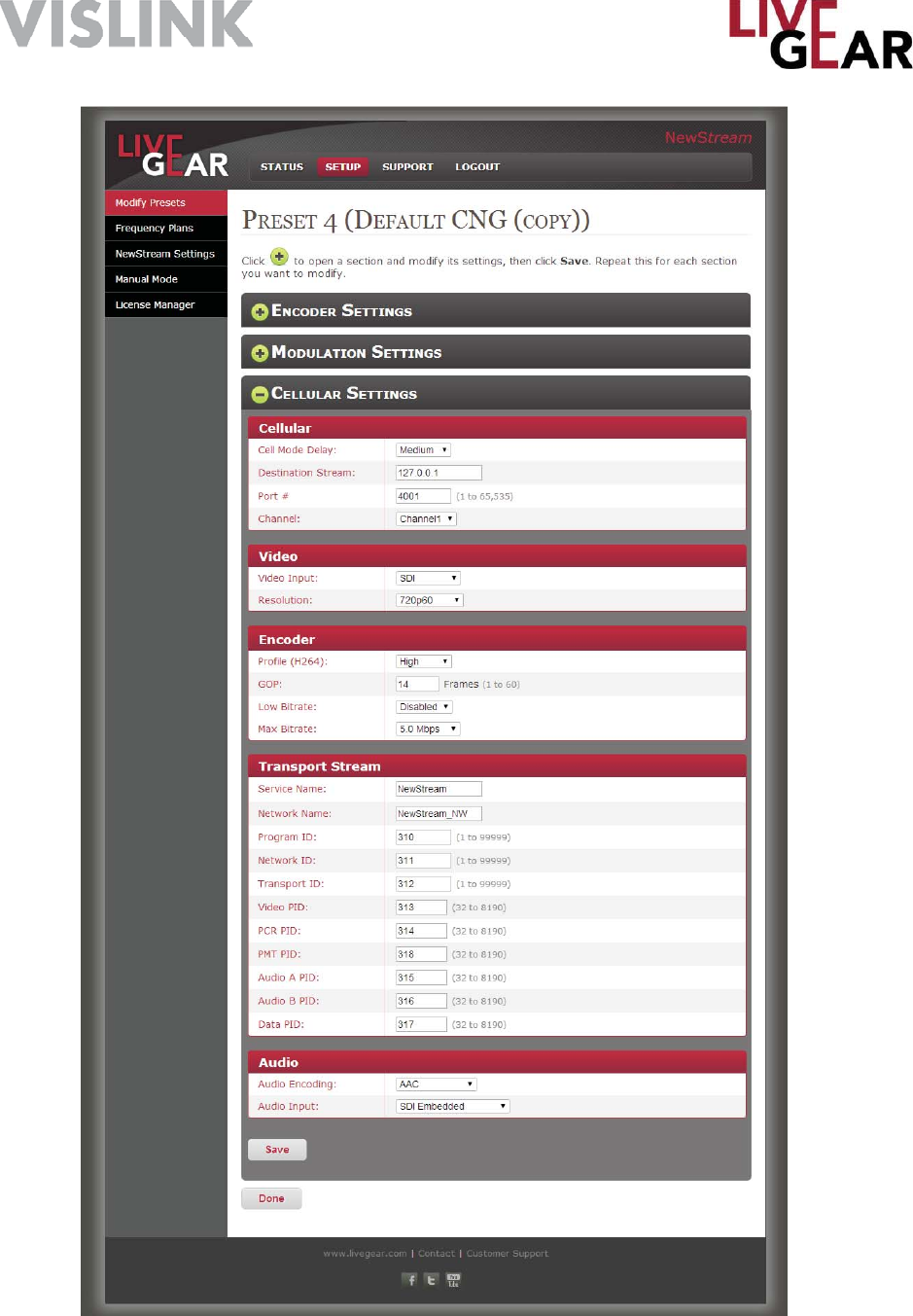
Page 82
NewStream User Guide and Technical Manual
Figure 37: Modify Presets Cellular Settings Page

Page 83
NewStream User Guide and Technical Manual
Modify Presets Cellular Settings [Continued]
Video
The video settings for the NewStream transmitter CNG presets include the following
parameters.
Video Input
The Video Input drop-down fi eld allows the selection of one of two options:
• SDI
• Composite
Resolution
The Video Input Resolution drop-down selection fi eld provides the following choices:
• 720p50
• 720p59.94
• 720p60
• 1080i50
• 1080i59.94
• 1080i60
• NTSC [National Television System Committee]
• PAL [Phase Alternating Line]
Encoder
Profi le [H.264]
The H.264 4:2:0 Profi le drop-down fi eld allows the selection of one of the following
options:
• Baseline
• Main
• High
GOP
In MPEG encoding, a Group of Pictures [GOP] specifi es the order in which intra-frames
are arranged. The GOP is a group of successive pictures within an MPEG-coded
fi lm and/or video stream. Each MPEG-coded fi lm and/or video stream consists of
successive groups of pictures. The valid range of successive groups of pictures is from
0 to 60. For “Intra Refresh,” enter 0 in this fi eld.
Low Bitrate
This fi eld applies Low Bitrate control.
• Enabled
• Disabled

Page 84
NewStream User Guide and Technical Manual
Modify Presets Cellular Settings [Continued]
Max Bitrate
This drop-down fi eld presents a range of:
• 256 kilobits per second [kbps]
• 500 kbps
• 768 kbps
• 1.0 Megabit per second [Mbps]
• 1.5 Mbps
• 2.0 Mbps
• 2.5 Mbps
• 3.0 Mbps
• 3.5 Mbps
• 4.0 Mbps
• 5.0 Mbps
• 6.0 Mbps
• 7.0 Mbps
• 8.0 Mbps
• 9.0 Mbps
• 10.0 Mbps
Transport Stream
The following entry fi elds are used by the system to differentiate NewStream Cellular
Transport Streams.
Service Name
This fi eld provides a means to differentiate the NewStream Transport Stream with a
unique Service Name.
Network Name
This fi eld provides a means to differentiate the NewStream Transport Stream with a
Network Name.
Program ID
This fi eld provides a means to differentiate the NewStream Transport Stream with a
Program Identifi cation [valid range: from 1 to 99999].
Network ID
This fi eld provides a means to differentiate the NewStream Transport Stream with a
unique Network Identifi cation [valid range: from 1 to 99999].
Transport ID
This fi eld provides a means to differentiate the NewStream Transport Stream with a
unique identifi cation [valid range: from 1 to 99999].
Video PID
This fi eld displays the Video Packet Identifi cation for the NewStream Transport Stream
[valid range: from 32 to 8190].

Page 85
NewStream User Guide and Technical Manual
Modify Presets Cellular Settings [Continued]
PCR PID
This fi eld displays the Program Clock Reference [PRC] Packet Identifi cation for the
NewStream Transport Stream [valid range: from 32 to 8190].
PMT PID
This fi eld displays the Program Map Table [PMT] Packet Identifi cation for the
NewStream Transport Stream [valid range: from 32 to 8190].
Audio A & B PID
This fi eld displays the Audio A and B Packet Identifi cation for the NewStream Transport
Stream [valid range: from 32 to 8190].
Data PID
This fi eld displays the Data Packet Identifi cation for the NewStream Transport Stream
[valid range: from 32 to 8190].
Audio
Audio Encoding
The Audio Input Encoding parameters that are displayed in this fi eld include:
• MPEG Layer II — MPEG Audio Layer II is a core audio algorithm.
• AAC — Advanced Audio Coding is the simplest and most widely used and
supported Audio Input Encoding.
• Off
Audio Input
This drop-down selection provides three options:
• Analog
• SDI Embedded — Serial digital interface [SDI] is a family of video interfaces that
have been standardized by SMPTE. For example, ITU-R BT.656 and SMPTE 259M
defi ne digital video interfaces used for broadcast-grade video. This mode embeds the
audio into the SDI stream.
• AES-EBU — The digital audio standard frequently called AES/EBU [aka AES3], is
used for carrying digital audio signals between various devices.
Apply
Click the Apply button to confi gure the cellular settings and submit preset changes to
the IDU.
Done
Click the Done button once you’ve fi nished viewing the settings in the Modify Presets
page. When you click Done nothing will be saved as you leave the page.
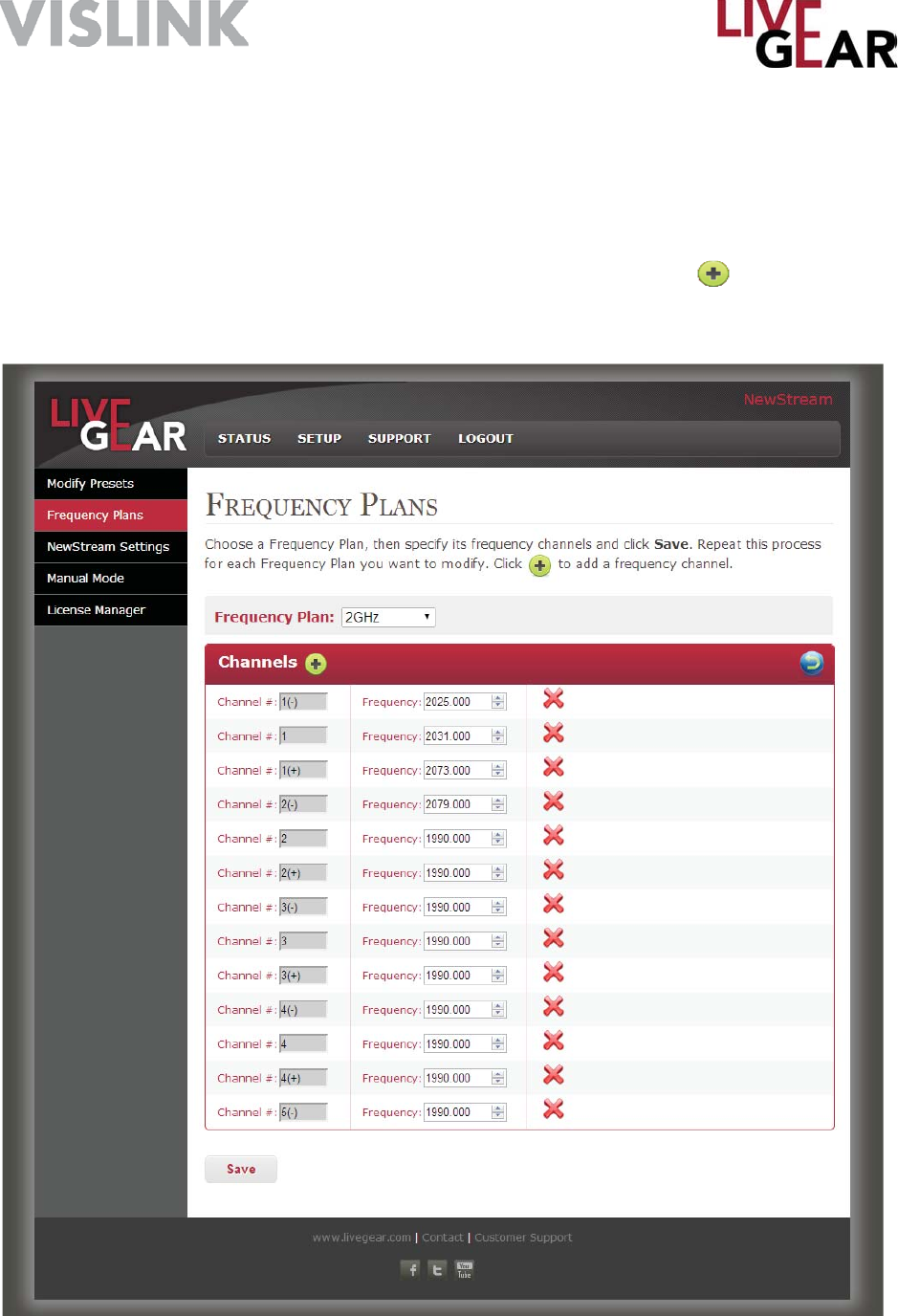
Page 86
NewStream User Guide and Technical Manual
Frequency Plans Page [CNG & ENG]
The Frequency Plans page provides a means to specify the Channels and Frequencies
for the ENG and CNG Frequency Bands used by the NewStream transmitter during
microwave and cellular transmission [see fi gure below].
Choose a Frequency Band, then specify its frequency channels and click Save. Repeat
this process for each Frequency Band that you want to modify. Click to add a
frequency channel.
Figure 38: NewStream Frequency Plans Web Page [ENG/CNG]

Page 87
NewStream User Guide and Technical Manual
NewStream has six separate frequency maps which are selected based on the state
of the radio and the type of ODU connected. There are six channel plan maps for ENG
and one additional one for Satellite. The Frequency Settings page allows the operator to
set or modify the list of channels for any frequency band.
The frequency map is partially determined by the type of the Outdoor Unit [ODU]
which is connected to the IDU. Each ODU supports different bands of operation. In the
Frequency setup, you are presented with drop-down menu that allows selection of any
of the frequency maps. You must select a specifi c frequency band to confi gure. By
default, the list is populated by the industry standard frequencies that broadcasters use
for these bands. You can change the channels to represent these settings anyway that
you wish. The same frequency can be applied to multiple channels if you so choose.
There is no cross-checking mechanism within NewStream’s software to ensure that
each frequency is unique.
You can also add additional channels to the frequency mapping if more channels are
needed. The maximum number of channels in a frequency mapping is 22 separate
channels, each with (-), ( ), and (+) values, so that a total of 66 separate channels in a
frequency mapping are allowed.
Once you are fi nished changing channels to a frequency map, you must next save the
group of frequency maps to a frequency plan that includes a user-assigned name by
clicking the Save button.
You can create a specifi c frequency plan for NewStream as part of the confi guration
cloning. For US-based systems, NewStream contains a frequency plan that
broadcasters typically do not revise.
Channels
Restore
Click to restore the current band’s channel plan to its original confi guration.
Channel Number [#]
The microwave and cellular Channel Number range varies for each frequency plan. To
add a channel, click the button.
Frequency Plan
NewStream ENG and CNG frequency ranges are:
• 2 GHz BAS [Ranges from 1990-2110 & 2450-2500 MHz]
• 2 GHz Upper [Ranges from 2200-2500 MHZ or 2300-2700 MHz]
• 4 GHz [Ranges from 4400 MHz to 5000 MHz]
• 7 GHz [Ranges from 6425-6525 & 6875-7125 MHz]
• 7 GHz Upper [Ranges from 6900 MHz to 7500 MHz]
• 13 GHz [Ranges from 12700 MHz to 13250 MHz]
• Satellite
Delete a Channel
Use the button to delete a channel and confi rm your choice.

Page 88
NewStream User Guide and Technical Manual
Confi guration Cloning
Saving Presets
The website provides a separate tab that allows you to save to a fi le either
• Saved Preset List and information from the radio
o Maintains order of presets saved on IDU
o Maintains preset names
o Maintains preset type and all variables inside the preset
• Entire Frequency plan saved onto the radio, including:
o 2GHz Plan
o 4GHz Plan
o 7GHz Plan
o 13 GHz Plan
o Satellite [L-Band] Plan
You are allowed to name either of these fi les.
Loading
The website provides a place that allows you to load a fi le to restore either
• Saved Preset List
Frequency Plans Page [SNG]
The Frequency Plans page also provides a means to specify the Channels and
Frequencies for the SNG Frequency Bands used by the NewStream transmitter during
satellite transmission [refer to Figure 39].
Choose a Frequency Plan, using the drop-down menu and specify its frequency, its
channel and whether or not your block up-converter will be used in transmission, then
click Save. Repeat this process for each Frequency Band that you want to modify. Click
to add a frequency channel.
Frequency Plan
This fi eld displays the name of the frequency range at which NewStream is calibrated
for SNG mode. This fi eld can be selected in the Frequency Plans page as shown
in Figure 38. To confi gure frequencies for satellite transmission you must select the
Satellite [L-Band] option that prompts the display of the Web page shown in Figure 39.
As described previously, the values include:
• 2 GHz
• 2 GHz Upper
• 4 GHz
• 7 GHz
• 7 GHz Upper
• 13 GHz
• Satellite
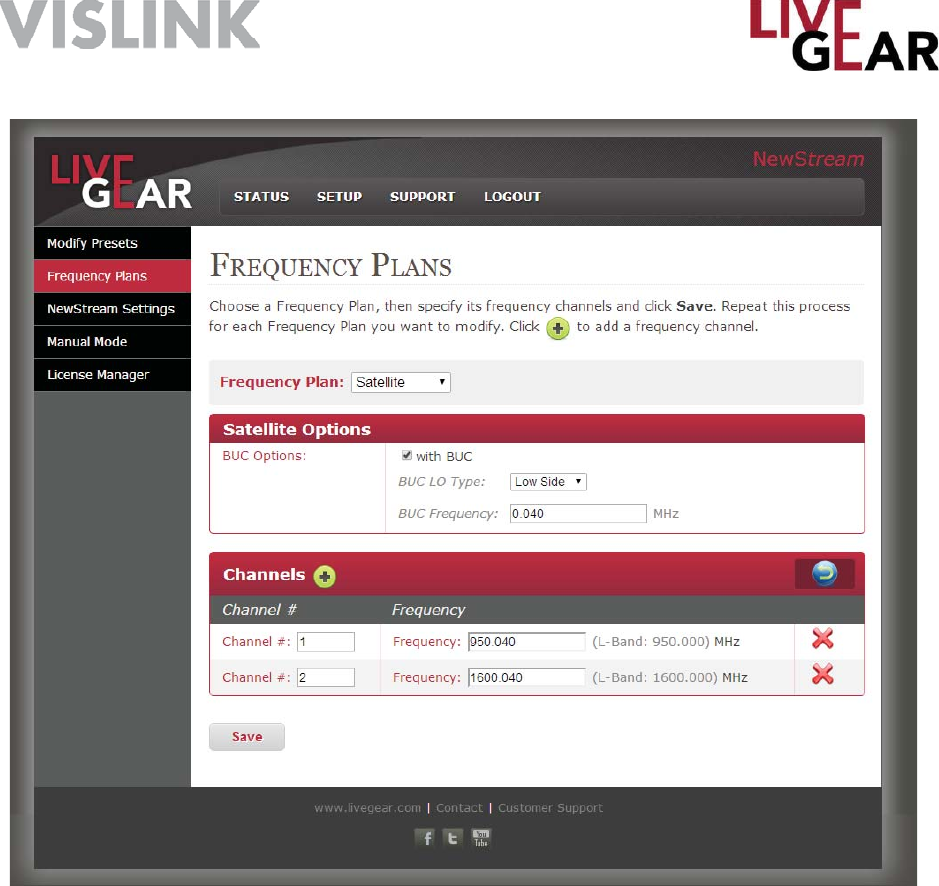
Page 89
NewStream User Guide and Technical Manual
Figure 39: NewStream Frequency Plans Web Page [SNG]
Satellite Options
With BUC [Block Up-converter Enabling]
The Block Up-converter [BUC] is used in the transmission [uplink] of satellite signals. It
converts a band of frequencies from a lower frequency to a higher frequency. Modern
Block Up-converters convert from the L band to Ku band, C band and Ka band. Click
the check box to enable this feature.
BUC LO Type
The BUC [Block Up-Converter Enabling] LO [Local Oscillator] Type drop-down provides
a means of selecting between low side and high side, where low is the standard and
default setting.
BUC Frequency
This fi eld displays the BUC Frequency for which your up-converter will communicate
with the NewStream system. This frequency starts at 0 and can be raised in 1 kHz
increments using the entry fi eld.
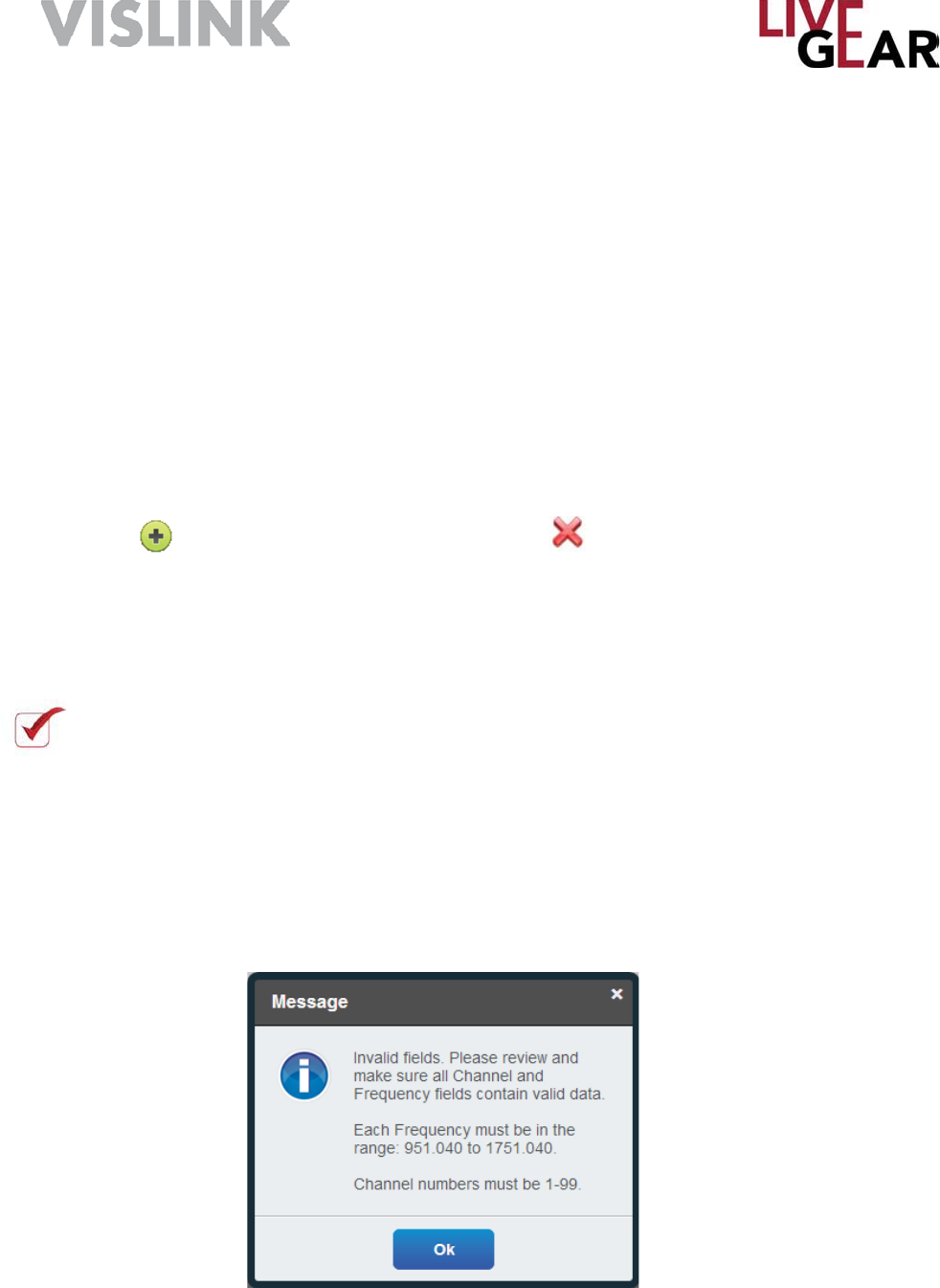
Page 90
NewStream User Guide and Technical Manual
When you choose the Block Up-converter option and press Save, you may encounter
the Invalid Fields Message [see the example below in Figure 40]:
Invalid fi elds. Please review and make sure all Channel and Frequency fi elds contain
valid data. Each Frequency must be in the range: 950.000 to 1750.000.
Channel numbers must range from 1-99.
Once you have selected the proper ranges, a dialog box appears asking you to confi rm
your entries:
Are you sure you want to save this channel plan and overwrite the existing one?
Click Yes to continue and to save the updated or new Satellite Channel Plan.
Channel Number [#]
Channel Number [#]
The satellite Channel Number range varies for each frequency plan. To add a channel,
click the button. To delete a channel, click the button and confi rm your action.
Each channel displays the frequency range as shown in the example.
Frequency
The frequency is displayed for the channel and can be modifi ed using your keypad. The
frequency that you type must conform to the valid range and will not be accepted if it
does not [see Figure 40].
NOTE: You must create a Channel via this Web page, in Remote control, to access
the channel plan setting under Local control using the IDU touchscreen. Refer to the
Channel Plan example in the Satellite [SNG] Operation touchscreen section for an
example of this selection process.
Save
Click the Save button to retain your new Channel Plans.
Figure 40: NewStream Invalid Fields Message
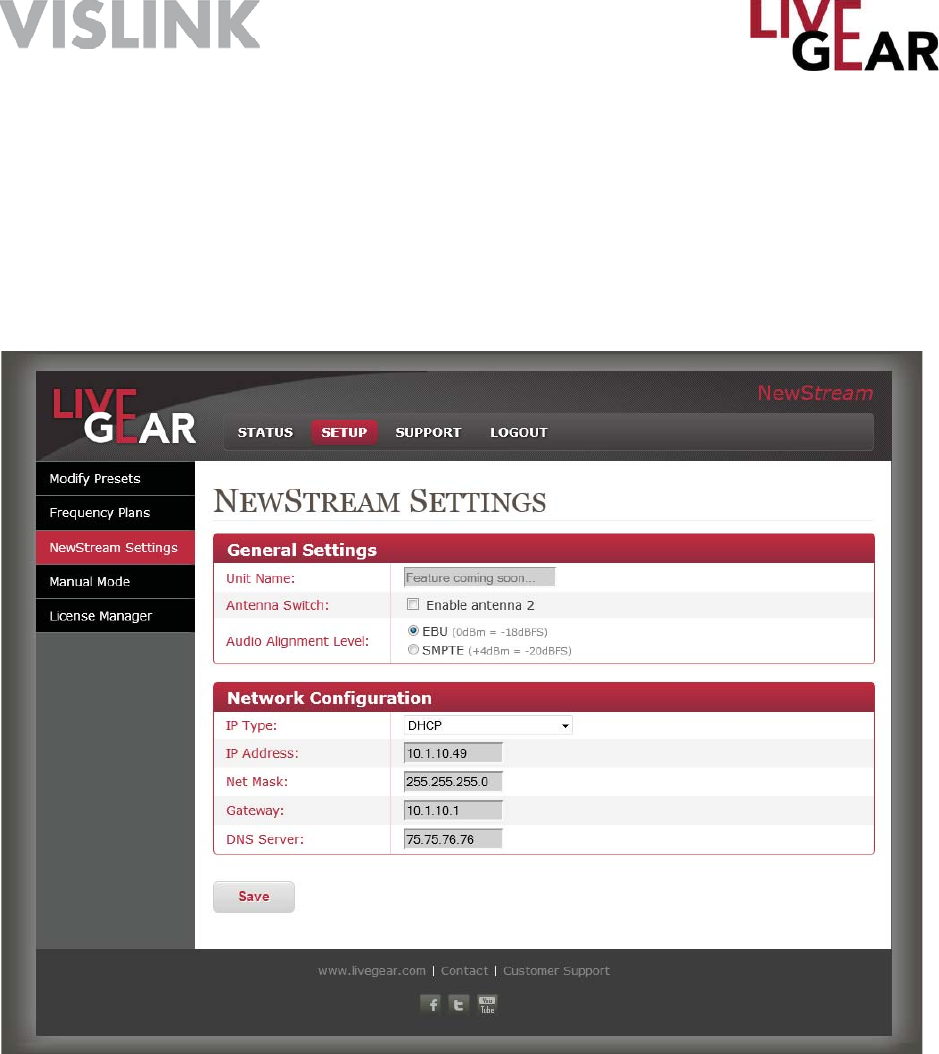
Page 91
NewStream User Guide and Technical Manual
NewStream Settings Page
When the NewStream Settings button is selected on the NewStream transmitter Web
page, the following Wide Area Network [WAN] Confi guration entry fi elds are displayed,
defi ning the NewStream transmitter’s IP Network [see below].
Figure 41: NewStream Network Settings Page
General Settings
Unit Name
This fi eld indicates the NewStream unit name [future option]
Antenna Switch
The Antenna Switch check box allows you to select Antenna 2 for the microwave [ENG]
operational antenna. When this check box is not selected, Antenna 1 is the default
ODU.

Page 92
NewStream User Guide and Technical Manual
Audio Alignment Level
The Audio Alignment radio buttons provide a means to select from EBU for standard
European transmissions or SMPTE, the standard for North American transmissions.
The ranges in dBm are shown below:
• EBU [0dBm = -18dBFS]
• SMPTE [+4dBm = -20dBFS]
Network Confi guration
IP Type
The Internet Protocol Type drop-down entry fi eld provides the choice of either Static or
DHCP [Dynamic Host Confi guration Protocol] to confi gure the NewStream transmitter.
Internet Protocol addresses are assigned to a host either at the time of booting, or
permanently, by fi xed confi guration of its hardware or software. Fixed, or persistent
confi guration uses a Static IP address.
DHCP is a network protocol used to confi gure network devices to communicate on an
IP network. A DHCP client uses DHCP protocol to acquire confi guration information,
such as an IP address, a default router and one or more DNS server addresses from
a DHCP server. The DHCP client then uses this information to confi gure its host. Once
the confi guration process is complete, the host is able to communicate on the Internet.
IP Address
The Internet Protocol Address that is displayed for the NewStream transmitter can
be modifi ed. Click within the fi eld and type the value of the address that you want to
modify. Click Save Changes to retain the IP Address. When NewStream uses the
DHCP type, this fi eld displays the IP address received by the DHCP server.
Net Mask
A sub-network, or subnet, is a logical subdivision of an IP Network. All computers that
belong to a subnet are addressed with a common, identical, most-signifi cant bit-group
in their IP address. This results in the logical division of an IP address into two fi elds: a
network or routing prefi x and the rest fi eld or host identifi er. The rest fi eld is an identifi er
for a specifi c host or network interface. Special gateways called routers exchange
traffi c between sub-networks. Such routers constitute the logical or physical boundaries
between the subnets.
To change the Net Mask address, type the new value and click Save to retain the
Subnet Mask. When NewStream uses the DHCP type, this fi eld displays the Subnet
Mask received by the DHCP server.

Page 93
NewStream User Guide and Technical Manual
Gateway
The Gateway address, or Default Gateway, is a router interface connected to the
Local Area Network [LAN] used to send packets from the LAN. Click within the fi eld
and type the value of the Gateway address that you want to use. Click Save to retain
the Gateway address. When NewStream uses the DHCP type, this fi eld displays the
Gateway received by the DHCP server.
DNS Server
Domain Name System [DNS] Server hosts a network service for providing responses
to queries against a directory service. It maps a human-recognizable identifi er to
a system-internal, numeric, identifi cation or addressing component. This service is
performed by the server according to a network service protocol. The most important
function of the DNS Server is the translation or resolution of human-memorable domain
names and hostnames into the corresponding numeric Internet Protocol Addresses.
Click within the fi eld and type the value of the DNS address that you want to use. Click
Save to retain the DNS Server address. When NewStream uses the DHCP type, this
fi eld displays the DNS Server address received by the DHCP server.
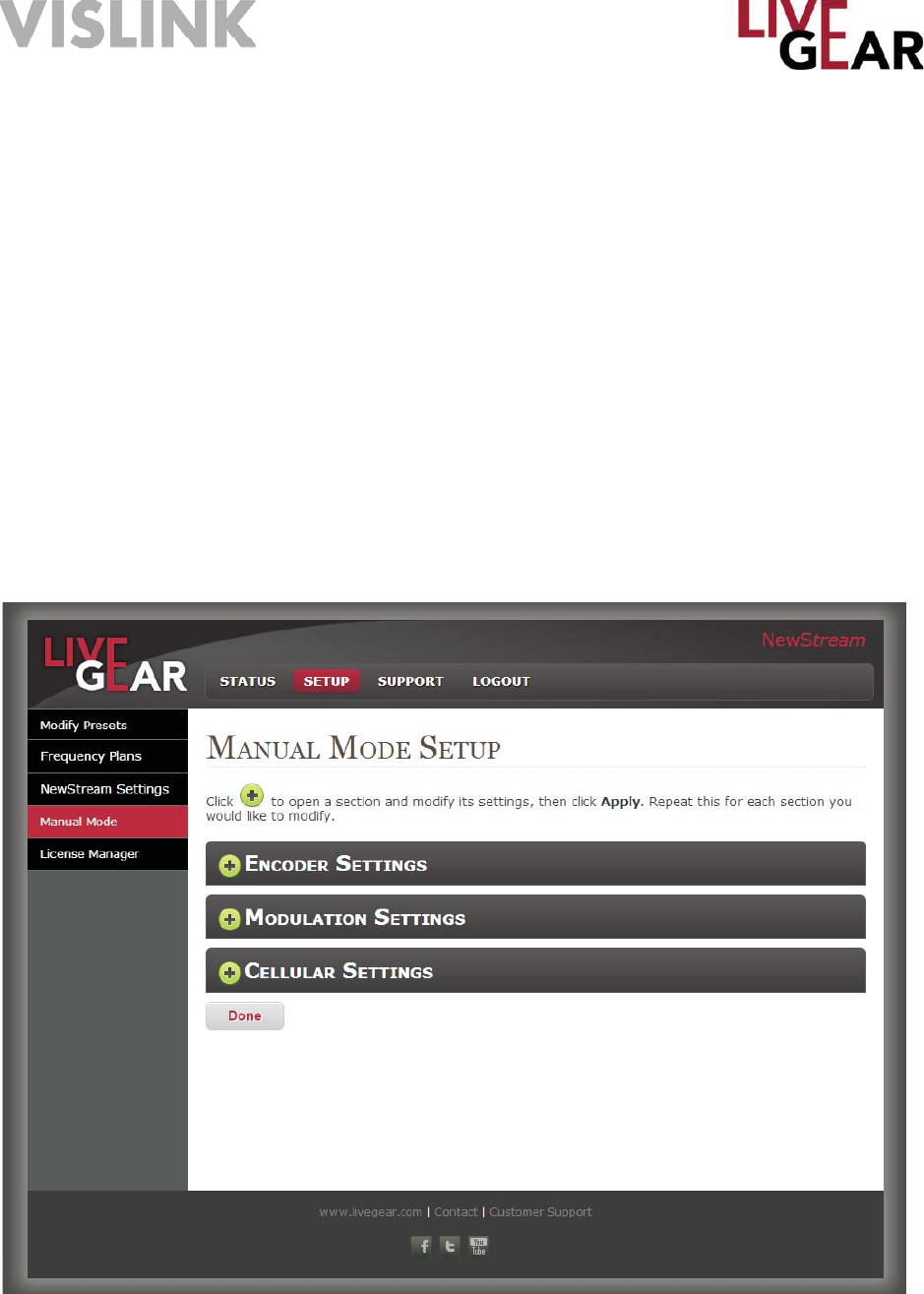
Page 94
NewStream User Guide and Technical Manual
Manual Mode Pages
When you are operating NewStream and you want the option of manual control, you
must begin with the type of preset that you want to regulate. For instance, to manually
control CNG mode, you must begin operations using a CNG preset. Setting Cell Mode
Delay in Manual Mode is exclusive to setting the device into CNG operation; thus
Manual Mode Modulation settings would not be applicable. Manual Mode could be
used to temporarily change parameters and have the changes applied immediately,
automatically placing NewStream into Manual Mode which is designed to be used to
change preset confi gurations without modifying a saved preset. Manual Mode can be
used to test transmission options.
Generally, use of Manual Mode is intended for technician troubleshooting and setup
and not for use in fi eld operations. For more information concerning the entry fi elds
available, refer to the Modify Presets section. The collapsed Manual Mode Setup page
is shown in the fi gure below.
Figure 42: Manual Mode Settup Page

Page 95
NewStream User Guide and Technical Manual
License Manager Page
When the License Manager button is selected on the NewStream Web interface, the
following licensing details are displayed, as shown in the example Figure 43. To enable
newly licensed features, enter the License Key and click the Set Key button. Use the
button to refresh the Features lists. The License column displays whether the
features are available or not .
Licensed Features
ENG Modulation Features
• DVB-T
• LMS-T - 10 MHz
• LMS-T - 20 MHz
SNG Modulation Features [Upgrade Option]
• DVB-S QPSK
• DVB-S 8PSK/16QAM
• DVB-S2 QPSK/8PSK
• DVB-S2 16/32 APSK
MPEG-2 Encoder Features
• MPEG-2 SD - 4:2:0
• MPEG-2 SD - 4:2:2
• MPEG-2 HD - 4:2:0
• MPEG-2 HD - 4:2:2
Encryption Features
• BISS-1/E
Input Features
• ASI Remux
H.264 Encoder Features
• H.264 SD - 4:2:0 [ENG/SNG/CNG]
• H.264 SD - 4:2:2 [ENG/SNG]
• H.264 HD - 4:2:0 [ENG/SNG/CNG]
• H.264 HD - 4:2:2 [ENG/SNG]
If NewStream does not have a license for a particular function, the Web interface
displays those particular options as not available. If an attempt is made to load a
preset that contains the use of a license key which is not enabled, then the NewStream
system displays a warning on the LCD. Similarly, if an attempt is made to load a preset
that contains use of a license key that is not enabled on the system, within the Web
interface, a pop-up displays support information that enables you to call for licensing
support. To learn more about feature upgrades please contact LiveGear Support.
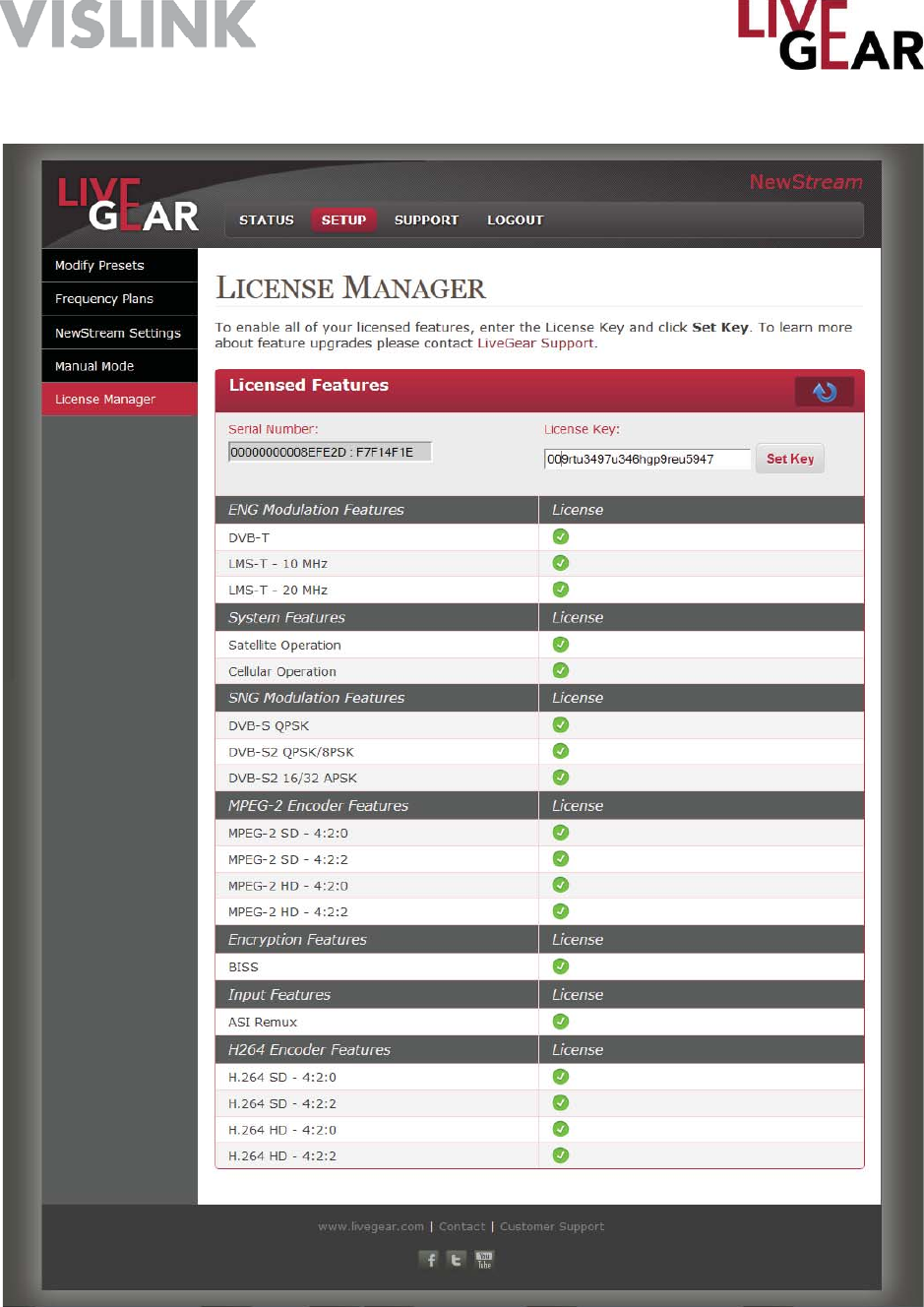
Page 96
NewStream User Guide and Technical Manual
Figure 43: NewStream License Manager Web Page
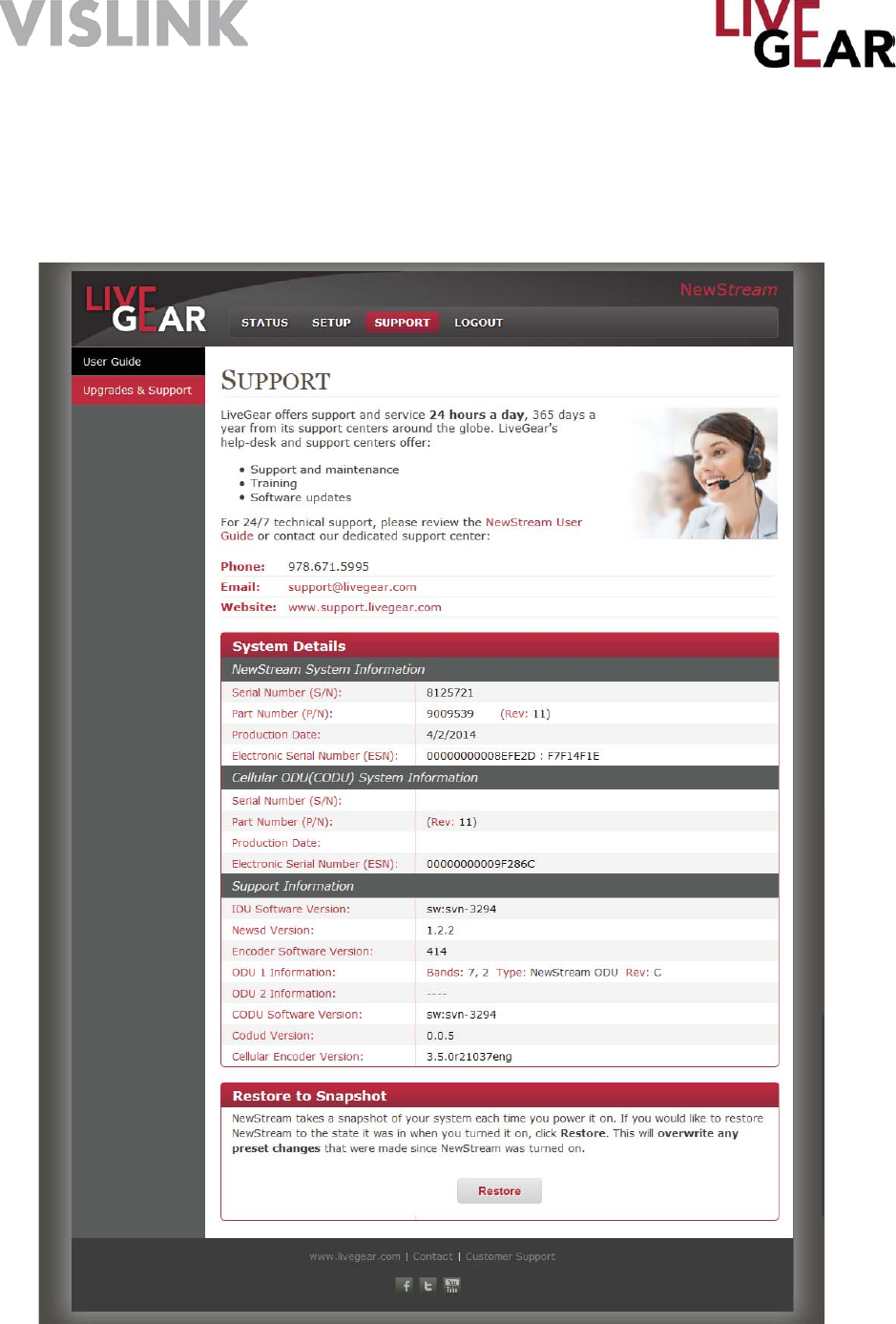
Page 97
NewStream User Guide and Technical Manual
Support Page
When the Support button is selected on the NewStream transmitter Web interface,
select the Upgrades & Support button to display the Support Web page that lists the
System Details and Support Information, as shown in the example below. You may also
select the User Guide button to retrieve this manual.
Figure 44: NewStream Support Web Page

Page 98
NewStream User Guide and Technical Manual
System Details
NewStream System Information
• Serial Number [S/N] – displays the serial number that identifi es your
NewStream transmitter.
• Part Number [P/N] – displays the part number that identifi es your NewStream
transmitter.
• Production Date – displays the date on which your NewStream was created.
• Electronic Serial Number [ESN] – displays the serial number that identifi es your
NewStream transmitter.
Cellular ODU [CODU] System Information
• Serial Number [S/N] – displays the cellular ODU serial number that identifi es your
NewStream transmitter.
• Part Number [P/N] – displays the cellular ODU part number that identifi es your
NewStream transmitter.
• Production Date – displays the date on which your NewStream cellular ODU was
created.
• Electronic Serial Number [ESN] – displays the cellular ODU serial number that
identifi es your NewStream transmitter.
Support Information
• IDU Software Version – displays the software version for your NewStream IDU.
• Newsd Version – displays the software version for your NewStream Newsd
system.
• Encoder Software Version – displays the software version for your NewStream’s
encoder.
• ODU 1 Information – displays the frequency bands, ODU type and revision for
equipment installed on the ODU 1 ports.
• ODU 2 Information – displays the frequency bands, ODU type and revision for
equipment installed on the ODU 2 ports
• Codud Version – displays the software version for your NewStream’s Codud
encoder.
• Cellular Encoder Version – displays the software version for your NewStream’s
cellular encoder.
Restore to Snapshot
NewStream takes a snapshot of your system each time you apply power to the IDU. If
you would like to restore NewStream to the state it was in when you last applied power,
click Restore. This will overwrite any preset changes that were made since NewStream
was last powered on.
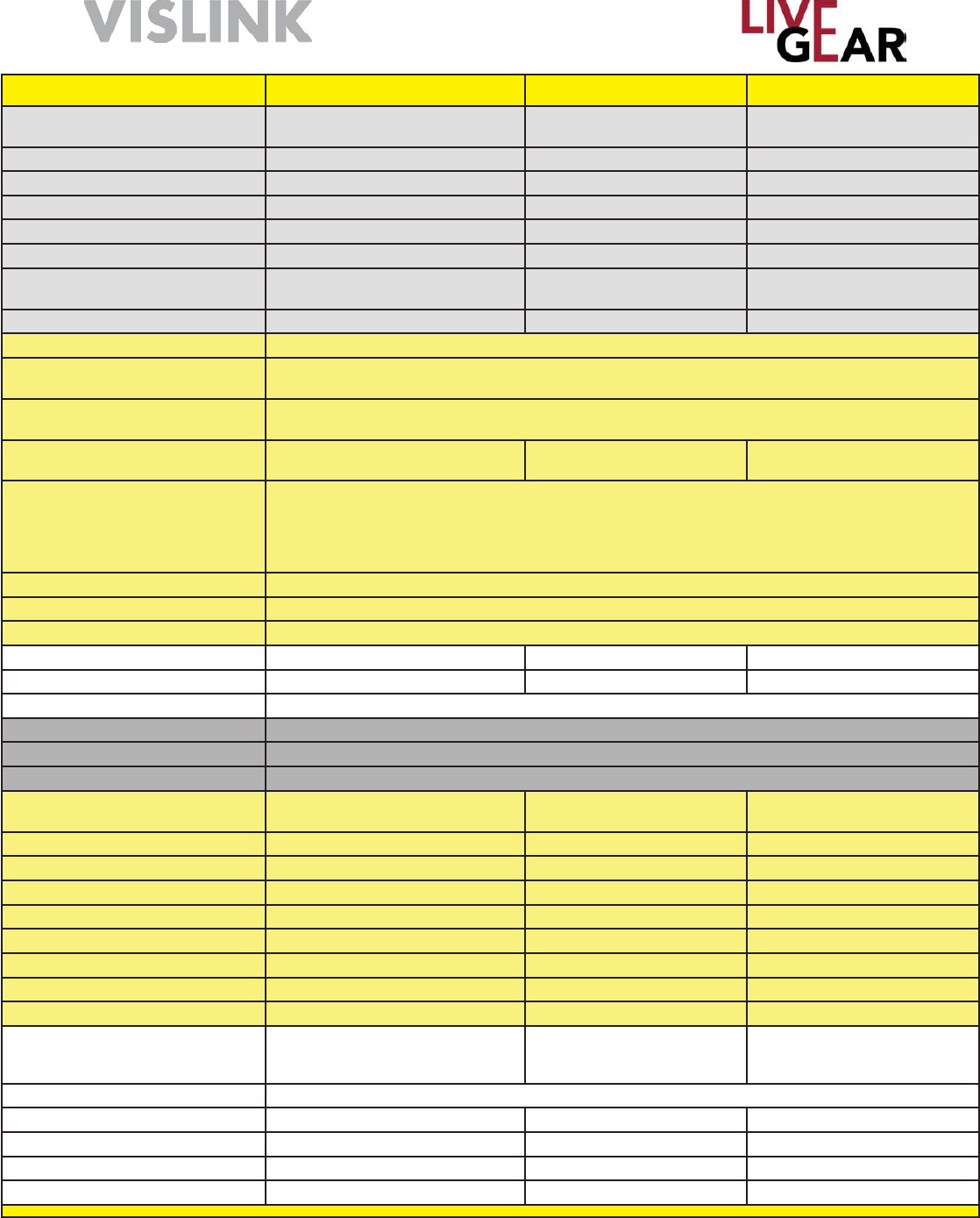
Page 99
NewStream User Guide and Technical Manual
Specifi cations
NewStream ENG CNG SNG
Outdoor Unit [ODU]-RF Mast-mounted
[single enclosure]
Mast-mounted
[single enclosure]
Optional - Roof-mounted
NewSwift, Mantis
2-2.5 GHz 8 Watts @ QPSK, 16 QAM N/A N/A
4.5-5.0, 6.4-7.1, 6.9-7.5 GHz 5 Watts @ QPSK, 16 QAM N/A N/A
12.7-13.25 GHz 1.5 Watts @ QPSK N/A N/A
CDMA, UMTS, HSPA+, LTE N/A 6-modems, Bonded N/A
IDU to ODU interconnection RG-6/U minimum or better RG-58/U or RG-59/U LMR - 400 or equivalent
Size and Weight, ODU 7” W x 10” L x 6” H, 16 lbs. [max. @
2/7 GHz] 10” W x 14” L x 5” H, 10 lbs. 10” W x 14” L x 5” H, 10 lbs
Temperature -20º to +50ºC -20º to +50ºC -20º to +50ºC
Indoor Unit [IDU] Rack-mount chassis, single
Operator Controls [5] Programmable OLED [organic light-emitting diode] push-button switches, [2] rocker-style switches, [3] LED
push-button switches, [1] On/Off push-button switch
Displays [1] Capacitive color touch TFT 5.0” diagonal 800 x 480 white LED back light display, [2] 16 x 2 segment
monochromatic blue OLEDs
Presets Up to 99 User-confi gurable 3 Operating Modes-Interview,
Standard, Mobility Up to 99 User-confi gurable
Rear panel I/O
BNC- [ASI In, ASI Out, SDI In, CV in, 75 Ω audio, spare]
Weidmuller - [analog audio 1L/1R, 2L/2R, digital audio D1, D2, MW ODU power, Ant.]
Type N or Triax [ODU 2/7 GHz or 2 GHz and 7 GHz legacy MTX ODUs]
Type N- [L-Band Mod. & L-Band Mon.], TNC- [to cellular ODU]
Miscellaneous- [1] SMA Wi-Fi, [3] RJ045 Ethernet, [1] 115 VAC IEC C14, [1] DB-9 data, [1] USB
Size and Weight, IDU 17.0” W x 16.2” L x 3.5” H [2RUx 19” EIA standard rack-mount], 16 lbs./7.26 kg
Prime operating power 115/230 VAC, 2.0 A [typ.]
Temperature -10º to +40º C
Modulation COFDM [DVB-T] OFDMA, CDMA DVB-S QPSK, DVB-S2 QPSK
Optional Modulations LMS-T 10/20 N/A DVB-S2 8PSK, 16/32 APSK
Video Input Formats HD/SD-SDI
Video Resolutions HD & SD
High Defi nition 1080i, 1080p, 720p
Standard Defi nition 720 x 480i [NTSC], 720 x 576i [PAL]
Video Encoding Profi le MPEG-2, H.264 HD/SD, 4:2:2/4:2:0 H.264 AVC HD/SD 4:2:0 High
Profi le @ Level 4.1
MPEG-2, H.264 HD/SD,
4:2:2/4:2:0
HD Encoding Rate@4:2:2 [MPEG-2] 8.0 to 30 Mbps N/A 8.0 to 80 Mbps
HD Encoding Rate@4:2:0 [MPEG-2] 8.0 to 30 Mbps N/A 8.0 to 380 Mbps
SD Encoding Rate@4:2:2 [MPEG-2] 2.0 to 50 Mbps N/A 2.0 to 50 Mbps
SD Encoding Rate@4:2:0 [MPEG-2] 1.5 to 15 Mbps N/A 1.5 to 15 Mbps
HD Encoding Rate@4:2:2 [H.264] 1.5 to 20 Mbps 750 kbps to 10 Mbps 1.5 to 20 Mbps
HD Encoding Rate@4:2:0 [H.264] 1.5 to 20 Mbps 128 kbps to 10 Mbps 1.5 to 20 Mbps
SD Encoding Rate@4:2:2 [H.264] 1.5 to 15 Mbps 750 kbps to 10 Mbps 1.5 to 20 Mbps
SD Encoding Rate@4:2:0 [H.264] 1.5 to 15 Mbps 128 kbps to 10 Mbps 1.5 to 15 Mbps
Audio Encoding 2- analog stereo/4-mono, AES/EBU -
up to 4 pairs embedded in SDI
1-analog stereo/2-mono, AES/
EBU [AAC] - up to 2 pairs
embedded in SDI
2- analog stereo/4-mono, AES/
EBU - up to 4 pairs embedded
in SDI
Audio Input [Analog] +8 dBm [avg.] @ 600 Ω bal.
THD @ 1 kHz TT <0.1% to +18 dBm max. 0.3% to +18 dBm max. <0.1% to +18 dBm max.
S/N [Signal to Noise] >66 db RMS >65 db RMS >66 db RMS
Frequency Response 0.03-18 KHz ± 1.0 dB 0.03-12 KHz ± 1.0 dB 0.03-18 KHz ± 1.0 dB
AES Input [digital] 1.0 V P/P @ 75 Ω unbalanced N/A 1.0 V P/P @ 75 Ω unbalanced

Page 100
NewStream User Guide and Technical Manual
Appendix A: Microwave and Cellular ODU Confi gurations
Microwave ODU Wiring Harness
The minimum recommended AWG cables are 4-conductor 20 AWG or 2-conductor
16 AWG for new installations, although additional customer-specifi c cables may be
required for applications such as mast-lighting, off-air antennas, mast-cams, etc. In
addition, NewStream is backwards compatible with legacy CodeRunner CR2 and
MTX5000 van transmit Nycoil installations.
Selecting Function Cables
To select the cables for your wiring harness, select the functions that you require and
match the individual cables that are applicable to the particular requirements. These
cables should be included in the harness.
NewStream provides antenna polarity controls and serial control over the IF
interconnect cable plus feed power and polarity for the antenna connection to the ODU
or the IDU. For a new installation, the 8 pin connection on the ODU will be used. A
short jumper cable can be used for the antenna connection, therefore no cables need
to be specifi ed inside the Nycoil conduit for the antenna.
NewStream simplifi es the ODU cabling due to the higher voltage [48V] used to power
the ODU. The minimum recommended cables are:
• 4 conductor 20AWG Type N
• 2 conductor 16AWG Type N or
• Belden 8232 Triax cable
Cellular ODU Wiring Harness
The Cellular ODU uses a single coax type cable - RG59 or RG6 with TNC connectors.
Note that both 48 V DC power and data are passed over this coax cable.
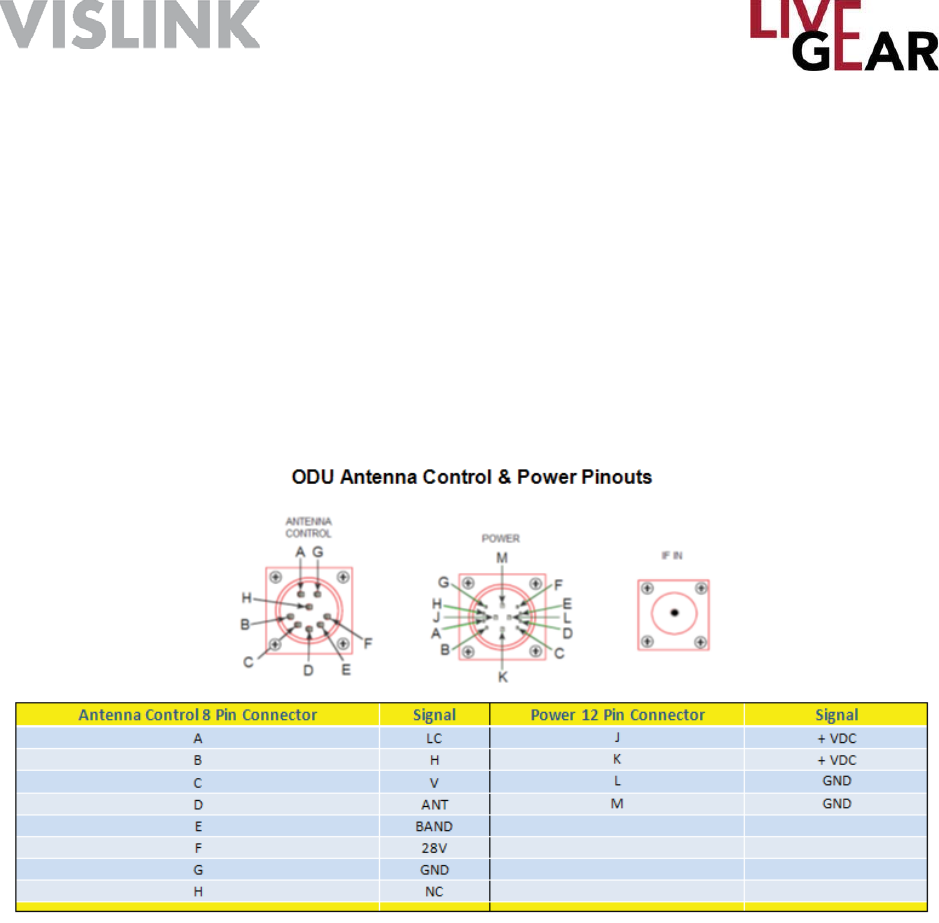
Page 101
NewStream User Guide and Technical Manual
Table A-1: ODU Power and Antenna Control Pinouts
Microwave ODU Connection Pinouts
The NewStream ODU power and antenna control pinouts for the Type “N” connector
are shown below in Table A-1. The IDU and ODU can be connected using an existing
wiring harness after inspection.
The existing, standard ODU connectors at the ODU end of the wiring harness will
connect directly to your NewStream ODU. Verify that all connections have been
completed and verify the connections at the IDU end of the wiring harness are
completed.
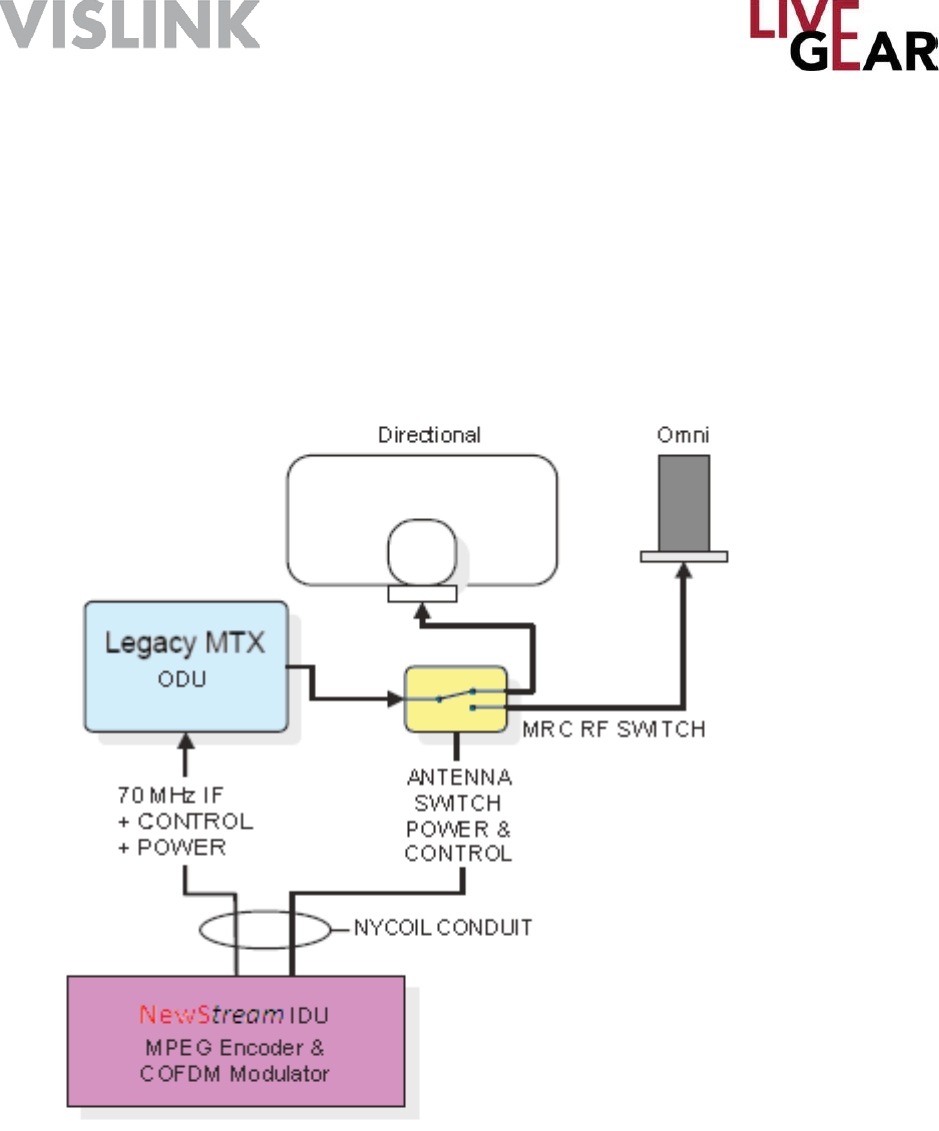
Page 102
NewStream User Guide and Technical Manual
Figure A-1: Legacy Single Band Transmission with 2 Antennas
Legacy Microwave ODU Antenna Confi gurations
Legacy Single-Band/Dual Antenna Transmission
The legacy NewStream transmitter antenna confi guration for single-band transmission
using either an omni antenna or a directional antenna with one IDU and one ODU is
shown in the fi gure below. The RF switch allows switching between the two types of
antennas.
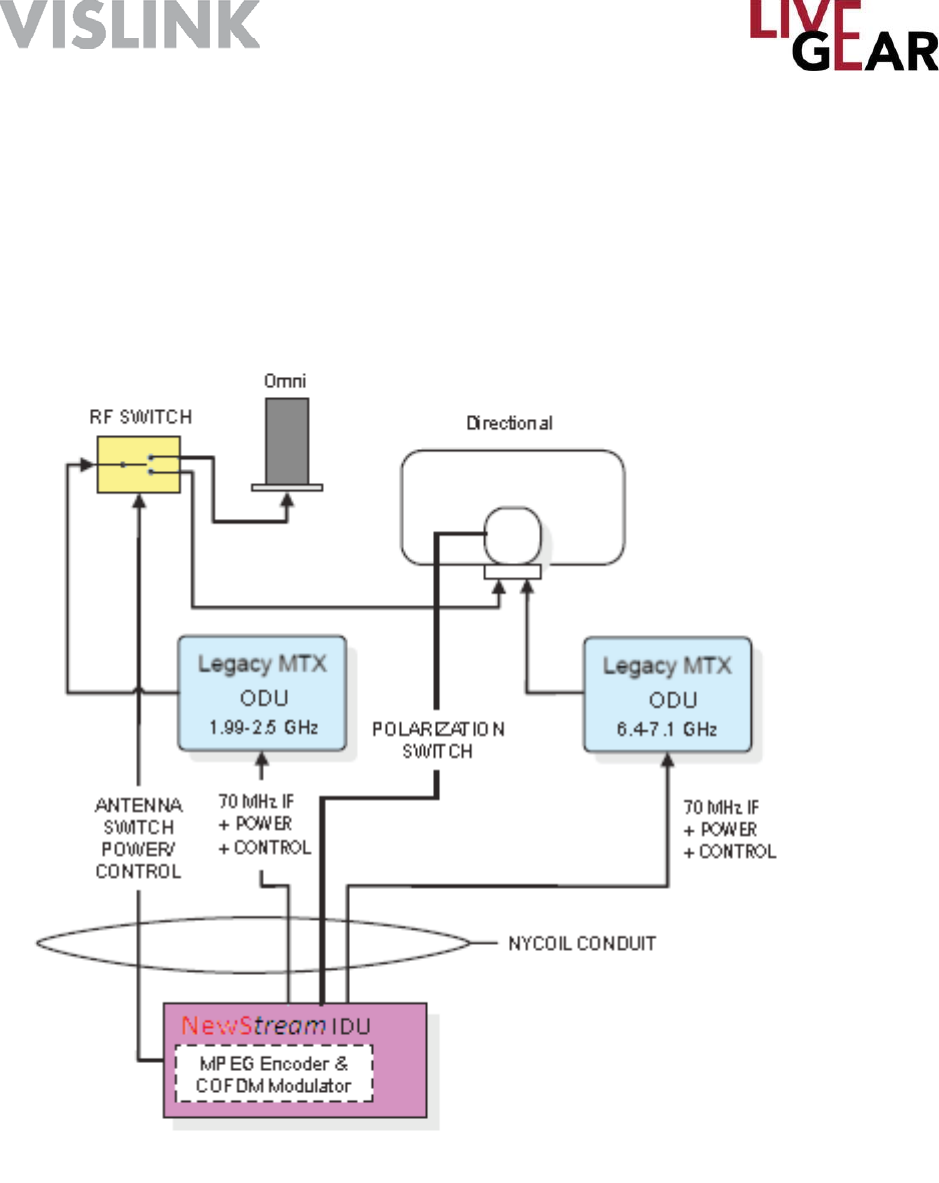
Page 103
NewStream User Guide and Technical Manual
Figure A-2: Legacy Dual Band Non-Simultaneous Transmission
Legacy DuaL-Band Non-Simultaneous Transmission
The fi gure below illustrates the legacy antenna confi guration for non-simultaneous
transmission using one IDU and two ODUs. In this example, the ODUs are operating on
2 GHz and 7 GHz bands. In addition, an RF switch allows switching between an omni
and a directional antenna.

Page 104
NewStream User Guide and Technical Manual
NewStream Microwave ODU Antenna Confi gurations
NewStream Single-Band/Dual Antenna Transmission
The NewStream transmitter antenna confi guration for single-band transmission using
either an omni antenna or a directional antenna with one IDU and one ODU is shown in
the fi gure below. The NewStream transmitter provides a control to switch between an
omni and a directional antenna.
Figure A-3: Single Band Transmission with 2 Antennas
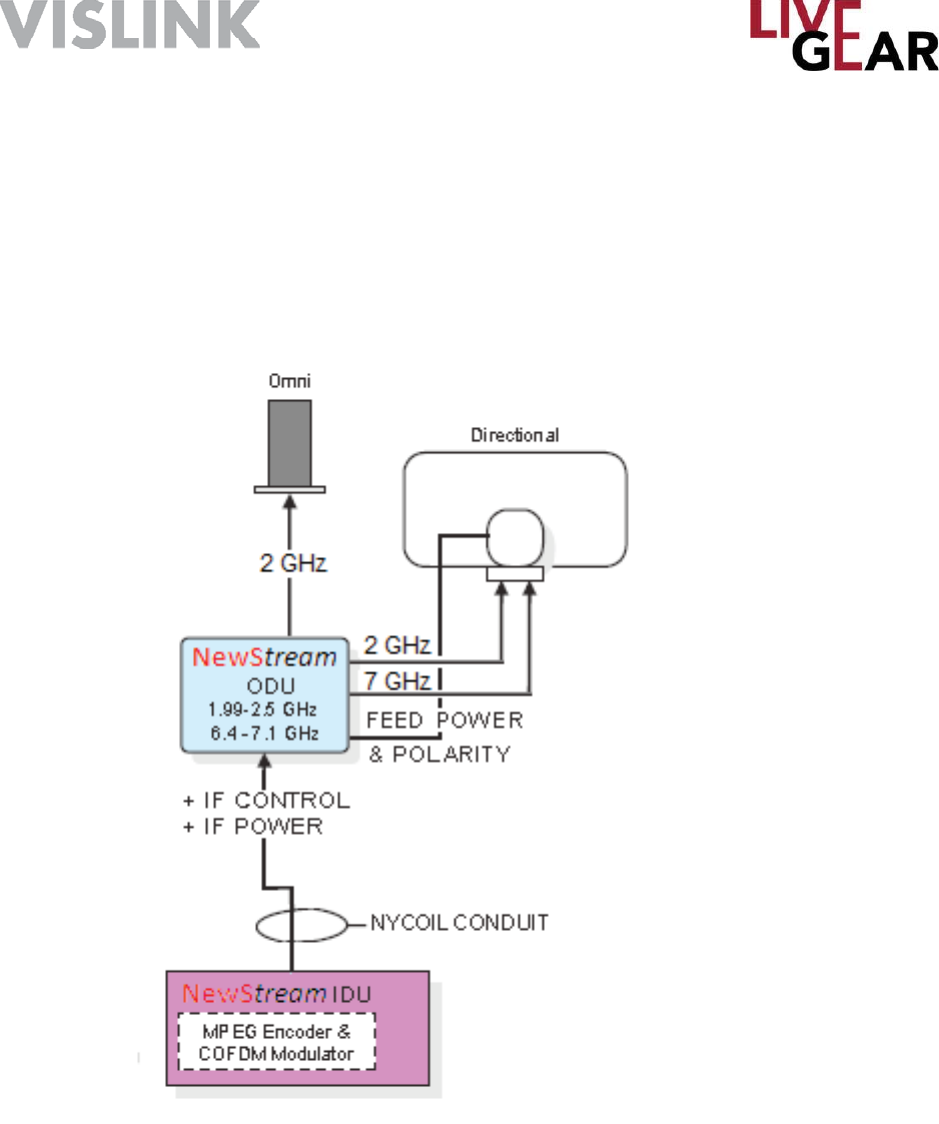
Page 105
NewStream User Guide and Technical Manual
Figure A-4: Dual Band Non-Simultaneous Transmission
NewStream DuaL-Band Non-Simultaneous Transmission
The fi gure below illustrates the antenna confi guration for non-simultaneous
transmission using one IDU and one dual band ODU. In this example, the ODUs are
operating on 2 GHz and 7 GHz bands. The internal antenna switches the 2GHz RF
power to either antenna 1 or antenna 2, the 7GHz does not have an antenna switch.
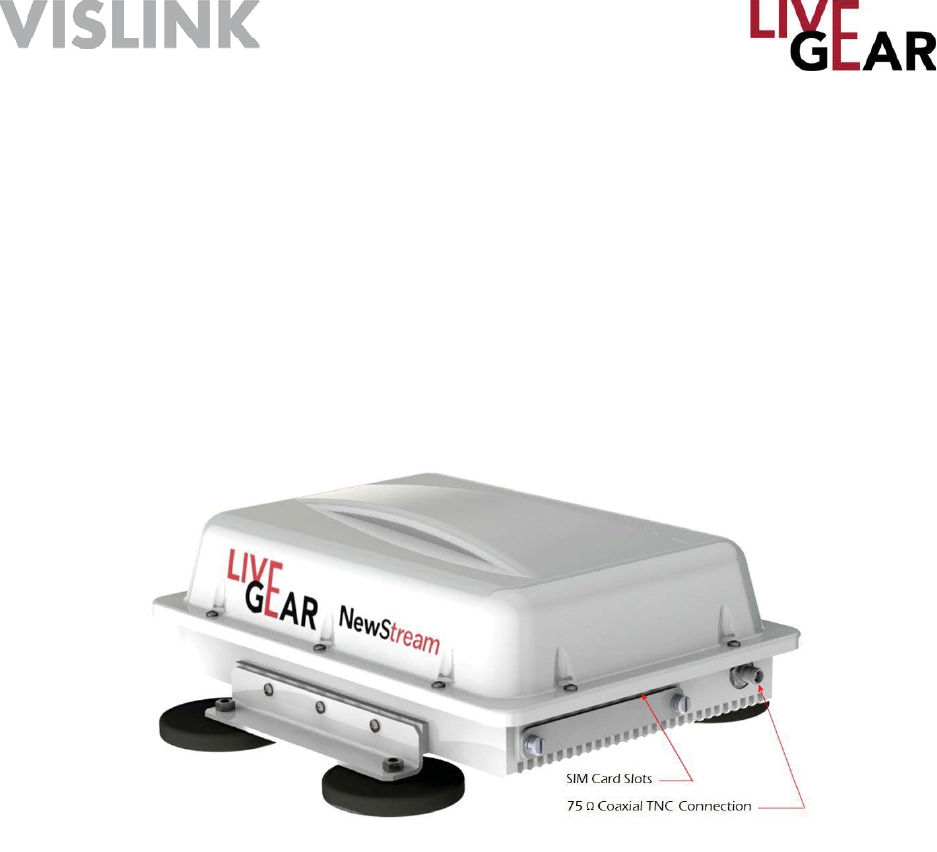
Page 106
NewStream User Guide and Technical Manual
Cellular ODU Connections
The NewStream cellular antenna system includes a TNC 75 Ω coaxial connection
to the ODU 1 output found on the NewStream rear panel and a series of installation
slots for mini-SIM cards [refer to the fi gure below]. Refer to the SIM Application Guide
section below for more information.
Figure A-5: Cellular ODU Connections
SIM Application Guide
Cellular Wireless Data or SIM cards are a critical component associated with the
NewStream transmitter. A Subscriber Identity Module or SIM is an integrated circuit that
stores the International Mobile Subscriber Identity [IMSI] and key used to identify and
authenticate subscribers on mobile telephony devices.
The removable SIM Card can be transferred between different mobile devices.
NewStream uses up to six mini-SIM cards which are the same thickness as full-size
SIM cards but their length and width are 25 mm × 15 mm [0.98 x 0.59 inches]. For
scale, the original SIM card has dimensions that are similar to that of a typical credit
card. Refer below to the relative size of the mini-SIM.
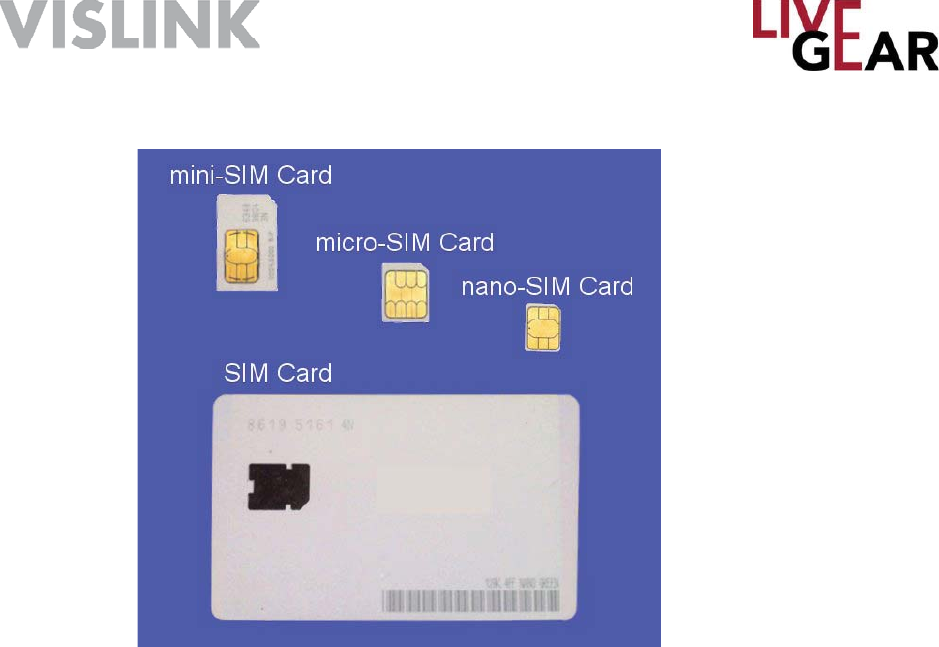
Page 107
NewStream User Guide and Technical Manual
A SIM card contains:
• its unique serial number [ICC ID]
• International Mobile Subscriber Identity [IMSI]
• security authentication and ciphering information
• temporary information related to the local network
• a list of the services the user has access to
• two passwords: a personal identifi cation number [PIN] for ordinary use and a
personal unblocking code [PUK] for PIN unlocking
The primary advantage of cellular wireless data is that you have access to the Internet
from any location, indoors or outdoors, throughout your carrier’s data coverage area. A
disadvantage – as is prevalent with cellular telephones – is that cellular coverage can
be attenuated in remote areas.
Figure A-6: SIM Card Sizes
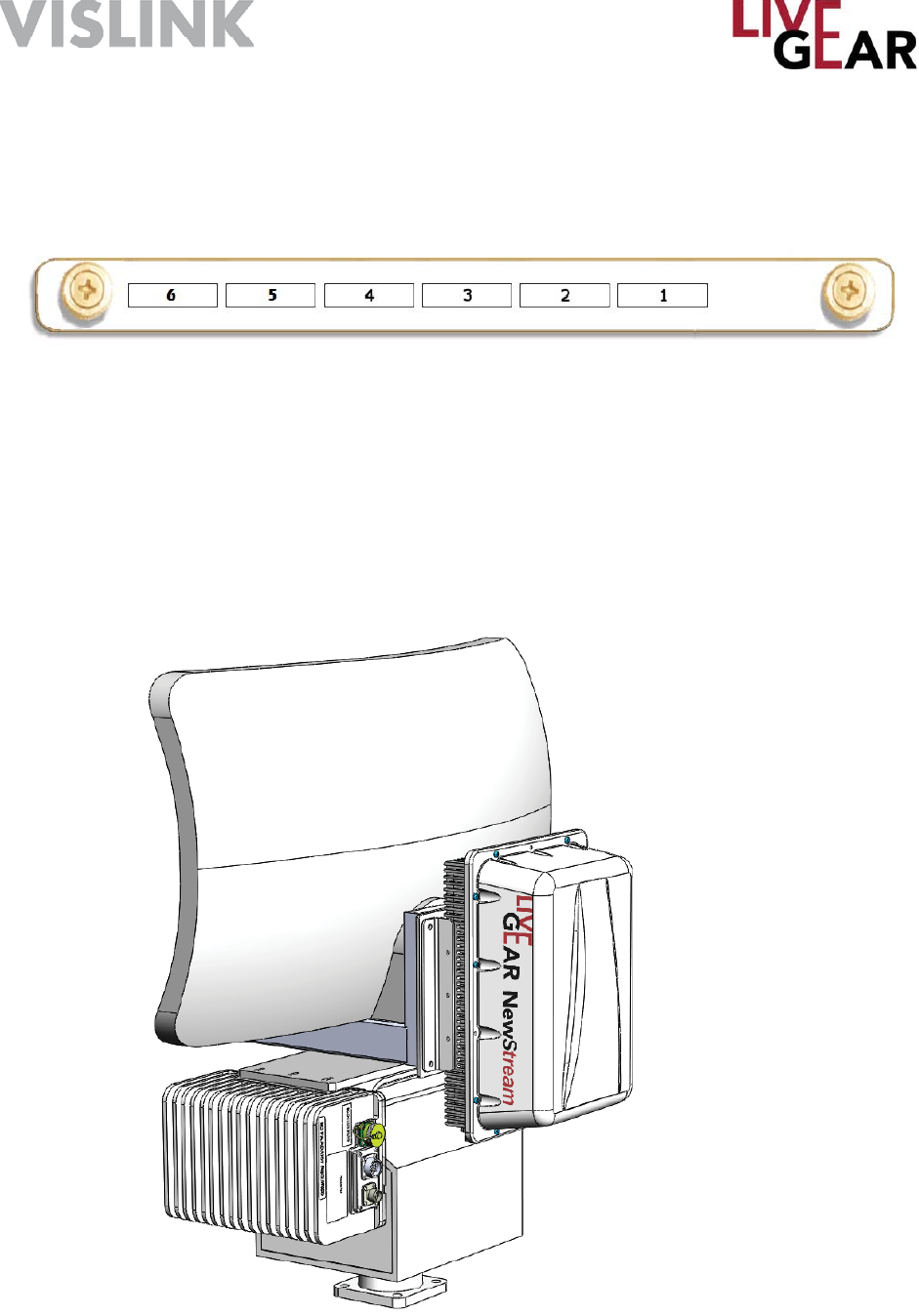
Page 108
Figure A-7: Cellular ODU SIM Card Slots Cover
SIM Installation Slots
The Cellular cards or SIMs, are installed in the ports shown below. Be sure to power
down NewStream before installing or removing SIM cards.
NewStream User Guide and Technical Manual
Cellular ODU Mounting
It is recommended that your NewStream cellular antenna system be installed in a
confi guration similar to that shown in Figure A-8. It must not be mounted in front of or
beside the microwave antenna and to avoid interference, the microwave system must
be powered down before using the cellular equipment. Metallic objects must also be
kept at least one foot [30.5 cm] from the sides of the cellular ODU.
Figure A-8: Recommended Cellular ODU Mounting Confi guration

Page 109
NewStream User Guide and Technical Manual
Glossary
Term Defi nition
1080i 1080i is a standard HDTV video format. 1080 represents 1080 lines of vertical
resolution and the letter i represents “interlaced” or non-progressive scan.
1080i usually assumes a wide screen aspect ratio of 16:9, implying a horizontal
resolution of 1920 pixels and a frame resolution of 1920 x 1080, or 2.07 million
pixels.
16-QAM 16-state Quadrature Amplitude Modulation
The signal [video + audio] is imposed onto the 70 MHz carrier by varying both
the phase and the amplitude of the signal while keeping the frequency constant.
There are 16 possible combinations of phase and amplitude that can be used to
carry information.
3G 3G represents the third generation of mobile telecommunications technology.
3G telecommunication networks support services that provide an information
transfer rate of at least 200 kbit/s.
4G 4G represents the fourth generation of mobile phone mobile communication
technology standards. It is a successor to the third generation [3G] standards.
A 4G system provides mobile ultra-broadband Internet access, for example
to laptops with USB wireless modems, to smartphones, and to other mobile
devices. Conceivable applications include amended mobile web access, IP
telephony, gaming services, high-defi nition mobile TV, video conferencing, 3D
television, and cloud computing.
64-QAM 64-state Quadrature Amplitude Modulation
The signal [video+audio] is imposed onto the 70 MHz carrier by varying both
the phase and the amplitude of the signal while keeping the frequency constant.
There are 64 possible combinations of phase and amplitude that can be used to
carry information.
720p 720 represents 720 lines of vertical resolution and the letter p represents non-
interlaced or progressive scan. When broadcast at 60 frames per second, 720p
features the highest temporal [motion] resolution possible under the ATSC
standard. Progressive scanning reduces the need to prevent fl icker by fi ltering
out fi ne details, so spatial [sharpness] resolution is much closer to 1080i than the
number of scan lines would suggest.
802.11 IEEE 802.11 is a set of medium access control and physical layer specifi cations
for implementing wireless local area network [WLAN] computer communication
in the 2.4, 3.6, 5 and 60 GHz frequency bands.
8-PSK 8-Phase Shift Keying
8-PSK is a digital modulation class that conveys data by changing, or
modulating, the phase of a reference signal or carrier wave.
AAC - LC Advanced Audio Coding - Low Complexity
AAC is a standardized, lossy compression and encoding scheme for digital
audio. Low Complexity [LC] encoding is the simplest and most widely used and
supported.

Page 110
NewStream User Guide and Technical Manual
Term Defi nition
ABR Adaptive Bit-rate
ABR encoding dynamically adjusts an encoder’s output bit-rate to accommodate
available upload speeds across several networks.
Aggregation Aggregation refers to the reconstruction and reordering of separate, packetized,
video transport streams into a single coherent video stream, as the streams
arrive at an IP - addressed destination. As an example, a LiveGear Receiver
aggregates video feed from an NewStream transmitter for decoding. Similarly,
the VMS-1000 also aggregates a video signal for distribution over the Web.
APN Access Point Name
APN is a confi gurable network identifi er used by a mobile device when
connecting to a GSM carrier. The carrier examines the APN identifi er to
determine the network connection type for the NewStream transmitter. The
APN determines which IP addresses should be assigned to NewStream, which
security methods should be used, and how or if, it should be connected to a
private network.
ASI Asynchronous Serial Interface
ASI refers to a streaming data format that often carries an MPEG Transport
Stream. This serial communications interface operates at up to 270 Mbit/sec.
ASI is generally used in fi eld news-gathering operations.
Band [RF] This refers to the RF band to which the AirCam is calibrated. To receive RF
signals an antenna is used by the AirCam with a radio tuner to adjust to a
particular frequency range within the RF band. This tuning is accomplished using
a resonator – a circuit with a capacitor and an inductor forming a tuned circuit.
The resonator amplifi es oscillations within a particular frequency band, while
reducing oscillations at other frequencies outside the band.
BAS Broadcast Auxiliary Service
BER Bit Error Ratio
The Bit Error Rate is the percentage of bits that have errors relative to the total
number of bits in the signal. The rate is an indication of how often a packet or
other data unit has to be retransmitted because of an error.
BISS-1 Basic Inter-operable Scrambling System-1
BISS is a satellite signal scrambling system. BISS-1 transmissions are protected
by a 12 digit hexadecimal session key that is agreed by the transmitting and
receiving parties prior to transmission. The key is entered into both the encoder
and decoder. The key forms part of the encryption of the digital television signal
Any receiver with BISS support and the correct key will be able to decrypt the
signal.

Page 111
NewStream User Guide and Technical Manual
Term Defi nition
BISS-E Basic Inter-operable Scrambling System-Encrypted
BISS-E is an variation of the scrambling system where the decoder has stored
one secure BISS-key entered by for example, the rights-holder. This key is
unknown to the decoder’s user. The user is sent a 16-digit hexadecimal code
which is entered as a session key. This session key is then mathematically
combined internally to calculate a BISS-1 key that can decrypt the signal.
BNC Bayonet lock coaxial connector [Compare to TNC]
Bonding The combination of several cellular network channels together creating single,
virtual high-speed connection.
BUC Block Up-converter
A block up-converter [BUC] is used in the transmission [uplink] of satellite
signals. It converts a band of frequencies from a lower frequency to a higher
frequency. Modern BUCs convert from the L band to Ku band, C band and Ka
band. Older BUCs convert from a 70 MHz intermediate frequency [IF] to Ku
band or C band.
CDMA Modem Code Division Multiple Access Modem
A CDMA Modem uses a digital radio system that transmits streams of bits [PN
codes]. CDMA permits several radios to share the same frequencies. Unlike
TDMA [Time Division Multiple Access], a system used in 2G GSM, all radios
can be active all the time, because network capacity does not directly limit
the number of active radios. CDMA cellular communication standard is most
commonly used in North America.
COFDM Coded Orthogonal Frequency-Division Multiplexing
COFDM is a method of encoding digital data on multiple carrier frequencies.
COFDM is a frequency-division multiplexing [FDM] scheme used as a digital
multi-carrier modulation method. It is deemed coded because of the use of
forward error correction [FEC]. A large number of closely spaced orthogonal
sub-carrier signals are used to carry data on several parallel data streams
or channels. Each sub-carrier is modulated with a conventional modulation
scheme, such as quadrature amplitude modulation or phase-shift keying, at a
low symbol rate, maintaining total data rates similar to conventional single-carrier
modulation schemes in the same bandwidth.
COFDM-based transmitters with diversity receivers use DVB-T, which was
originally designed for high power stationary UHF transmitters fed highly
compressed video by rack mount encoders and stationary domestic receivers.
Composite [Baseband] A band or grouping of frequencies and/or subcarriers, including video, occupied
by the signal in a radio transmission system. Also called Baseband.

Page 112
NewStream User Guide and Technical Manual
Term Defi nition
Decoder Buffer Length The Decoder Buffer Length is the size of the buffer fed to the decoder when
using an audio bitrate_cap, expressed in kbps. The buffer_size divided by
bitrate_cap represents the size of the buffer in milliseconds; so if you set bitrate_
cap to 1000 and buffer_size to 1000, the buffer is effectively 1.0 second. If
bitrate_cap is 500 and buffer_size is 1000, the buffer is 2.0 seconds. This factor
is typically used only for streaming [RTMP or broadcast] video, not for HTTP
delivery of video. Only use this setting if you understand its implications, as it can
decrease video quality. This should typically only be used for streaming [or for
device playback].
DES Data Encryption Standard
DHCP Dynamic Host Confi guration Protocol
A protocol for automating the confi guration of computers that use TCP/IP.
Dynamic Host Confi guration Protocol is a network protocol used to confi gure
network devices to communicate on an IP network.
Internet Protocol addresses are assigned to a host either at the time of booting,
or permanently, by fi xed confi guration of its hardware or software. Persistent
confi guration is also known as using a Static IP address. In contrast, in situations
when the computer’s IP address is assigned newly each time, this is known as
using a dynamic IP address.
Dynamic Host Confi guration Protocol is a network protocol used to confi gure
network devices to communicate on an IP network. A DHCP client uses DHCP
protocol to acquire confi guration information, such as an IP address, a default
route and one or more DNS server addresses from a DHCP server. The DHCP
client then uses this information to confi gure its host. Once the confi guration
process is complete, the host is able to communicate on the Internet.
DNS Domain Name System
A DNS Server hosts a network service for providing responses to queries against
a directory service. It maps a human-recognizable identifi er to a system-internal,
numeric, identifi cation or addressing component. This service is performed
by the server according to a network service protocol. The most important
function of the DNS Server is the translation or resolution of human-memorable
domain names and hostnames into the corresponding numeric Internet Protocol
Addresses.
DVB-T Digital Video Broadcasting - Terrestrial
This system transmits compressed digital audio, digital video and other data
in an MPEG transport stream, using coded orthogonal frequency-division
multiplexing [COFDM or OFDM] modulation. DVB-T offers three different
modulation schemes: QPSK, 16QAM and 64QAM.
FEC Forward Error Correction
A type of digital signal processing in which a transmitter encodes redundant data
bits in a signal and a decoder in a receiver detects any errors and extracts the
original signal.
FTP File Transfer Protocol
A standard Internet protocol commonly used to transfer fi les from the local
computer to a remote web server or to download fi les from a remote server to
the local computer.

Page 113
NewStream User Guide and Technical Manual
Term Defi nition
GOP In MPEG encoding, a Group of Pictures [GOP] specifi es the order in which
intra-frames are arranged. The GOP is a group of successive pictures within an
MPEG-coded fi lm and/or video stream. Each MPEG-coded fi lm and/or video
stream consists of successive groups of pictures.
GSM Modem Global System for Mobile Communications Modem
A GSM Modem is a specialized type of modulator/demodulator that accepts
a SIM [Subscriber Identity Module] card and operates over a subscription
to a mobile operator, as a mobile phone functions. When a GSM modem is
connected to a digital device, it uses the GSM modem to communicate over
the mobile network. While GSM modems are most frequently used to provide
mobile Internet connectivity, many of them can also be used for sending
and receiving SMS [Short Message Service (e.g. text message)] and MMS
[Multimedia Messaging Service] messages.
Guard Interval A method used to prevent interference among distinct transmissions.
H.264 H.264/MPEG-4 Part 10 or AVC [Advanced Video Coding] is a standard for video
compression and is currently one of the most commonly used formats for the
recording, compression and distribution of high defi nition video.
HD High Defi nition [video]
HD-SDI High Defi nition Serial Data Interface
A serial communications interface operating at 1.5 Gbit/sec.
HSDPA High-Speed Data Packet Access
HSPA+ Evolved High-Speed Data Packet Access
IFB Interruptible foldback [IFB], is an intercom cueing system used to monitor and
intercede in television and radio broadcasts, public speaking, fi lm and video
production and other such endeavors.
The IFB intercom circuit consists of a mix-minus program feed sent to a
presenter’s wired or wireless in-ear monitors [IEMs] through a telephone or
radio receiver. This feed can be interrupted and replaced by a producer’s or
director’s intercom microphone. For example, on a television news program, a
producer can talk to the news anchors, to tell them when they are live on the air
and to begin reading the news, or when to take a break.
In electronic news gathering [ENG], IFB transmission can be sent through a
telephone hybrid, the station’s Multi-channel Television Sound [MTS] PRO
channel during live remote broadcasts, or through some other return link in a
broadcast auxiliary service.
All signals arrive on site with a time delay as they travel through a wire, or
during the conversion to radio frequency and then back to electronic audio, or
in the conversion from analog to digital signal and back again to the analog
realm. To achieve the mix-minus program to the IFB, certain audio elements that
originate remotely from the mix point will be eliminated from the mix sent back to
the remote site to avoid an echo.

Page 114
NewStream User Guide and Technical Manual
Term Defi nition
IMEI The International Mobile Station Equipment Identity [IMEI] number is used to
identify 3GPP [i.e., GSM, UMTS and LTE]. The IMEI number is used by the
GSM network to identify valid devices and has no permanent relation to the
subscriber. The subscriber is identifi ed by transmission of an IMSI number;
stored on the SIM card.
IP Address An Internet Protocol [IP] address is a 32-bit number [for example, 123.45.67.89
for IP version 4] or a 128-bit number [for IP version 6] that identifi es the network
device that is sending or receiving information that is transmitted across a local
area network [LAN] or the Internet.
LAN Local Area Network [LAN] is a network that provides data communications
to users within a confi ned geographic area such as a building or complex of
buildings; TCP/IP is the typical transport protocol.
LMS-T Link Modulation Scheme -Terrestrial
This modulation type has been designed specifi cally to allow the data bandwidth
required for contribution with more effi cient error correction and more effective
use of spectrum. LMS-T is particularly suited for rapidly changing channels, so it
can be at the higher frequencies 6,7,8 GHz and at higher speeds, where DVB-T
is compromised. LMS-T has been used at 574km/h [356mph] on the French
TGV, while setting the train speed record.
LQ Link Quality is a feature provided in COFDM receivers that analyzes signal-
to-noise ratio and other important digital signal parameters as supplied by the
COFDM demodulator circuit. The Link Quality feature calculates an integer
value from 0 [no signal] to 9 [highest possible quality].
LTE Long Term Evolution
LTE is a standard for wireless data communications technology and an evolution
of the GSM/UMTS standards. The goal of LTE was to increase the capacity
and speed of wireless data networks using new DSP [digital signal processing]
techniques and modulations that were developed around the turn of the
millennium. A further goal was the redesign and simplifi cation of the network
architecture to an IP-based system with signifi cantly reduced transfer latency
compared to the 3G architecture. The LTE wireless interface is incompatible
with 2G and 3G networks, so that it must be operated on a separate wireless
spectrum.
MAC Address [BSSID] The Media Access Control Address
The MAC Address is a unique identifi er assigned to network interfaces, such
as the NewStream transmitter, for communications on the physical network
segment. A Wi-Fi Access Point’s MAC address is used as the identifi er of
a Basic Service Set [BSSID]. The MAC address of the NewStream IDU is
also the BSSID for the wireless access point. When prompted, NewStream’s
connection information retrieval returns the MAC address and BSSID of the Wi-
Fi client, which is displayed in this fi eld.
MIMO Multiple-Input and Multiple-Output
MPEG Moving Picture Experts Group
A working group of ISO that establishes standards for digital video and audio
compression.

Page 115
NewStream User Guide and Technical Manual
Term Defi nition
NTSC National Television System Committee
Color television standard used in the US. Provides 525 horizontal lines of
resolution. Not compatible with PAL or SECAM.
OFDM Orthogonal frequency-division multiplexing [OFDM] is a method of encoding digital
data on multiple carrier frequencies. OFDM has developed into a popular scheme
for wideband digital communication, whether wireless or over copper wires, used
in applications such as digital television and audio broadcasting, DSL Internet
access, wireless networks, powerline networks, and 4G mobile communications.
OFDM is a frequency-division multiplexing [FDM] scheme used as a digital
multi-carrier modulation method. A large number of closely spaced orthogonal
sub-carrier signals are used to carry data on several parallel data streams or
channels. Each sub-carrier is modulated with a conventional modulation scheme
[such as quadrature amplitude modulation or phase-shift keying] at a low symbol
rate, maintaining total data rates similar to conventional single-carrier modulation
schemes in the same bandwidth.
The primary advantage of OFDM over single-carrier schemes is its ability to cope
with severe channel conditions [for example, attenuation of high frequencies in a
long copper wire, narrowband interference and frequency-selective fading due to
multipath] without complex equalization fi lters. Channel equalization is simplifi ed
because OFDM may be viewed as using many slowly modulated narrowband
signals rather than one rapidly modulated wideband signal. The low symbol rate
makes the use of a guard interval between symbols affordable, making it possible
to eliminate intersymbol interference [ISI] and utilize echoes and time-spreading
[on analogue TV these are visible as ghosting and blurring, respectively] to
achieve a diversity gain, i.e. a signal-to-noise ratio improvement. This mechanism
also facilitates the design of single frequency networks [SFNs], where several
adjacent transmitters send the same signal simultaneously at the same frequency,
as the signals from multiple distant transmitters may be combined constructively,
rather than interfering as would typically occur in a traditional single-carrier
system.
PAL Phase Alternation Line
Color television standard used in many European countries. Provides 625
horizontal lines of resolution. Not compatible with NTSC or SECAM.
PCM Pulse-Code Modulation
PCM is a method used to digitally represent sampled analog signals. It is the
standard form of audio in digital applications. The amplitude of the analog signal
is sampled regularly at uniform intervals; each sample is quantized to the nearest
value within a range of digital steps. PCM streams have two basic properties that
determine their fi delity to the original analog signal:
• the sampling rate,
• the number of times per second that samples are taken;
• the bit depth, which determines the number of possible digital values that
each sample can take.

Page 116
NewStream User Guide and Technical Manual
Term Defi nition
PCR Program Clock Reference
To enable a decoder to present synchronized content, such as audio tracks
matching the associated video, at least once each 100 millisecond, a Program
Clock Reference [PCR] is transmitted in the adaptation fi eld of an MPEG-
2 transport stream packet. The PID with the PCR for an MPEG-2 program
is identifi ed by the PCR_PID value in the associated Program Map Table.
The value of the PCR is employed to generate a system_timing_clock in the
decoder. The STC or System Time Clock decoder provides a highly accurate
time base that is used to synchronize audio and video elementary streams.
Timing in MPEG2 uses this clock as a reference.
PES Packetized Elementary Stream
PES is a specifi cation in the MPEG-2 parameter that defi nes carrying of
elementary streams [usually the output of an audio or video encoder] in
packets within MPEG program stream and MPEG transport stream. The
elementary stream is packetized by encapsulating sequential data bytes from
the elementary stream inside PES packet headers.
PID Packet ID
Each table or elementary stream in a transport stream is identifi ed by a 13-
bit packet ID [PID]. A demultiplexer extracts elementary streams from the
transport stream in part by looking for packets identifi ed by the same PID. In
most applications, time-division multiplexing is used to decide how often a
particular PID appears in the transport stream.
PMT Program Map Table
A PMT contains information about programs. For each program, there is one
PMT. While the MPEG-2 standard permits more than one PMT section to be
transmitted on a single PID, most MPEG-2 users such as ATSC and SCTE
require each PMT to be transmitted on a separate PID that is not used for
any other packets. The PMTs provide information on each program present in
the transport stream, including the program_number, and list the elementary
streams that comprise the described MPEG-2 program. There are also
locations for optional descriptors that describe the entire MPEG-2 program, as
well as an optional descriptor for each elementary stream. Each elementary
stream is labeled with a stream_type value.
QPSK Quadrature Phase-Shift Keying
Phase-shift keying [PSK] is a digital modulation scheme that conveys data
by changing, or modulating, the phase of a reference signal or carrier wave.
Quadrature Phase-Shift Keying [QPSK] transmits twice the data rate in a
given bandwidth compared to Binary Phase-Shift Keying [BPSK] - at the
same Bit Error Rate [BER]. The engineering penalty that is paid is that QPSK
transmitters and receivers are more complicated than the ones for BPSK.
However, with modern electronics technology, the penalty in cost is very
moderate. QPSK is also known as 4 - QAM.
Roll-off Roll-off describes the steepness of a transmission function with frequency, in
connection with fi lter circuits in the transition between a passband and a stop
band. It is most typically applied to the insertion loss of the network. It is usual
to measure roll-off as a function of logarithmic frequency, consequently, the
units of roll-off are either decibels per decade [dB/decade], where a decade is
a 10-times increase in frequency, or decibels per octave [dB/8ve], where an
octave is 2-times increase in frequency.

Page 117
NewStream User Guide and Technical Manual
Term Defi nition
Roll-off [Continued] The concept of roll-off stems from the fact that in many networks roll-off
tends towards a constant gradient at frequencies well away from the cut-off
point of the frequency curve. Roll-off enables the cut-off performance of such
a fi lter network to be reduced to a single number. Note that roll-off can occur
with decreasing frequency as well as increasing frequency, depending on the
band form of the fi lter being considered. For instance, a low-pass fi lter will
roll-off with increasing frequency, but a high-pass fi lter or the lower stop band
of a band-pass fi lter, will roll-off with decreasing frequency.
RSSI Receiver Signal Strength Indicator [relative]
This parameter provides each cellular card’s or Wi-Fi Access Point’s RSSI.
The RSSI is the relative received signal strength in arbitrary units. RSSI is an
indication of the power level being received by the antenna. The higher the
RSSI number, the stronger the signal.
SCM-Q Superposition Coded Modulation - Quadrature
SCM-Q is a modulation scheme designed to use the bandwidth effi cient
codec, such as H.264, enabling the transfer of the same video quality at up
to twice the distance, with a greatly improved Peak-to-Average-Power-Ratio
[PAPR]. SCM-Q has variable bandwidth so can also be used for channel
sharing.
SDI Serial Digital Interface
A serial communications interface operating at 270 Mbit/sec. SDI can
operate at 1.5 Gbit/sec for HD.
SIM Card Subscriber Identity Module Card
A SIM is an integrated circuit that stores the International Mobile Subscriber
Identity [IMSI] and key used to identify and authenticate subscribers on
mobile telephony devices. A SIM card contains:
• its unique serial number [ICC ID]
• International Mobile Subscriber Identity [IMSI]
• security authentication and ciphering information
• temporary information related to the local network
• a list of the services the user has access to
• two passwords: a personal identifi cation number [PIN] for ordinary
use and a personal unblocking code [PUK] for PIN unlocking
The primary advantage of cellular wireless data is that you have access
to the Internet from any location, indoors or outdoors, throughout your
carrier’s data coverage area. A disadvantage – as is prevalent with cellular
telephones – is that cellular coverage can be attenuated indoors, as well as
in remote areas.
SMPTE Society of Motion Picture and Television Engineers
SNR Signal-to-Noise Ratio
A measure of signal strength and quality that is defi ned as the ratio of the
amplitude of a signal compared to the amplitude of the background noise.
SNR is typically measured in decibels [dB].

Page 118 NewStream User Guide and Technical Manual
Term Defi nition
SSID Service Set Identifi er
The SSID is a case-sensitive, alphanumeric, 32 - character unique identifi er
attached to the header of packets sent over a wireless local-area network
[WLAN] that acts as a password when a mobile device attempts to connect
with a Basic Service Set [BSS] which is a component of the IEEE 802.11
WLAN architecture. An SSID is also referred to as a Network Name because
essentially it is a name that identifi es a wireless network.
The SSID differentiates one WLAN from another, so all Access Points and all
devices attempting to connect to a specifi c WLAN must use the same SSID
to enable effective roaming. As part of this association process, a wireless
client must have the same SSID as that entered in the Access Point or it will
not be permitted to join the BSS.
Subnet Mask A sub-network, or subnet, is a logically visible subdivision of an IP Network.
All computers that belong to a subnet are addressed with a common,
identical, most-signifi cant bit-group in their IP address. This results in the
logical division of an IP address into two fi elds: a network or routing prefi x
and the rest fi eld or host identifi er. The rest fi eld is an identifi er for a specifi c
host or network interface. Special gateways called routers exchange traffi c
between sub-networks. Such routers constitute the logical or physical
boundaries between the subnets.
Symbol Rate Symbol Rate [aka baud or modulation rate] is the number of symbol changes
[i.e. waveform changes or signalling events] made to the transmission
medium per second using a digitally modulated signal or a line code. The
Symbol rate is measured in baud [Bd] or symbols/second. In the case of a
line code, the symbol rate is the pulse rate in pulses/second. Each symbol
can represent or convey one or several bits of data. The symbol rate is
related to, but should not be confused with, the gross bitrate expressed in
bits/second.
TCP/IP Transmission Control Protocol/Internet Protocol
Transmission Control Protocol is a connection-oriented Internet protocol
requiring synchronization between the end units [source and destination] for
handshaking purposes for guaranteed message delivery that is transmitted
over the Internet Protocol, which is the low-level protocol of most internet
hardware
TNC Threaded Neill–Concelman
A TNC connector is a threaded version of the BNC connector. The connector
has a 50 Ω impedance and operates best in the 0 to 11 GHz frequency
spectrum. It has better performance than the BNC connector at microwave
frequencies.
WAN Wide Area Network
A network provided by telephone and cell phone companies to provide data
communications to users over a large geographic area.
WLAN Wireless [Wi-Fi] Local Area Network
A Wireless Local Area Network links two or more devices using some
wireless distribution method and usually providing a connection through an
access point to the wider Internet. This provides the mobility to move around
within a local coverage area and still be connected to the network. Most
modern WLANs are based on IEEE 802.11 standards, marketed under the
Wi-Fi brand name.

Page 119
NewStream User Guide and Technical Manual
Notes
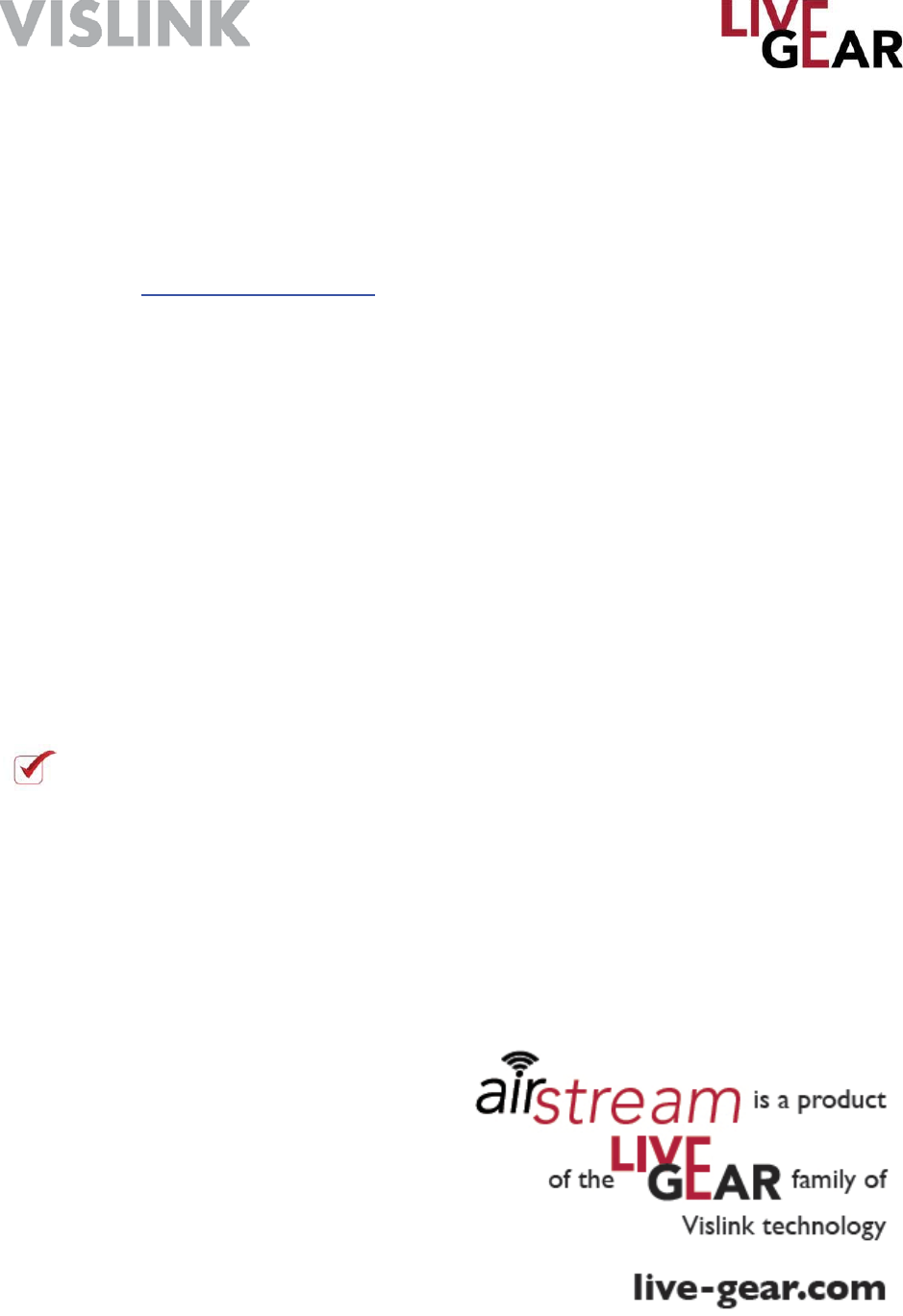
Page 120
NewStream User Guide and Technical Manual
Support for Your Vislink Product
You can contact the Vislink Technical Support staff as follows:
24-hour Worldwide Customer Support
E-mail: ussupport@vislink.com
Telephone: +1 978-671-5929, +1 978-671-5995 or
888-777-9221 In the US or Canada
The following contact numbers are also available for LiveGear equipment:
• 978.671.5700 Press #3
• 800.490.5700 Press #3
When you contact Technical Support, include the following information:
Model number and serial number of the unit [located on a label on the units].
Approximate purchase date.
There are no supported fi eld repairs for this product. Return the unit for factory
repair.
NOTE: If you attempt fi eld repair, you risk damaging your equipment. If your
equipment is under warranty, you may also affect your warranty coverage.